
Problem Solving for Kids: How-To Guide, Activities & Strategies
Children need to be able to solve their own problems. In daily life, kids face a lot of set of social circumstances and challenges. Whether they’re trying to figure out how to make friends, deal with bullies, or solve academic problems, they need strong problem-solving skills to be successful.
Problem-solving is a critical life skill that all kids need to learn. By teaching them how to identify and solve problems on their own, you’ll be setting them up for success in school and in life.
What are Social Problem-Solving Skills?
Social problem-solving skills are a skill set that involves behavioral and cognitive processes which allow an individual to find adaptive and positive ways of handling problematic situations that can arise in the social environment in our daily life. These skills comprise an understanding of emotions, empathy, self-awareness, prosocial behavior, anger management, perspective-taking, establishing positive relationships, and so on.
Why It’s Important for Children to Learn the Skills to Problem-Solve
Social problem-solving skills are important for kids to learn because they allow them to cope with the various challenges they face in their social environments, such as peer pressure, bullying, and exclusion from social groups. In addition, these skills can help them resolve conflicts effectively and build positive relationships with others.
How to teach Problem-Solving skills
There are many ways to develop social problem-solving skills in kids . One way is to provide them with opportunities to practice these skills through different activities and games.
There are a few key things that parents and educators can do to help kids develop strong problem-solving skills:
Teach Children to Identify the Problem
One of the most important steps in solving any problem is being able to accurately identify what the problem is. This can be tricky for kids, especially if they’re feeling emotional about the situation. Help them by teaching them how to take a step back and look at the problem objectively.
Help Kids Brainstorm Solutions
Once kids can identify the problem, it’s time to start brainstorming possible solutions. This is where creativity and out-of-the-box thinking come in handy. Encourage kids to think of as many possible solutions as they can, no matter how far-fetched they might seem.
Help Kids Weigh the Pros and Cons
After Children can come up with a few potential solutions, it’s time to help them figure out which one is the best option. This is where critical thinking comes in. Teach kids how to weigh the pros and cons of each solution and make a decision based on logic, not emotions.
Help Kids Implement the Solution
The final step is helping kids actually implement the solution they’ve chosen. This might involve role-playing different scenarios, practicing what they would say or do, or writing out a plan. Whatever the case, be sure to provide support and guidance every step of the way.
Praise Kids
It’s essential to praise your child when they demonstrate social problem-solving skills. This will help him feel confident in his abilities and encourage him to continue using these skills.
Also, proper guidance and opportunities to practice problem-solving skills should be provided for kids to be efficient enough to solve problems on their own. In addition to providing opportunities for practice, it is also important to model problem-solving skills for your child.
By following these tips, you can help your child develop strong social problem-solving skills that will serve him well throughout his life.
Problem-solving in Child Development
Most children go through similar phases of problem-solving as they develop. However, the timing may vary depending on the child’s individual temperament and circumstances.
Here are some common milestones:
- Ages 2-3: During the age of 2-3 years, kids begin to understand that problems can be solved. They also start to develop a sense of self-control and can begin to use words to express their emotions.
- Ages 3-4: By 3-4 years old, kids are usually better at problem-solving and can use more logical thinking. They’re also beginning to understand other people’s feelings and perspectives.
- Ages 4-5: Around 4-5 years old, kids can usually think of multiple solutions to a problem. They’re also starting to understand the concept of cause and effect.
- Ages 5-6: By 5-6 years old, most kids can apply problem-solving skills in their everyday lives. They’re also able to understand complex emotions and empathize with others.
- Ages 6-7: Around 6-7 years old, kids are usually able to understand even more complex emotions. They’re also starting to see the world from other people’s perspectives and can use this knowledge to solve problems.
- Ages 7-8: By 7-8 years old, kids are often able to solve problems quickly and efficiently. They’re also able to think abstractly and see the world from multiple perspectives.
- Ages 8-9: Around 8-9 years old, kids are usually able to solve problems independently. They’re also beginning to understand the concept of time and how it can be used to solve problems.
- Ages 9-10: By 9-10 years old, kids are often able to solve complex problems. They’re also able to think abstractly and see the world from multiple perspectives.
- Ages 10-11: Around 10-11 years old, kids are usually able to solve problems independently. They’re also beginning to understand the concept of time and how it can be used to solve problems.
- Ages 11-12: By 11-12 years old, kids are often able to solve complex problems. They’re also able to think abstractly and see the world from multiple perspectives.
- Ages 12-13: Around 12-13 years old, kids are usually able to solve problems independently. They’re also beginning to understand the concept of time and how it can be used to solve problems.
As children get older, they should be able to solve more complex problems. If you’re concerned about your child’s problem-solving abilities, talk to their doctor or a child development specialist.
Social Problem-Solving Strategies
There are several strategies that can help children of primary age to solve problems. Some of them are as follows:
- Encouraging children to take turns and share. This strategy helps children to be more patient and to understand that other people have feelings too. It also allows them to share their own feelings and thoughts more openly.
- Helping children to understand and express their emotions. This strategy helps children to identify and understand their own emotions , as well as the emotions of others. It also allows them to express their emotions in a more positive way.
- Teaching children how to compromise. This strategy helps children to understand that sometimes it is necessary to give up something in order to get something else. It also teaches them how to negotiate and how to reach an agreement with others.
- Encouraging children to think about other people’s perspectives. This strategy helps children to understand that other people have different points of view. It also allows them to see the world from another person’s perspective and to empathize with others.
- Helping children to understand and follow rules. This strategy helps children to understand that there are certain rules that must be followed in order to maintain order and peace. It also teaches them how to respect the rules of others.
- Teaching children how to improve their skills to problem-solve. This strategy helps children to understand that there are many ways to solve a problem. It also teaches them how to think creatively and to come up with their own solutions.
These are just a few of the social problem-solving strategies that can help children of primary age to solve problems. For more information, please talk to your child’s doctor or a child development specialist.
Social Problem-Solving Skills Activities
Games and activities for socialization are an excellent way for children for learning how to behave in social surroundings such as school or in the community.
It is essential for children to learn how to take turns, share, cooperate and resolve conflicts.
Here are some activities to improve social problem-solving skills for children of different age groups:
Social Problem-solving Activities for Preschoolers
Preschoolers are very young and need a lot of help to learn social problem-solving skills. The following activities are fun and will help them develop problem-solving skills.
- Circle Time: This is a great activity for kids to learn how to take turns and share. Give each child a turn to be in the center of the circle and share something about themselves such as their favorite color, food , animal, etc.
- Simon Says: This classic game is a great way for kids to listen and follow instructions. It also helps with problem-solving skills as they have to figure out what Simon is saying.
- Role-Playing: This is a great activity for kids to learn how to resolve conflicts. Have kids act out different scenarios such as sharing toys or taking turns. After each scene, discuss what happened and how the conflict could have been resolved.
Social Problem-solving Activities for Kindergarteners
Kindergarteners are still very young. So, they may need assistance when it comes to social problem-solving skills.
The following activities will give them a chance to practice these skills in a safe and fun environment.
- Cooperative Building: Have the kids work together in small groups to build towers or houses out of blocks or Legos. This activity will help them learn to share, take turns, and cooperate with others.
- Role-Playing: Act out different social situations with puppets or toys. For example, one child can be the customer in a store and the other children can take turns being the salesperson. This activity will help kids learn how to handle different social situations.
- Feelings Matching: Cut out pictures of people with different facial expressions from magazines or newspapers. Ask the kids to match the pictures with the corresponding feeling words (e.g., happy, sad, mad, etc.). This activity will help kids learn to identify and understand different emotions.
Social Problem-solving Activities for School-Aged Kids
As kids get older, they become more independent and are able to handle more complex social situations.
The following activities will help them practice their social problem-solving skills.
- Brainstorming: This activity can be done individually or in a group. Give your child a scenario and have them come up with as many solutions as possible. For example, “Your best friend just cancelled your play date. What are three things you could do?”
- Exercising empathy: It’s important for kids to be able to empathize with others and see things from their perspective. When they’re struggling to solve a problem, help them think about how the other person is feeling. For example, “Your friend might be feeling upset too. Maybe you can talk to her about why she cancelled the play date.
- Problem Solving Games: Games are a fun way to teach children the skills of solving problems. Try playing some classic board games like Chutes and Ladders or Candyland, which require players to make decisions and strategize. There are also many great online games, like Mission to Mars and Robot City, that help kids practice problem-solving.
- Discussing Problem-Solving Skills: As a family, discuss different problem-solving strategies. For example, “If you’re ever feeling overwhelmed or don’t know what to do, take a deep breath and think about what would be the best thing to do in that situation.”
- Model Good Problem-Solving Skills: As a parent, you are your child’s biggest role model. So, it’s important to model good problem-solving skills yourself. Whenever you’re faced with a problem, talk aloud about how you’re going to solve it. For example, “I’m having trouble finding my keys. I think I’ll check the couch first and then look in the car.”
- Encourage positive thinking: Help your child look on the bright side by encouraging them to think of the positive outcomes of a situation. For example, “Even though your play date was cancelled, you now have some free time to do something else you enjoy.
- Practice: It’s important to give kids opportunities to use their problem-solving skills in everyday life. When they’re faced with a social challenge, take a step back and let them try to figure it out on their own. Of course, be there to support them if they need help.
Social Problem-solving Activities for High-School Students
High-school students often face a variety of social problems. They may have difficulty making friends, fitting in with classmates, or dealing with bullies.
Some students may also struggle with more serious issues, such as gangs, drugs, or violence.
There are a number of activities that can be used to help high-school students with improving their social problem-solving skills. These are as follows:
- Peer Mediation: This activity involves two or more students who are in conflict with each other. The mediator(s) helps the students to communicate with each other and find a resolution to the problem.
- Role-Playing: This is a great activity for helping high-school students to understand different perspectives. Students can take on the role of the person they are in conflict with, and then discuss how they would feel in that situation.
- Problem-Solving Groups: These groups usually consist of 4-6 students who meet to discuss a particular problem. The group leader(s) helps the students to brainstorm solutions and come up with a plan of action.
- Attending Debates: Debates can be a great way for high-school students to learn about different perspectives on social issues. Students can also practice their own argumentative and problem-solving skills by participating in debates.
- Service Learning: This is a type of community service that helps high-school students to understand and address social problems. Students typically work with organizations that focus on issues such as poverty, homelessness, or hunger.
Cultivating Resilience in Children
Developing resilience in children is a key aspect of nurturing their emotional health and equipping them to face life’s challenges head-on. It involves helping them understand that difficulties and setbacks are a normal part of life, and they can grow stronger from overcoming them.
By fostering a secure and loving environment, and by being role models of resilience ourselves, we can instill in children the ability to adapt to change and cope with stress.
One effective method to cultivate resilience in children is by encouraging them to express their feelings and thoughts openly.
Providing a safe space where they feel heard and understood helps them to understand their emotions better, which is a crucial step in resilience building. It’s important to validate their feelings, not minimize them, as it teaches them that it’s normal to experience different emotions, and it’s okay to discuss them.
Another significant way to build resilience is by teaching problem-solving skills. Guiding children through the process of identifying a problem, brainstorming possible solutions, choosing the best one, and reflecting on the outcome can equip them with valuable life skills.
As they practice, they will become more adept at facing challenges, whether big or small, and this boosts their confidence and self-efficacy. The beauty of resilience is that it isn’t an inherent trait; it’s a skill that can be learned and cultivated, one challenge at a time.
Teaching social problem-solving skills can help high-school students learn how to handle these types of situations. These skills can also help them in other areas of their lives, such as dealing with family conflict or managing their emotions.
Through these activities, high-school students can learn important problem-solving skills that will help them in their everyday lives.
There are many different activities that you can do to help your child develop problem-solving skills. Choose activities that are appropriate for your child’s age and interests.
And, most importantly, have fun!
Tips, D. (2022). Developing Problem-Solving Skills for Kids | Strategies & Tips | Kodable Blog. Retrieved 6 June 2022, from https://www.kodable.com/learn/problem-solving-skills-for-kids/
How to Teach Problem-Solving Skills to Children and Preteens. (2022). Retrieved 6 June 2022, from https://biglifejournal.com/blogs/blog/how-teach-problem-solving-strategies-kids-guide#:~:text=Allow%20your%20child%20to%20choose,the%20process%20of%20problem%2Dsolving .
Teaching Kids How to Solve Their Own Problems and Make Good Decisions. (2022). Retrieved 6 June 2022, from https://www.verywellfamily.com/teach-kids-problem-solving-skills-1095015
(2022). Retrieved 6 June 2022, from https://www.werockthespectrumkidsgym.com/social-skills-activities-that-teach-kids-problem-solving/
srivastava, m., & srivastava, m. (2022). 12 Problem-Solving Activities For Toddlers And Preschoolers. Retrieved 6 June 2022, from https://www.momjunction.com/articles/problem-solving-activities-for-toddlers_00795607/
20 Evidence-Based Social Skills Activities and Games for Kids. (2022). Retrieved 6 June 2022, from https://www.positiveaction.net/blog/social-skills-activities-and-games-for-kids
The ReadyKids App is an innovative platform that makes Occupational Therapy affordable, accessible, and fun.
With daily resource recommendations, this intuitive app combines efficacy and fun in children's therapy.
- Developed By Registered Occupational Therapists
- New Resources Released Weekly
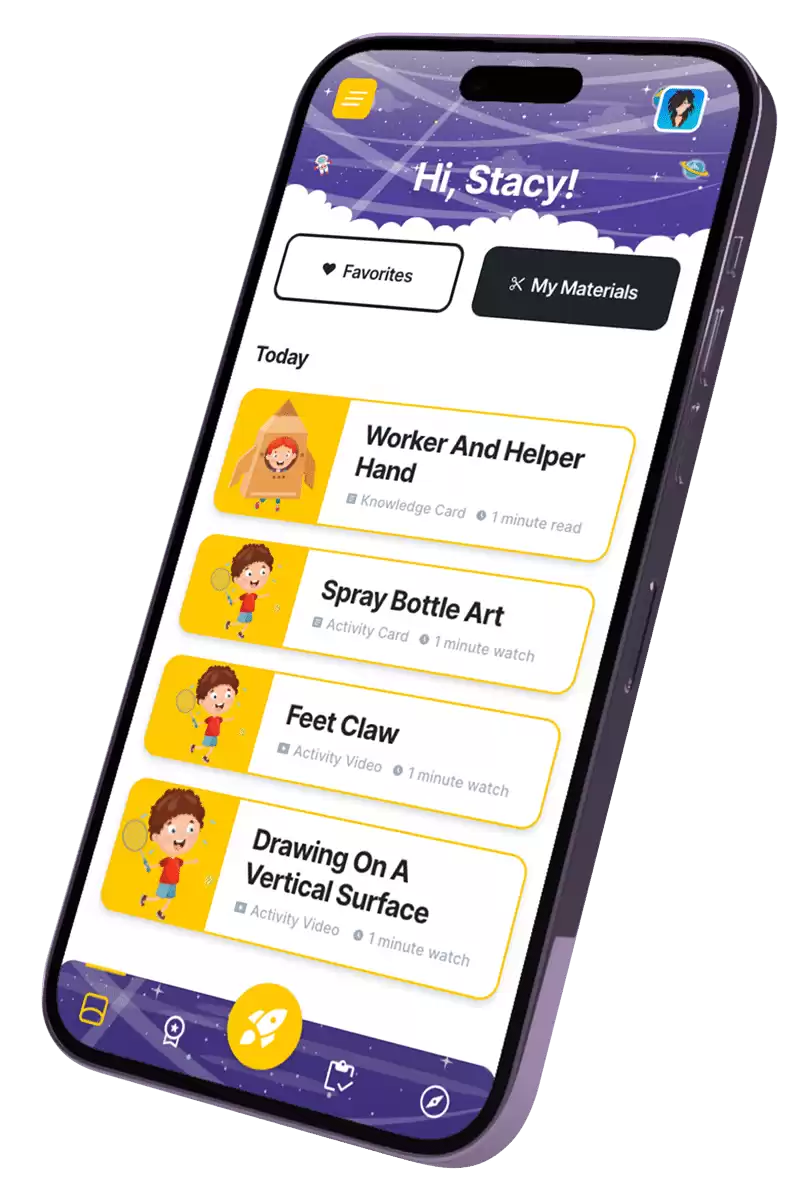
Share This Post
More To Explore

What Are Social Stories? (Benefits for Children with Autism)

Fun & Educational Tongue Twisters for Kids – Improve Speech Skills
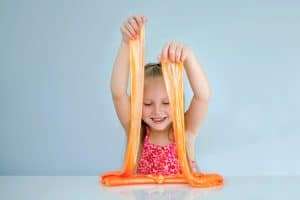
Educational Guide: How to Get Slime Out of Clothes – Occupational Therapy Tips
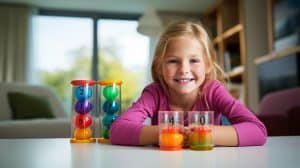
11 Best Visual Timers for Kids With Autism
Sign up to our.
2 Week Parent Support Program
Calling all overwhelmed parents of children with additional needs! Our two-week Parent Support Program is here to provide you with the tools and support you need. Don’t wait, give your child the exceptional care they deserve. Enrol in our program now!
- 1:1 session with a Registered OT (Valued @ $110)
- Interactive Q & A Session (Valued @ $193)
- Access to VIP Community (Can't be valued)
- Customised 2-week plan (Valued @ $110)
Total Value of $413
Today's Price: FREE
Still Need Help?
The readykids app helps kids develop skills at home.
- Math for Kids
- Parenting Resources
- ELA for Kids
- Teaching Resources

How to Teach Number Formation in 5 Easy Steps
13 Best Resources for Math Videos for Kids: Math Made Fun
How to Teach Skip Counting to Kids in 9 Easy Steps
10 Best Math Intervention Strategies for Struggling Students
How to Teach Division to Kids in 11 Easy Steps
How to Cope With Test Anxiety in 12 Easy Ways
Developmental Milestones for 4 Year Olds: The Ultimate Guide
Simple & Stress-Free After School Schedule for Kids of All Ages
When Do Kids Start Preschool: Age & Readiness Skills
Kindergarten Readiness Checklist: A Guide for Parents
How to Teach Letter Formtaion to Kids in 9 Easy Steps
15 Best Literacy Activities for Preschoolers in 2024
12 Best Poems About Teachers Who Change Lives
6 Effective Ways to Improve Writing Skills
40 Four Letter Words That Start With A
13 Best Online Teaching Tips for Teachers
How to Teach Kids to Write in 9 Easy Steps
13 Challenges for Teachers and How to Address Them
12 Best Qualities of a Good Teacher
15 Best Innovative Tech Tools for Teachers
15 Best Problem Solving Activities: Foster Critical Thinking
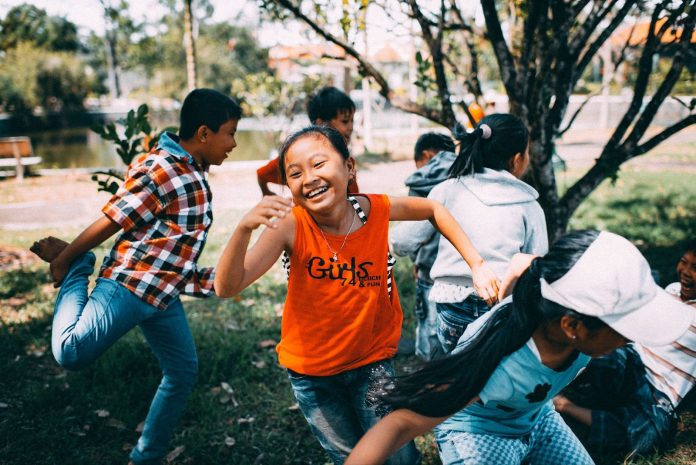
1. Rolling Dice
2. build a tower, 3. tic tac toe, 4. scavenger hunt, 6. activity books, 7. board games, 9. human knot, 10. open-ended questions.
Problem solving activities for kids are a great way to teach them how to think critically and creatively, and how to develop a growth mindset . We’re sure you must have also played many educational games as a kid that helped you develop critical thinking or problem-solving- skills you’re using even today. These activities can be tailored to be fun and engaging, and they help kids understand that challenges and difficulties are opportunities to learn and grow instead of things to be feared.
By providing kids with problem-solving activities, we can give them the tools to develop their problem-solving skills and build the confidence to tackle difficult challenges, which will be valuable to them throughout their life. It will also help them understand that their abilities can be developed with practice and hard work, encouraging them to persevere through difficult tasks and not give up easily when faced with obstacles. If you’re looking for some fun and engaging problem solving activities for children to develop a growth mindset, we have curated a list of activities for you.
SplashLearn: Most Comprehensive Learning Program for PreK-5

SplashLearn inspires lifelong curiosity with its game-based PreK-5 learning program loved by over 40 million children. With over 4,000 fun games and activities, it’s the perfect balance of learning and play for your little one.
15 Best Problem Solving Activities for Kids
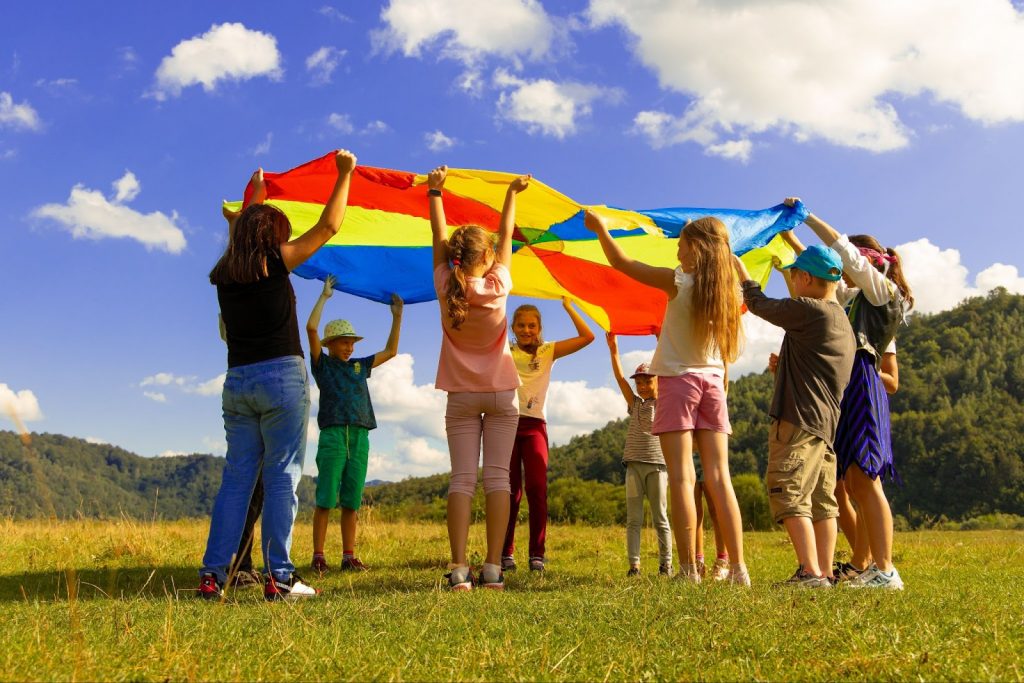
Things you’ll need: A die or dice, some flashcards and a pen
How to do: You can play tons of different games with dice. Playing with two dice encourages kids to quickly add up numbers and learn math in a fun way . One fun game you can play with a single die involves flashcards. For this game, you can assign a category to each number on the die and when the kid rolls the die, they have to name any 3 examples from the category assigned to the number rolled. For example, if number 4 is assigned to animals and it is rolled, they will have to name any 3 animals.
Things you’ll need: Building blocks, lego, toilet rolls or anything that can be stacked
How to do: If you’re looking for problem solving activities for 5 year olds, this is for you. To play this game, just give the kids anything that can be stacked on top of the other. This can be building blocks, lego, Jenga blocks, toilet rolls, etc. The challenge is to stack one on top of the other and see how high a tower they can build. This game can be played in teams or individually as well.
Things you’ll need: A tic tac tow board or pen and paper
How to do: This is one of the most exciting problem solving fun activities for students. You can either play this game on a tic tac toe board or on paper. If you’re playing it on paper, draw a table so that you have 9 boxes. Now each player must choose X or O and try to make a continuous row of their chosen symbol. Whoever succeeds wins.
Things you’ll need: Small toys, stationery items, or anything you want to include in a scavenger hunt
How to do: Assign the teams or individual players specific items they have to find in a defined area. This can be an indoor or outdoor activity for kids . Give them a list of the things they need to find, and you can also give them hints on where to find these things. Whoever or whichever team finds all the things first wins.
Things you’ll need: A puzzle game
How to do: Get a puzzle set. This can be a regular cardboard puzzle or a wooden puzzle and ask the players or teams to arrange it. You can make this a timed challenge or just let the kids solve the puzzle in their own time and have fun.
Things you’ll need: Activity books and pencils
How to do: This is one of the best problem solving activities for kids. Activity books are great for children’s problem-solving skills to develop. Buy them activity books containing games like find the element, what’s wrong with the pictures, or hidden picture books.
Things you’ll need: Board games like Ludo, Snakes and Ladders, Monopoly Junior, and Go Fish
How to do: Give them board games like Ludo, Snakes and Ladders, Monopoly Junior, Go Fish, etc. These board games help kids to develop logic, think deeper, plan ahead and solve problems.
Things you’ll need: A chalk
How to do: Build a maze with chalk on the sidewalk. Make sure you add a few dead-end ways to make it more challenging for the kids. Once the kid is able to walk through and come out of the maze, take the game to the next level by adding even more dead-end ways and see how they overcome the challenge.
Things you’ll need: Just a playground or garden
How to do: This is a great group activity for kids that’ll also teach them lots of skills. Ask the kids to form a circle and raise their right arm up. Now ask them to reach out to someone standing opposite to them in the circle and hold their left hand with their left hand. Now ask them to raise their left hands up and repeat the process with their right hands. The objective is to entangle them completely and then ask them to detangle themselves without letting go of anyone’s hands.
Things you’ll need: Pen and paper
How to do: Once you’re done with an activity, ask kids open-ended questions. These are questions that have no right or wrong answers. Some examples of such questions are- “Did you find this activity easy?”, “What did you enjoy the most about this activity?”, “How would you make this activity more fun?”, etc.
11. Wool Web
Things you’ll need: Balls of yarn
How to do: This is one of the most exciting group problem solving classroom activities for kids . Divide the players into equal teams and ask them to form a circle. Hand them over one ball of yarn each and ask them to make a web of it amongst the teams. Set a time limit for this step, and once it is done, switch the webs so that none of the teams has their own webs. Now the teams will decide on one player from each team to be blindfolded. This blindfolded player will have to untangle to web assigned to their team with the help of verbal instructions from their teams. The team that untangles the web first wins.
12. Fingertip Hula Hoop
Things you’ll need: Hula hoops
How to do: Divide the kids into teams of 6-8 for this game. Each team will stand in a circle and then be asked to raise their hands up. Now, place a hula hoop on top of their fingertips and ask them to bring it down slowly and make it touch the ground without it falling down or leaving the fingertips. The team to finish the task first wins.
13. Obstacle Course
Things you’ll need: Pillows, blankets, mattresses, cones, balls, chairs, etc.
How to do: Build an obstacle course indoors or outdoors with whatever you can find. This makes for one of the most engaging problem solving games for kids. Ask your kids to cross the obstacle course as fast as they can. To make it a bit more challenging, you can also ask them to race against each other to cross the obstacle course.
14. Memory Games
Things you’ll need: Playing cards
How to do: For this fun cards game, place all the cards face down and take turns to turn 2-4 cards. If you are able to open two similar cards (in number), you get to keep the pair. The player with the highest number of cards with them in the end wins.
15. Impromptu Plays
Things you’ll need: A stage
How to do: This is one of the best problem-solving exercises for kids to play in groups. If you have a large group, divide the kids into teams of 6-8. If the group is smaller, just make the kids stand individually. Now make a few chits on a theme that has questions that form a difficult situation or a challenge. For example, you can put in chits with questions like “You just found your friend cheating in an exam. What do you tell them?” or “Your younger sibling just broke your favorite toy. How do you react?”. Each team must enact a scene that includes the situation their chit has. If the group isn’t that big, each kid must speak about the same chit but have different perspectives.
Why Are Problem Solving Skills Important for Kids?
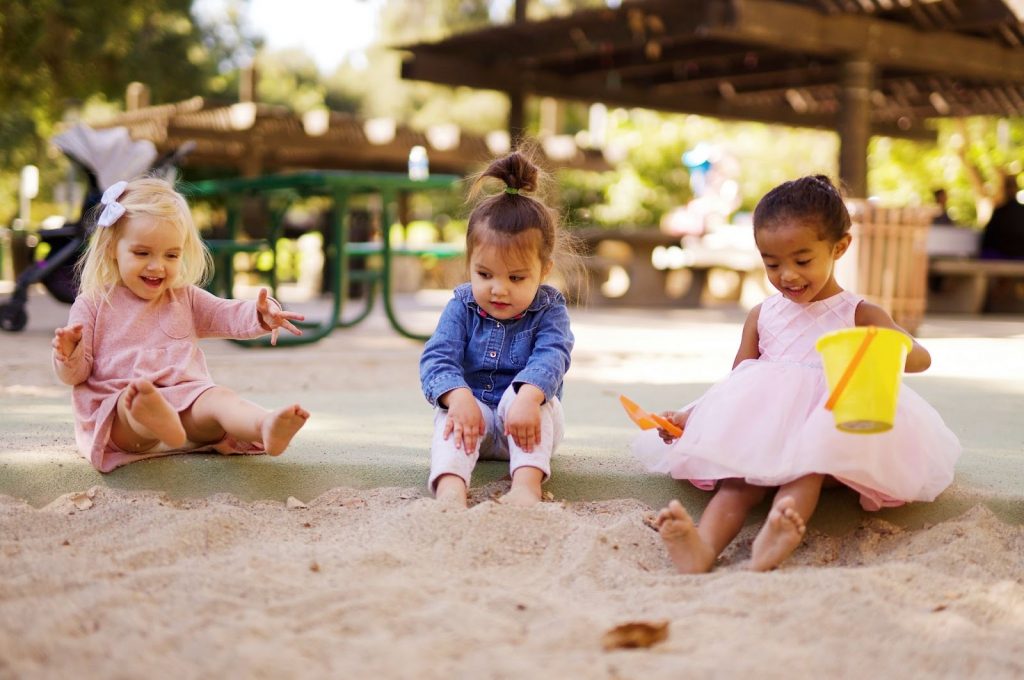
Developing problem solving skills is extremely important for kids as it helps them to navigate easily around difficulties later on in life. As adults, we’re faced with challenging situations every day, and without our basic problem-solving skills, we wouldn’t be able to survive.
Problem solving skills also help kids to make effective decisions. It helps them resolve problems all at once without reducing them to smaller problems. Once kids develop problem solving skills, it is easier for them to develop other skills as well like critical thinking, cooperation and collaboration with others.
Having problem solving skills helps kids to become more creative and think differently than others and enables them to become independent. These skills also help kids develop decision-making skills and build their confidence along the way as they take the right decisions.
Frequently Asked Questions (FAQs)
What are the 5 problem solving skills.
The five problem solving skills are identifying the problem, producing possible results that might work, picking one solution from these, applying the chosen solution and evaluating the results.
What are some examples of problem-solving skills in kids?
Some of the problem solving skills in kids are research, creativity, team-building, communication, active listening, decision-making, and analysis. If you find some of these skills in a kid, chances are they’re great at problem solving.
What is problem solving learning?
According to cornell.edu, Problem solving learning is an approach wherein students are asked open-ended questions about a certain topic, and they must resolve and answer the same in groups.
At what age do children begin problem-solving?
According to a study by Shaffer , kids can start developing basic problem solving skills from the age of three. This further continues to develop as they grow.
What are three problem-solving techniques
According to deakin.edu , the three most basic problem solving techniques are defining the problem, listing out all the possible solutions, and evaluating the options.
12 Best Communication Activities for kids of All Ages
15 Best Listening Activities for Kids to Enhance Auditory Skills
15 Best Reading Fluency Activities for Early Learners

Most Popular

15 Best Report Card Comments Samples

101 Best Riddles for Kids (With Explanation)

40 Best Good Vibes Quotes to Brighten Your Day
Recent posts.

What is Classical Homeschooling: A Comprehensive Guide

Math & ELA | PreK To Grade 5
Kids see fun., you see real learning outcomes..
Watch your kids fall in love with math & reading through our scientifically designed curriculum.
Parents, try for free Teachers, use for free

- Games for Kids
- Worksheets for Kids
- Math Worksheets
- ELA Worksheets
- Math Vocabulary
- Number Games
- Addition Games
- Subtraction Games
- Multiplication Games
- Division Games
- Addition Worksheets
- Subtraction Worksheets
- Multiplication Worksheets
- Division Worksheets
- Times Tables Worksheets
- Reading Games
- Writing Games
- Phonics Games
- Sight Words Games
- Letter Tracing Games
- Reading Worksheets
- Writing Worksheets
- Phonics Worksheets
- Sight Words Worksheets
- Letter Tracing Worksheets
- Prime Number
- Order of Operations
- Long multiplication
- Place value
- Parallelogram
- SplashLearn Success Stories
- SplashLearn Apps
- [email protected]
© Copyright - SplashLearn

Make study-time fun with 14,000+ games & activities, 450+ lesson plans, and more—free forever.
Parents, Try for Free Teachers, Use for Free
🎒 Back-To-School Sale: 30% OFF + Get a Free Family Plan!
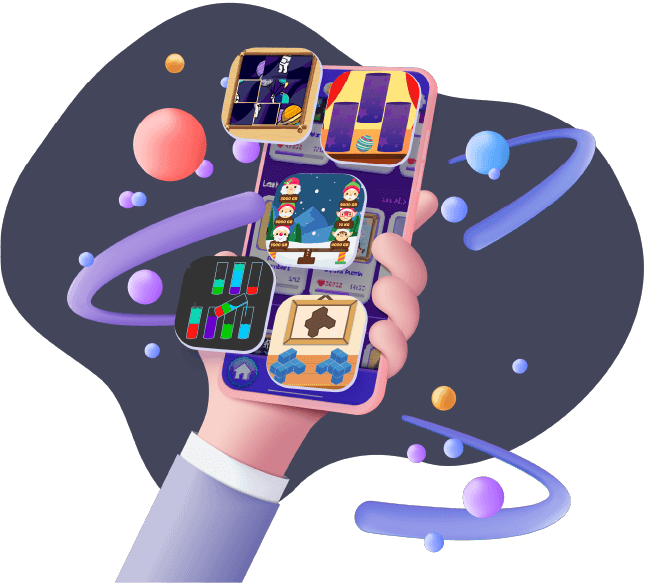
Brain Games for Kids
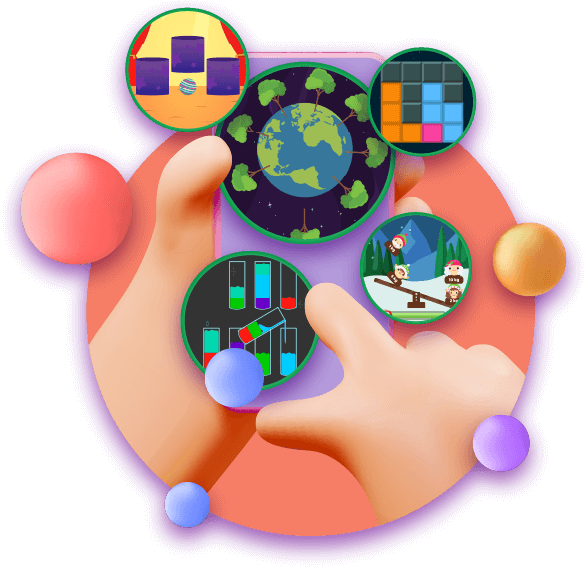
Fun Brain Games for Kids
Logic Balls
These kinds of brain games online for kids improve reasoning, planning, and visualization skills.
Face Memory Game
A great mind game for kids! It improves visual scanning, planning, and spatial memory .
Spot the Difference
One of the best brain games for clever kids. Improves visual attention, visual scanning, and comparison skills.
Find the Word
This brain game for kids improves visual recognition, conceptualization, and visual attention skills.
Online Brain Games for Kids
Candy Match
Entertaining brain games for kids online like this one improve kids’ cognitive skills as well as visual attention and counting abilities .
Looking for mental games for kids? It improves memory, visual attention, and naming skills.
Card Matching Game
When you want to boost your mental abilities, you can use smart brain games for kids! Don’t skip without trying this one.
Missed Ball
If you need the best brain games for kids, you can be sure that your kids will love this game!

Kids love—parents trust. Named among the best in family-friendly products by U.S. Teachers and Moms.

The convenience of MentalUP’s content to the UK curriculum has been proved by the Education Alliance Finland .

MentalUP has been qualified to get EVIDENCE of IMPACT Award by University College London for its academic contribution.

Loved by over 10 million users . Join millions of parents, teachers, and kids all around the world.

It’s a safe, fun world for kids. There are no ads or inappropriate content either.

Brain Exercise Games for Kids
Bubble Buster: Addition to 10
These kinds of maths brain games for kids planning , visual attention and math skills.
Dwarf Giant
These kinds of good brain games for kids improve reaction control , focusing , and divided attention .
Musical Instruments Game
Brain teasers games for kids help children to improve their visual-aural memory and decision-making skills.
Hidden Object Game
Are you ready for the best brain workout? These kinds of free mind games for kids are a golden opportunity to improve their attention , scanning , and memory skills!
Brain Break Games for Kids
Have I Seen It or Not?
These kinds of fun brain games for kids free improve visual memory , sustained attention , and visual recognition skills.
Shape Recognition
These brain gym games for kids can help kids improve visual attention , visual scanning , and short-term memory skills.
Kindergarten brain games for kids like this one improve sustained attention, visual tracking , and spatial memory skills.
Shape Match
These kinds of brain games for kids kindergarten improve visual attention, conceptualization , and visual scanning skills.
Brain Puzzle Games for Kids
Exactly the Same
Brain games free for kids like this one work as a concentration exercise that develops visual attention , visual scanning , and comparison skills .
Find the Pairs
You can both have fun and boost your mental skills by playing cognitive games for kids. Be ready for a challenging experience.
Shadow Matching
This free brain training game for kids improves attention, visual scanning, and reasoning skills.
Find the Differences
Simple brain games for kids help you to develop your and your kids’ cognitive skills. When you are improving with this fun game, you will lose track of time.
Brain Storming Games for Kids
Counting Game
If you’re looking for brain math games for kids, look no further! This one improves visual attention and counting skills.
Color Word Matching
These kinds of brain activity games for kids improve divided attention, reaction control and focusing skills.
Brain development games for kids like this one improve sustained attention, visual recognition, and memory skills.
What Changed?
These kinds of games for kids brain improves visual attention, visual memory , and visual scanning skills
Letters & Numbers
This brain stimulation exercise for kids improves visual scanning , comparison , and planning skills .
Stroop Test
This stimulation game for kids improves divided attention, reaction control , and sustained attention .
Ascending Number Order
Games that help your brain for kids like this one improve visual scanning, comparison, and planning skills.
Ascending Letter Order
One of the games for the brain! It improves divided attention, reaction control, and focusing skills.
PLAY FOR FREE
Free Brain Games for Kids
IQ games for kids like this one boost your reasoning, spatial perception, and counting skills. Start to play, have fun, and develop in a short while.
Math Operation Game
Brain board games for kids like this provide your children with a special experience because they improve math and processing speed skills instantly.
Less Than or Greater Than Game
These kinds of fun free brain games for kids improve logical thinking, math skills, and comparison skills.
True or False?
This free brain training game for kids supports math skills , decision-making , and processing speed skills .
Find the Operation
When you need to challenge your skills such as logical thinking and decision-making by having fun at the same time, brain games for kids free should be your first choice.
Brain building games for kids like this one improve math skills, processing speed , and decision-making skills.
Equalization
Best brain games for kids help your kids to improve their math, reasoning and processing speed skills . You can use it to practice your mental abilities.
Conditional Statements
If you need to empower your logical thinking, planning , and sustained attention , you can use this game which is one of the best alternatives to kids mind games.
Brain Teaser Games for Kids
Word Generator
Brain games ideas for kids like this word game improve vocabulary, verbal fluency , and planning skills .
These kinds of kids brain games improve vocabulary, verbal fluency , and reasoning skills .
Synonym Antonym
Puzzle brain games for kids like this exercise improve verbal fluency and vocabulary skills .
Relationship Status
These kinds of visual brain games for kids improve conceptualization, comparison , and divided attention skills.
Color Pattern Shape
Brain games for kids preschool like this one improve conceptualization, visual attention , and sustained attention skills.
Word Categories
These kinds of brain games for kids quiz improves vocabulary, conceptualization , and divided attention skills.
Word Combinator
Free mind games for kids! This free game improves vocabulary , visual scanning , verbal intelligence and conceptualization skills.
Let’s Find It
These kinds of brain games puzzles for kids support visual recognition, conceptualization , and visual attention skills .
Why MentalUP Brain Games?

Trusted by World Leading Communities
We recommend the MentalUP which is developed by academicians and pedagogues and is filled with educational brain teasers.

MentalUP Educational Games will enable your child to use technology in a beneficial way.

MentalUP is an online innovative games resources for teachers and parents.

MentalUP does brain training well. Its games are easy to understand while challenging the skills which they are designed to stretch.

MentalUP is a UK-based award-winning scientific-educational application containing cognitive learning games for K-8 learners.

MentalUP developed by game designers and academics incorporating innovative teaching methods to offer dozens of mind games.

FEATURES OF THE EDUCATIONAL GAMES
- FUN & IMPROVING FREE BRAIN GAMES
- PERSONALIZED GAMES FOR THE BRAIN DEVELOPMENT
- SCIENTIFICALLY APPROVED ENTERTAINING ONLINE BRAIN GAMES
BENEFITS OF MENTALUP BRAIN GAMES
- INCREASES ATTENTION.
- IMPROVES MEMORY.
- DEVELOPS THINKING & PROBLEM SOLVING SKILLS.
Try MentalUP free, discover the world of MentalUP now!

6 Effective Strategies to Promote Problem-Solving Skills in Young Children
Problem-solving is a critical skill that helps children navigate the challenges they face throughout their lives. As early childhood educators, we can encourage and promote problem-solving skills in young children from the earliest stages of development. Here are some strategies for promoting problem-solving skills in young children:
1. Encourage exploration and experimentation
Young children are naturally curious and love to explore their surroundings. Encourage this natural curiosity by providing opportunities for your child to experiment with different materials and objects. This can help them develop their problem-solving skills by encouraging them to explore and discover new solutions to challenges. Here are some examples of how to encourage exploration and experimentation in young children:
- Sensory Play Sensory play involves providing children with materials that stimulate their senses, such as touch, sight, smell, and sound. Examples of sensory play materials include water, sand, play dough, and different textures of fabrics. Sensory play allows children to explore their environment and develop their creativity and problem-solving skills by manipulating materials to create different outcomes.
- Block Play Blocks are an excellent tool for promoting exploration and experimentation in young children. Children can build structures and experiment with different block combinations to create different outcomes. Block play encourages children to develop their spatial awareness, hand-eye coordination, and problem-solving skills.
- Outdoor Play Outdoor play provides young children with endless opportunities for exploration and experimentation. Nature provides an endless variety of materials for children to explore, such as rocks, sticks, and leaves. Children can create their own outdoor play spaces and experiment with building structures or creating games.
- Art and Craft Activities Art and craft activities are a fantastic way to encourage exploration and experimentation in young children. Children can experiment with different materials such as paint, glue, and paper to create different outcomes. Encouraging children to experiment with different materials and techniques can help them develop their problem-solving skills and creativity.
- Science Experiments Simple science experiments are a great way to encourage exploration and experimentation in young children. Children can observe cause and effect relationships by experimenting with different materials or processes. For example, children can experiment with different ingredients to make slime, or create a volcano eruption with baking soda and vinegar.
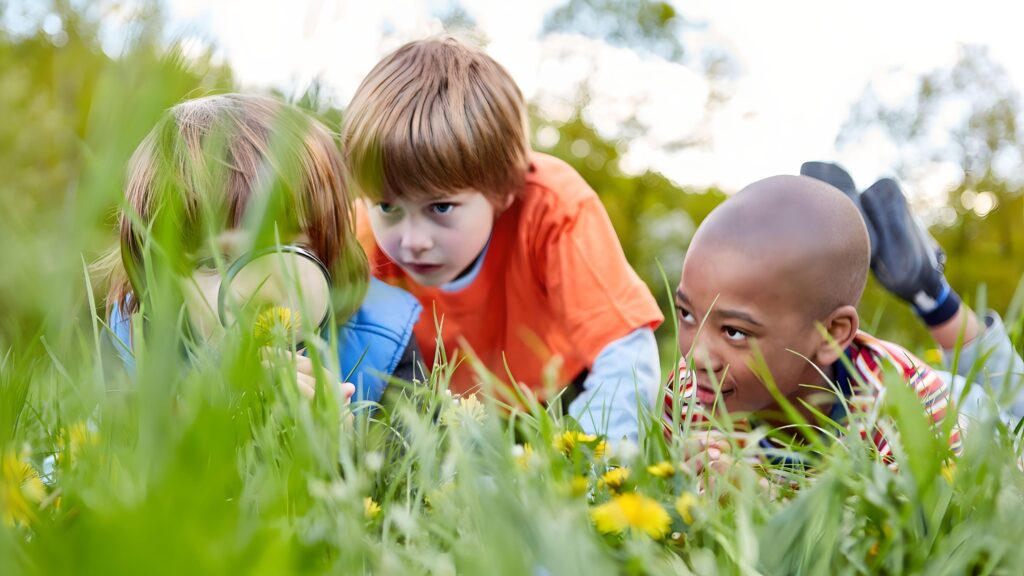
2. Promote imaginative play
Imaginative play can be a valuable tool for promoting problem-solving skills. By engaging in pretend play, children can develop their creativity, critical thinking, and problem-solving abilities. Encourage your child to engage in imaginative play by providing them with props and toys that stimulate their imagination. Here are some examples of how to promote imaginative play in young children:
- Pretend Play Pretend play involves children creating imaginary scenarios and acting them out using props and toys. Children can engage in pretend play with dolls, toy cars, play kitchen, and other props that stimulate their imagination. Pretend play allows children to explore different roles, experiment with different scenarios, and develop their problem-solving skills by working through imaginary conflicts and scenarios.
- Dress-Up Dress-up allows children to experiment with different identities and roles. Children can dress up in different costumes and props and create imaginary scenarios. Dress-up encourages children to use their creativity, develop their empathy and social skills, and engage in problem-solving by working through imaginary conflicts.
- Storytelling Storytelling is an excellent way to promote imaginative play and encourage problem-solving skills. Children can create their own stories, or teachers can read them stories and encourage them to retell or create their own versions. Storytelling encourages children to use their creativity, develop their language skills, and engage in problem-solving by imagining different outcomes.
- Creative Play Spaces Creating a dedicated play space can promote imaginative play and problem-solving skills in young children. A play space can be designed to encourage imaginative play, such as a play kitchen, a dress-up area, or a building area. Providing children with the necessary props and materials to stimulate their imagination can help them develop their problem-solving skills by encouraging them to create different scenarios.
- Open-Ended Toys Open-ended toys, such as blocks, art materials, and playdough, can be used in a variety of ways to promote imaginative play and problem-solving skills. Children can experiment with different combinations and create their own scenarios, developing their creativity and problem-solving abilities.
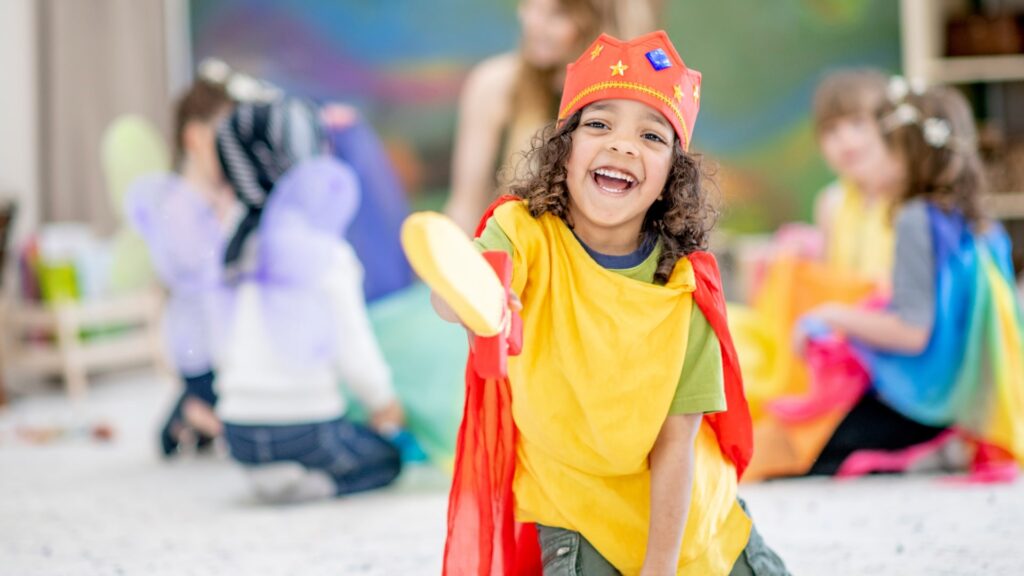
3. Teach problem-solving vocabulary
Introducing problem-solving vocabulary is an important way to promote problem-solving skills in young children. By learning problem-solving vocabulary, children can better understand and communicate about the problem-solving process. Here are some examples of problem-solving vocabulary and how to teach it to young children:
- Identify the problem To identify a problem, children need to be able to recognize when something isn’t working as it should. Teach children words and phrases like “I’m stuck,” “This isn’t working,” or “I need help.” Encourage them to communicate when they encounter a problem and ask for help when needed.
- Brainstorming Brainstorming involves generating many different ideas to solve a problem. Teach children words and phrases like “let’s think of some ideas,” “what are some possible solutions,” or “what else could we try.” Encourage them to come up with many different ideas, even if they seem silly or unlikely to work.
- Evaluate solutions After generating ideas, children need to evaluate each solution to determine which is the best one. Teach children words and phrases like “let’s see which idea would work best,” “what are the pros and cons of each idea,” or “which solution would be most helpful.” Encourage them to consider all the possible solutions and evaluate each one carefully.
- Make a plan Once a solution has been chosen, children need to make a plan to implement it. Teach children words and phrases like “let’s make a plan,” “what steps do we need to take,” or “how can we make this happen.” Encourage them to break down the solution into smaller steps and create a plan for each step.
- Reflect on the outcome After trying out a solution, it’s important to reflect on what worked and what didn’t. Teach children words and phrases like “how did it go,” “did our plan work,” or “what could we do differently next time.” Encourage them to reflect on the outcome and use what they learned to solve similar problems in the future.
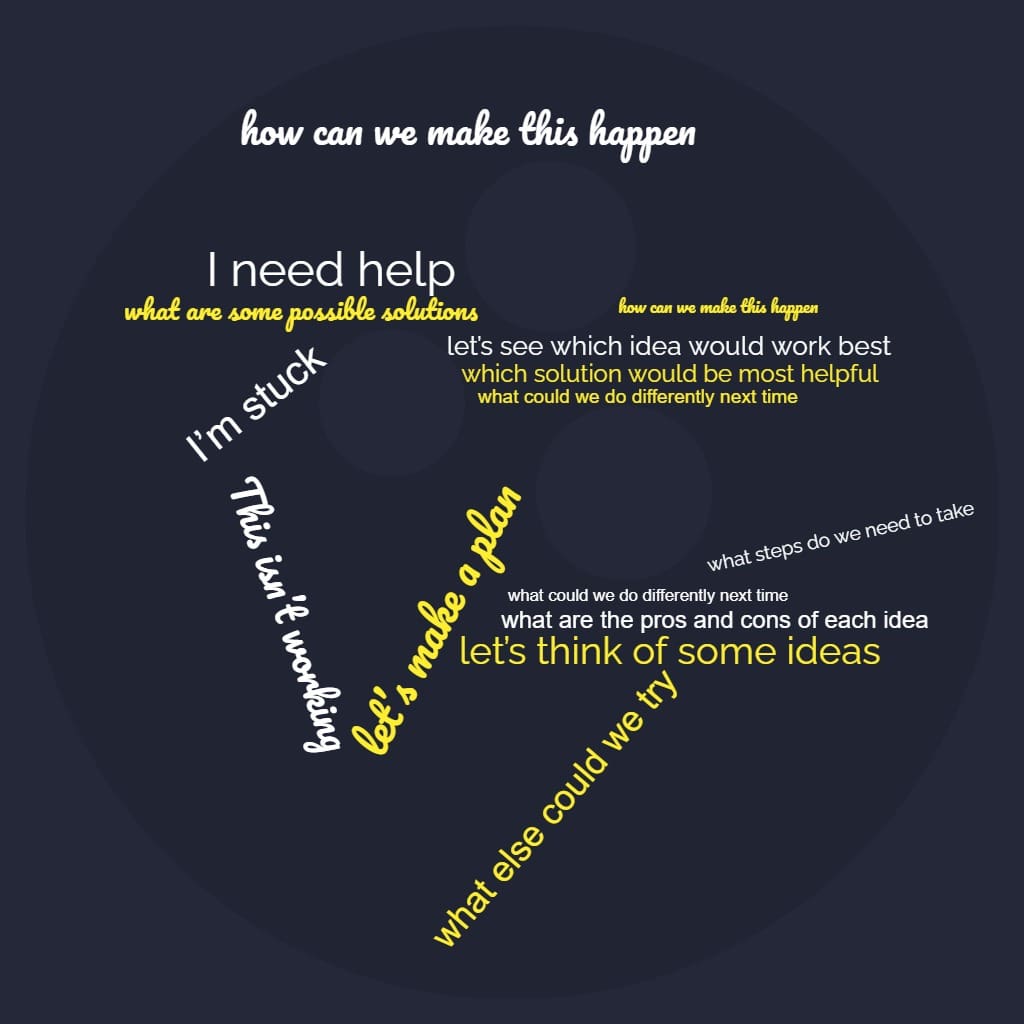
4. Model problem-solving skills
Children learn by watching and imitating the behavior of adults around them. Therefore, modeling problem-solving skills is essential for promoting these skills in young children. Let your child see you working through problems, and encourage them to ask questions and offer suggestions. When children see adults or peers effectively solve problems, they are more likely to learn and apply those skills themselves. Here are some examples of how to model problem-solving skills for young children:
- Narrate your problem-solving process When you encounter a problem, narrate your problem-solving process out loud to show children how you think through and solve the problem. For example, “I’m trying to figure out how to fix this toy. First, I need to look at the instructions and see what’s wrong. Then, I can try a few different solutions until I find one that works.”
- Use real-world scenarios Use real-world scenarios to model problem-solving skills, such as fixing a broken toy, figuring out a puzzle, or finding a lost item. Show children how you use critical thinking and problem-solving strategies to tackle the problem, and encourage them to ask questions and offer their own solutions.
- Role-play Role-playing scenarios where children can practice problem-solving skills can be a fun and effective way to model these skills. For example, you can set up a pretend store where children can practice making decisions and solving problems related to shopping.
- Provide opportunities for problem-solving Provide children with opportunities to practice problem-solving skills in everyday activities and invite parent to do the same while cooking, cleaning, or planning a family outing. Encourage them to work through problems and come up with solutions, and praise them for their efforts.
- Collaborate on problem-solving Collaborating with children on problem-solving tasks can model effective problem-solving skills and promote teamwork. Work together to solve problems, and show children how to communicate, negotiate, and compromise to achieve a common goal.
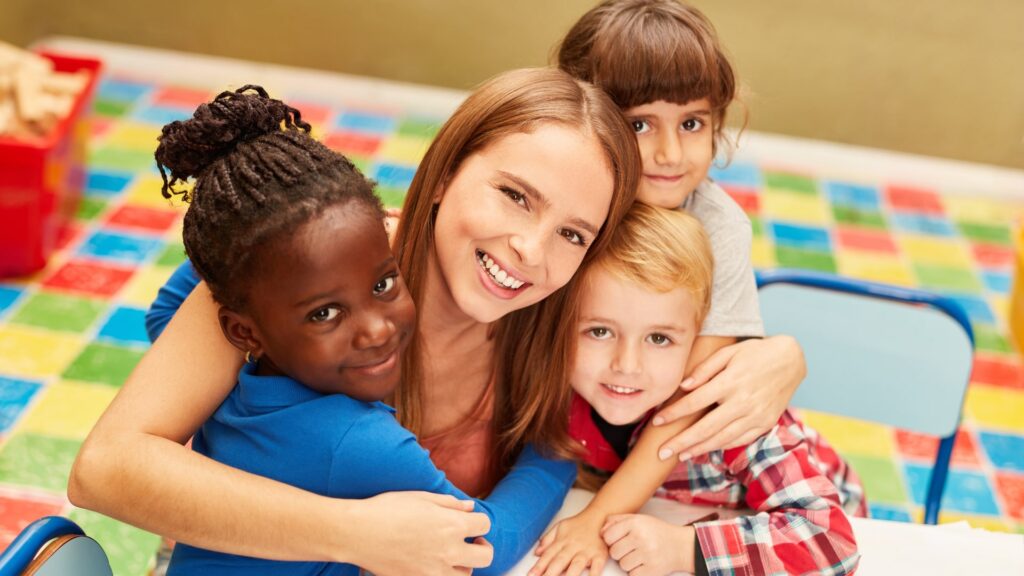
5. Allow for independent problem-solving
While it’s essential to support young children as they develop their problem-solving skills, it’s also important to allow them to work independently. Allowing children to work through problems on their own can help them develop their critical thinking skills and build confidence in their abilities . Here are some examples of how to allow for independent problem-solving:
- Give them space Allow children to have some time and space to work through problems on their own. Resist the urge to jump in and solve the problem for them, unless it’s a safety issue. Instead, observe from a distance and offer encouragement and support as needed.
- Encourage risk-taking Encourage children to take risks and try new things, even if they might not work out. When they encounter a problem or setback, remind them that mistakes are a natural part of the learning process and encourage them to keep trying.
- Offer open-ended activities Offer open-ended activities that allow for creativity and problem-solving, such as building with blocks, creating art, or playing with sensory materials as was mentioned earlier. These activities encourage children to use their imagination and experiment with different solutions.
- Provide tools and resources Provide children with tools and resources that they can use to solve problems independently, such as a toolbox or a collection of building materials. These resources can give children the confidence to tackle problems on their own.
- Praise effort and progress When children are working on solving a problem, praise their effort and progress, even if the solution isn’t perfect. Focus on the process of problem-solving, rather than the end result, and encourage children to keep trying and learning.

6. Encourage persistence
Encouraging persistence is critical for promoting problem-solving skills in young children. When your child encounters a problem, encourage them to keep trying and not give up. Celebrate their successes and encourage them to learn from their mistakes. When children learn to persevere through challenges and setbacks, they build resilience and develop the confidence to tackle difficult problems. Here are some examples of how to encourage persistence:
- Provide age-appropriate challenges Provide children with challenges that are appropriate for their age and skill level. Challenges that are too difficult can be frustrating and lead to giving up, while challenges that are too easy can be boring. Finding the right level of challenge can motivate children to keep trying and push themselves.
- Offer encouragement Offer words of encouragement and support when children encounter challenges. Let them know that you believe in them and that you know they can figure it out. Encourage them to keep trying and remind them of their past successes.
- Focus on progress Focus on progress rather than perfection. Celebrate small successes and milestones along the way, even if the problem isn’t fully solved yet. This can help children see that progress is possible and encourage them to keep going.
- Model persistence Model persistence and a positive attitude in your own problem-solving efforts. When children see you persisting through challenges and setbacks, they are more likely to adopt a similar mindset.
- Use positive self-talk Encourage children to use positive self-talk when they encounter challenges. Teach them to say things like, “I can do this,” “I just need to keep trying,” and “I’ll figure it out eventually.”

In conclusion, promoting problem-solving skills in young children is critical for their overall development. By providing opportunities for exploration and experimentation, promoting imaginative play, teaching problem-solving vocabulary, modeling problem-solving skills, allowing for independent problem-solving, and encouraging persistence, we can help our children develop these essential skills that will serve them throughout their lives.

Elevate your teaching skills and stay ahead of the curve! Receive our monthly Insights, packed with professional development opportunities, classroom inspiration, and the latest trends in education. Don’t miss out on the chance to take your teaching to the next level. Subscribe now!
Similar Posts

The Crucial Role of Teacher Well-being in Early Childhood Education
Since Teachers play a pivotal role in shaping the future of young minds, let’s explore the delve into the symbiotic relationship between teacher well-being, professional growth, and the optimal development of children.
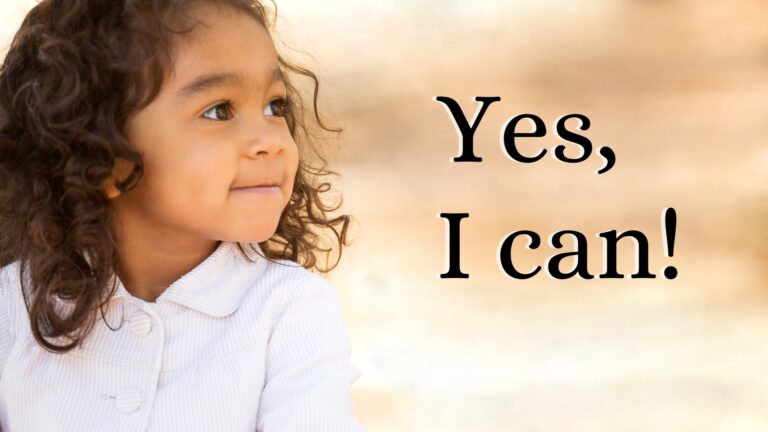
Fostering Resilience Through Play
In the realm of early childhood education, we often underscore the significance of play as a fundamental aspect of a child’s development. However, it’s crucial to recognize that playtime isn’t just about having fun; it’s a potent tool for cultivating resilience in young learners. In this article, we will delve into the fascinating connection between…
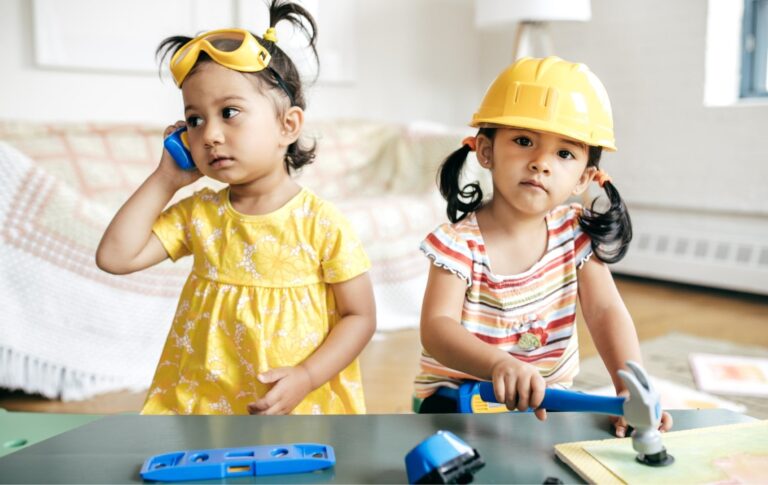
The Importance of Role Play
Let’s delve into a topic that holds immense potential for fostering holistic development in our little learners – the captivating world of role play. As you guide these young minds toward their full potential, incorporating purposeful role play into your teaching toolkit can be a game-changer.
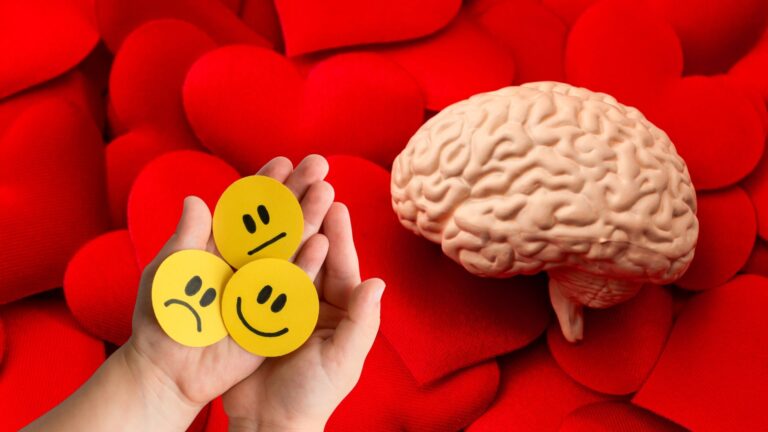
Nurturing Emotional Intelligence in Children
Explore practical strategies for early childhood educators to nurture emotional intelligence in children. Learn how to build trust, respond with insight, empower emotional regulation, foster communication, and create supportive environments in the classroom.
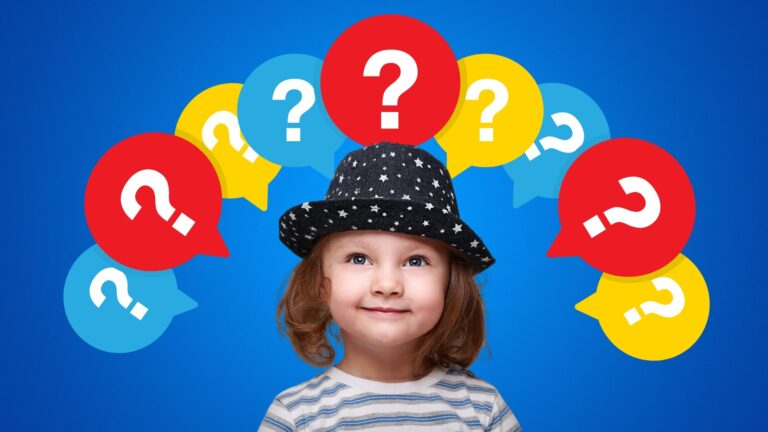
The Power of Open-Ended Questions
Embracing the power of inquiry is not merely a pedagogical choice; it is a commitment to sculpting young minds that are resilient, inquisitive, and equipped to navigate the complexities of the world.

Embracing Positivity in a Negativity-Biased World
By equipping children with the tools to navigate the complexities of their inner landscape, we empower them to transcend negativity and embrace the boundless potential of positivity.
Enter your email to download PDF and receive updates from OSMO
Scan to get started.
The Assessment App is available only on the Apple App Store . Please scan the QR code below with your iPhone device to download the app.

Problem Solving For Kids
Help your kid become an ace at solving problems with these problem-solving activities and games .
As children grow up they’ll be faced with several problems. These problems can be complicated, they’ll challenge the kids intellectually, physically and mentally and emotionally. Dealing with all of these can leave them feeling stressed and anxious. That’s why it’s important to equip children with problem solving skills. These problem solving skills will help the children deal with and tackle these problems without any stress or anxiety.
Teaching Problem-Solving For Kids
Problems aren’t something that only adults face. Kids have problems too, it could be a conflict over toys or candy, a math test or even negative peer pressure. As parents and educators, you can’t always be there to resolve conflicts and solve problems for them. A parent’s job is to raise a confident, independent, and successful individual, equipped with the right problem solving skills.
Young children often get frustrated and give up on things when they encounter an obstacle or a problem. With the right problem solving skills, kids learn to think creatively, and work persistently until they find a solution. This equips them with the tools to develop their cognitive abilities and face challenges without fear of failure. Here are some age-appropriate tips to teach problem solving for kids.
Problem Solving For Kids of 3 – 6 years
One of the most important parts of problem-solving for kids is emotion management. Often, when kids encounter challenges that frustrate them, they throw a tantrum. They won’t consider finding a logical solution to the problem in the middle of a tantrum. Teaching them to process and control their emotions helps them think and find a solution easily.
Once they are calm, help them brainstorm solutions by asking leading questions. Once they learn this process, you’ll find that they tend to practice problem solving skills rather than throwing a tantrum.
Problem Solving For Kids of 6 – 9 years
By the time they are six years old, kids learn to control their emotions better. But they still can get frustrated when faced with challenges they cannot overcome. It’s a great idea to help kids find the root of the problem. This makes it less intimidating and helps them understand the problem, which makes it easier for them to solve the problem.
Kids at this age are quick learners. Help them learn problem-solving skills using stories, creative play and activities. Teach them some problem solving strategies for kids by acting out scenarios.
Problem Solving For Kids of 9-11 years
Children at this age are better equipped to solve problems on their own. However, problems only get bigger as we grow older and their solutions become equally complex too. One great way to solve a difficult problem is to break it down into manageable steps or smaller chunks.
For example, if your child has a low grade in history, find out why? Maybe they didn’t submit the assignments on time. So help them make a list of assignments and tackle them one by one.
Reading stories and crafting are great activities to instill problem solving skills in a child. Often, children tend to give up if they find a problem too challenging. The characters of a story and their trials and the end product of crafting teaches them to embrace the challenge and persevere until they finish. Here are some great ideas for crafts for kids to teach problem solving for kids.
Benefits of Performing Problem Solving For Kids:
- Problem-solving activities build self-confidence and self-esteem in a child
- Problem-solving games help children to develop a positive attitude towards life
- Problem solving for kids is necessary to build solid social and emotional skills in the kids
- These problem solving games and activities improve the child’s confidence, critical thinking skills, logical reasoning skills and perseverance.
Problem-Solving Activities And Puzzles For Kids:
- Introduce Problem Solving For Kids Using Rubix Cubes : Rubix cubes are one of the best ways to introduce your child to problem solving for kids. As they patiently align the multicolored blocks, children learn a few key problem-solving skills. Rubix cubes are square-shaped, 6 sided blocks with multicolored cubes. These blocks come in 3×3, 6×6, or 9×9 grids. Rubix cubes are available in stores and online. The cubes and different grids are twisted and turned in different directions to ensure all the colors are aligned. This can be a little challenging initially, but once your kid gets a hang of it, they can easily solve the Rubix cube in a couple of minutes. Solving Rubix cubes enhances the child’s brain activity and boosts their logical thinking skills.
- Crossword Puzzles Are One Of The Best Problem Solving Activities for kids: Crossword puzzles are a brilliant vocabulary game that helps children improve their vocabulary skills along with problem-solving skills. Crossword puzzles are available in books, newspapers and online. These Word Search Puzzles for Kids contain square-shaped blocks that are horizontally and vertically aligned. Some of the blocks may be filled with letters while the rest of the blocks are empty. These puzzles are solved with the help of the hints that are given alongside the puzzle. Crossword puzzles for kids help children find the solution on their own to a particular problem by looking at the hints.
- Jigsaw Puzzles To Help Children Learn Problem Solving In A Creative Way : Solving jigsaw puzzles are a very popular activity to build problem-solving skills in kids. These puzzles are available for kids of all age groups ranging from 3-12. Jigsaw puzzles contain several wooden or cardboard pieces along with a board and an image for reference. Kids should connect the puzzle pieces to create a replica of that reference image. Solving jigsaw puzzles is a fun and engaging activity to enhance your kid’s problem-solving skills. To make this activity more interesting and challenging, ask your child to solve the puzzle in a certain amount of time. This activity boosts the child’s critical thinking, logical reasoning skills and builds their patience.
- Learn Problem Solving By Navigating The Maze: Navigating or finding the best route through a maze is a wonderful game to stimulate your child’s brain. This game involves a maze with many routes to reach the destination. The child should navigate through the maze and find the best route to reach the destination. For example, the rabbit wants to eat the carrot but there is an impossible maze between the hungry rabbit and the carrot. Your kid must help the rabbit find the easiest and quickest route to his carrot. Children can use pencils or crayons to trace the route through the maze. Some of these routes might be blocked or have an obstruction. In such situations, they have to start all over again to find the best route. This activity can get frustrating at times, but it is one of the best ways to enhance your child’s problem-solving skills. Additionally, this problem solving activity helps boost the child’s logical thinking skills and build patience. It also teaches them to not give up and try again until they succeed.
- Teach Problem Solving For Kids With Simple Coding Games: Coding for kids is a great tool to teach problem solving for kids. It is not just an activity meant for adults or older kids anymore, younger kids can learn the basics of coding too. Coding games are great tools that improve the child’s problem-solving skills. You can choose from the myriad simple coding games and activities available online for young kids to learn the basics of coding. These coding games for kids mostly involve the fundamentals of math, which also boosts their mathematical skills. Kids can also learn different computer languages like HTML, X, C++, Java, Python, etc. If your child is a computer geek, then look no further. Coding games are a great way to turn your kid into a computer whiz to improve their coding and problem solving skills.
Kids are taught to solve simple puzzles and games from a young age. These simple learning activities are great tools to build a solid foundation for problem-solving skills. Not only are they fun to play with, but they also teach children to find an optimum solution to a particular problem. These games and puzzles also help in enhancing their logical reasoning and critical thinking skills. These skills are necessary to build problem-solving skills in kids.
Problems are aplenty in our lives. From math problems to emotional problems, we all have them. The best thing we all can do is learn to tackle them efficiently so that they don’t affect us.
Osmo has a wide variety of activities for kids to do at home, games and worksheets for kids , alphabet coloring pages on several topics to aid in your kids learning – math activities for toddlers.
Frequently Asked Questions on Problem Solving For Kids
What are the advantages of problem solving for kids.
The advantages of Problem Solving For Kids are that it helps them to improve their social and emotional skills, develop their critical thinking skills, confidence, logical thinking abilities,and determination.
What are the activities that help kids to solve the problems?
The activities that help kids to solve the problems are solving crossword puzzles, jigsaw puzzles, learning problem solving by working on the maze, solving simple coding games, solving rubix cubes, etc.

Discovery Play with Littles
2:01 pm ·
15 Powerful Problem Solving Activities for Toddlers and Preschoolers
I looked over to her table and she’s crying. Again. While everyone else is happily working away, she sat there, unable to move, just crying.
Not asking for help.
Not trying to solve her problem.
Just crying.
I took a deep breath before heading over. We’ve already been at this for several months…isn’t it about time the problem-solving has kicked in yet?
One glance and I could tell what her problem was. She didn’t have her pencil.
Know how I knew?
It laid on the floor beside her. In plain sight.
As a kindergarten teacher, I don’t jump right in and solve problems for kids. It’s good for them to try to solve the problem themselves. This is something she struggled with.
I reminded myself of the need for patience and empathy as I walked up to her. “What’s wrong, Amanda?”
“I…can’t…find…my…pencil….” she sputtered out between sobs.
“Ok, that’s a problem we can solve. What have you tried?”
“I don’t know.”
After a long time trying to first, calm her down, and second, come up with some strategies she could try, she finally found her pencil. At that point, everyone else had finished the project.

What is Problem Solving?
Problem-solving is the process of finding a solution to your problem . This can be quite tricky for some young children, especially those with little experience in finding more than one way to solve a problem.
Why is Problem Solving Important?
Problem-solving skills are used throughout childhood into adulthood. As adults, we solve problems on a daily basis. Some problems we solve without thinking much- I wanted to make tacos for dinner but forgot to buy the ground beef. What are we going to have for dinner now?
Other problems are significantly more complicated.
Problems for kiddos can be problems with friendships, the inability to find something that’s needed, or even what to do when things don’t go your way.
Kids who lack problem-solving skills struggle to maintain friendships or even begin to attempt to solve their own problems.
Children who lack problem-solving skills are at a higher risk for depression as well.
What Are Problem-Solving Skills?
Problem-solving skills are:
- Breaking Down a Problem into Smaller Parts
- Communication
- Decision-making
- Logical Reasoning
- Perseverance
That’s a big list to teach toddlers and preschoolers. Where do you begin?
The Problem-Solving Steps
Sometimes kids are so overwhelmed with frustration that it affects their ability to solve problems.
Kids feel safe in routines, and routines help them learn and grow. After a few times of repeating this routine, you’ll find your kiddo starts to do this on their own.
It’s important not to skip straight to solving the problem , because your kiddo needs to be in a calm state of mind to solve the problem, and also they need to know their feelings are valid.
- The first thing to do when your kiddo is struggling with problem-solving is to validate their emotions.
In doing this, they will feel more understood and learn that their emotions are okay. There are no bad feelings, and we must learn how to manage our emotions.
This might sound something like “Oh, I can see you are really frustrated that the block won’t fit on there right. Let’s take some deep breaths to help us calm down before we think about what to do next.”
- Next, work through your calm-down process . This may be taking some deep breaths together, hugging a stuffie, or giving your kiddo some quiet time to calm down their heart and mind.
- Identify the problem . This sounds like something you may have already done (before the meltdown) but it’s important to be very clear on the problem you’re solving. Have the child tell you their problem out loud.
- Move on to solution-finding . When your kiddo is ready, talk about what the problem is and three possible solutions. When possible, let your kiddo do all of the talking. This allows him to practice his problem-solving skills. It’s important to remind him that the first thing he tries may not work, and that’s ok. There’s always another way to solve the problem. If he’s prepared for this, solutions that don’t work won’t be such a frustrating experience.
- After you’ve done that, test your solutions one by one. See what works. If you haven’t found a solution yet, go back and think of different ways you might be able to solve your problem and try again.

Are you tired of hearing “It’s TOO HARD!” followed by a meltdown?
Using this one simple phrase you’ll get in this powerful lesson, you’ll not only be able to help your kiddo not give up but you’ll:
>Activate their superpower of perseverance so that they can turn around a meltdown and keep trying
>Inspire them to use perseverance …even when it’s hard
>Teach them to recognize the warning signs of giving up , and how to turn it around by taking control of their choices.
Grab your powerful FREE video lesson to teach your kiddo one of the most powerful keys to perseverance.
Powerful Activities that Teach Problem-Solving Skills to Toddlers & Preschoolers
These activities below may look simple, but don’t let that deter you from trying them. A lot happens in little developing brains and these powerful activities help toddlers and preschoolers make connections and develop {many} essential skills-more than just problem-solving.
As an Amazon Associate, I earn from qualifying purchases at no additional cost to you.
Puzzles are fun and a great way to encourage cognitive development in children. They are great for spacial reasoning and strengthening problem-solving skills. They also develop memory skills, critical thinking, and the ability to plan and execute the plan. Toddlers will enjoy the simple puzzles, and preschoolers will do great with floor puzzles with larger puzzle pieces.

Doing Simple Chores
Doing simple chores is a great way to teach children problem-solving skills, and it strengthens responsibility and perseverance as well.
During the toddler years , you may start with just picking up their toys, or helping you put their dirty clothes in the hamper.
Preschoolers can take their dirty dishes to the sink (or load them in the dishwasher), collect the trash, dust, wipe baseboards, and do their own personal care items like making their bed, taking care of their dirty clothes, and putting clean clothes away.
Stacking Rings
When watching a toddler play with stacking rings it doesn’t look like much is happening, but playing with these toys is full of ways to encourage development. It helps with visual and spacial perception and planning ahead, but it also with balance control, crossing the midline, creative play, and gross motor skills. Not to mention it’s a great opportunity to practice problem-solving.

Playing Hide-and-Seek
Hide and seek has many surprising benefits for kids. Playing hide and seek is like a treasure hunt that helps develop gross motor skills and encourages physical development, as well as problem-solving skills. It also helps young children develop visual tracking, working memory, and social-emotional skills.

Imaginative Play
Imaginative play (also called role-play) builds important skills. Through pretending to be in different situations, kids develop social skills, emotional skills, better communication, and problem-solving skills. Imaginative play is a great idea for young toddlers all the way to older children.
Free Play
Many young children don’t have {enough} time for free play. Free play is important for healthy brain development , not only developing imagination, cooperation, physical skills, and independence but also providing a great opportunity to strengthen problem-solving skills.
Playing with Wooden Blocks
Building blocks are a fun way for children to develop creative thinking, imagination, problem-solving, fine motor skills, and if working with others, cooperation, communication, and friendship.

Playing Memory
Memory games improve attention, focus, visual recognition, and concentration. It helps children recognize details and of course, strengthens problem-solving skills.

Ask Questions
When I see my son struggling with something, my first instinct is to give him choices or at least lead him in the right direction. The better thing to do is to ask very open-ended questions that lead his process, not his thoughts.
Questions like “What’s one way to solve your problem?” are much more effective in teaching problem-solving skills than “Well, where did you last see your stuffy?”
Read Books and Social Stories
Reading books is one of my favorite ways to teach any skill. It’s extremely effective at teaching, and it’s also an amazing bonding time with kids.
When we read stories, our brain reacts as if we’re living in the story. This is why reading books about skills such as problem-solving is so effective.
Kids of all ages learn from the people they love . (Yes, even those older kids who you don’t think are paying attention.) Often as adults, we’re too busy going through our daily routine to think about talking about the way we solved the problem at work that day.
Talking about how you use skills such as problem-solving, perseverance, and integrity is a great way to set an example, and an expectation that this is how we do things, and it will provide encouragement for your kiddo to do the same.
Scavenger Hunts
Scavenger hunts are a great group activity that can strengthen your child’s logical thinking and problem-solving skills.
When Your Kiddo is Ready, Add These Activities
Preschoolers would benefit from all of the fun activities on the list above and when they’re ready, feel free to add in the following activities.
Mazes are great for problem-solving and perseverance, but your kiddo will need to have decent fine motor skills to do these activities. Mazes are one of our favorite activities. We love to take our activity book of mazes in the car with us for road trips.

Board Games
Board games are a good way to strengthen problem-solving, teamwork, planning skills, patience, sportsmanship, and communication skills. They also strengthen family relationships by providing some intentional time of connection .
Any board game can also be turned into an academic game with just a deck of cards for whatever skill you’re working on. If you’re working on the alphabet, put one letter on each card. Before each player’s turn, they draw a letter card and say the letter’s name. (You may accidentally forget the name of a letter every now and then to see if your kiddo is really paying attention!)
Allow Opportunities for Hands-On Investigations
Kids are tactile. They love to touch and explore things with their hands. This is a good activity for toddlers also, as long as they are out of the putting everything in their mouth stage. Hands-on exploration is great for language development, sensory exploration, and problem-solving.
Allowing kids to investigate with their hands allows them to see how the world works up close. It also gives them time and space to try to make things work…and problem-solve when it doesn’t go as they think it should.
The Most Difficult Way (and Most Important Way) To Strengthen Problem-Solving Skills
Watching our kids struggle is hard ! We don’t want to see them having a hard time…and most of the time we don’t want to deal with the impending meltdown. Standing back and giving our kids time and space to work through even simple problems is hard to do. It’s also the most important way to strengthen problem-solving skills.
As parents, we’re like frogs in boiling water. When our kids are infants, they need us to recognize their needs and solve them immediately. As they get older, they can point to what they want, but we still have a lot of interpreting and problem-solving to do on our own. If we aren’t careful, we stay in this stage and don’t teach our kiddos the steps to problem-solving for themselves.
The next most difficult thing? Allowing natural consequences to happen. (As long as your child is safe of course.) If your child saves their money for a long time to buy a new toy, but walks down the toy aisle and picks up something you know they’ll be disappointed with, let it happen. It will teach a valuable lesson that will last for years to come.
Another Essential Part of Problem-Solving
Perseverance is a big part of problem-solving. We are rarely able to solve problems the first time, and it’s essential that kids can find more than one solution to a problem. Studies have found that perseverance is actually the biggest predictor of success, even more than aptitude or raw talent.
An entire module is dedicated to perseverance in our course for kids, Super Kid Adventures . Your kiddo will get 25 teacher-led lessons on character traits (perseverance, empathy, friendship, responsibility, and wellness) and activities that take their learning further.

Want a free preview? Grab a FREE Perseverance video lesson that teaches your kiddo one of the most important secrets that help them use perseverance.
Want More?
If you like this, you’ll love:
The Ultimate List of Books that Teach Perseverance
7 Simple Ways to Encourage Independence in Young Children
How to Help Your Child Develop Self-Help Skills
Your Turn
What are your favorite ways to teach problem-solving skills?
About Elizabeth
Elizabeth is a mama of two boys, a former teacher, and the founder of Discovery Play with Littles. Her mission is to make raising kids with character simple and fun. Join us for our best learning through play ideas, character growth activities, and family connection ideas so you can watch your child thrive.
Reader Interactions
As a SLP trying to guide parents as I work with their child. I would like to know what toys to recommend to my parents as I assist in guiding their child’s development in cognition and expressive language.

Perseverance is the biggest predictor of success, even more than raw talent or aptitude.
Grab a FREE lesson to teach your kiddo one of the keys to perseverance...which is how we talk to our brains.
They'll learn what to say when they encounter something difficult, and why it's so important.
PLAY is often talked about as if it were a relief from serious learning. But for children play is serious learning. Play is really the work of childhood. -Mr. Rogers
- Book Lists by Age
- Book Lists by Category
- Reading Resources
- Language & Speech
- Raise a Reader Blog
- Back to School
- Success Guides by Grade
- Homework Help
- Social & Emotional Learning
- Activities for Kids
Cognitive Development in 6-7 Year Olds
Children in this age group undergo the most dramatic changes in their development. learn more..
The time between 6 and 8 is one of tremendous cognitive change for children. They move from being preschoolers into middle childhood, from a life dominated by fantasy to one that is beginning to be governed by logic and reason. They start to see themselves as more autonomous individuals, capable of basic independent problem solving. As they begin to take note of the “right” way to do things, they invest more time and energy into completing tasks in the expected manner. However, like the preschoolers they were, they continue to prefer structured activities over open-ended ventures, and they continue to need consistent direction from adults.
Looking for book and reading ideas? Sign up for our Scholastic Parents newsletter.
Children at age 6 are in the latter phases of Piaget’s preoperational period, the time during which children learn to use language. The end of the preoperational period is marked by the child’s intuitive grasp of logical concepts in limited, tangible arenas, while continuing to be dominated by perceptions in other arenas. For example, before a child turns 7 he can usually conserve numbers — understanding that two rows of (the same number of) pennies will remain equal, even if one is spread out to be visually longer than the other. However, this same child will not be able to conserve mass, and thus will be mistaken in his perception that the fatter ball has more than the rolled out “hot dog,” even if shown at the outset that both are equal.
Another hallmark of completion of the preoperational stage (around age 7) is the ability to manipulate symbolic elements, such as having control over written language and symbolic play. Completing this stage means that children are now able to mentally manipulate information and begin to take another person’s point of view or infer what another person is thinking, spontaneously and independently. The full development of these abilities will take several more years. The end of the preoperational period marks the decline (although not the obliteration) of a child’s egocentricism (his belief that what he thinks and feels is felt by everyone else as well). The ability to (begin to) take another person’s perspective means that children understand in a new way that other people think differently than they do, that other people may literally and figuratively “see” things differently. As a result, they can begin to role play and take on multiple personas (e.g., act out being Mommy in a realistic but fanciful manner). Support your child’s perspective taking ability with these fun games: A Monster Ate My Homework app for iPad or online optical illusions puzzles .
These accomplishments notwithstanding, children this age still remain magical in their thinking. Their lingering egocentrism often comes out in their convoluted stories and ambiguous references (e.g., “He’s the one that she’s after,” without including enough specific references that the listener can clearly identify the characters/events). Six- and seven-year olds still display what Piaget called animism, the belief that inanimate objects or animals think and feel like humans. While some of this thinking actually fuels creativity, supporting the development of your child’s schema (her foundation knowledge) around animals and habitats is a wonderful way to advance her thinking and understanding of the world. One way you can do both is to allow your child to apply factual thinking to his imagination, where your child uses logic and schema to determine what the animal needs, separate and independent from what humans might need.
At about the age of 7, children enter what Piaget termed the concrete operational period, which lasts until they are about 12 years old. It is during this time that children gain better understanding of and facility with mental operations (e.g., can think about how to approach a problem and consider various outcomes). In the very early stages of this phase, 7 year olds show the beginnings of logical reasonings (e.g., justifying their thinking) and are just learning to organize thoughts cohesively. Their logical thoughts remain limited to actual physical objects and they lack the ability to manage abstract reasoning or hypothetical considerations.
Cognitive development, like all aspects of development, does not happen in a vacuum; each “domain” influences the others. One place this is brilliantly seen is through the work of Lev Vygotsky, a Russian researcher from the early part of the 20th century. Vygotsky’s theories emphasize the imperative role of social interaction and cultural context in cognitive development. According to his work, children’s interactions with knowledgeable others can foster advancements in thinking and learning that would not be possible in the same timeframe without it. Thus, 6- and 7-year olds, because of the increased number of structured social interactions in formal schooling, are prime candidates to benefit from Vygotsky’s contextualized learning.
Additional cognitive skills that develop across this age are the ability to distinguish fantasy from reality, to describe similarities between two objects, and to apply creative thinking to problem solving. Increased memory, attention span, and greater impulse control come online as well. Want to challenge your child’s skills? Try this memory game . These new skills, combined with the onset of more complex thinking, allow children to demonstrate persistence and resilience when working on a project. They are able to use their knowledge of routines to plan ahead, and begin to engage in higher level questioning (e.g., “If everything is either a solid, liquid, or gas, what is quicksand?”). One wonderful way to support these skills is the game of chess. To help your child learn this versatile game , they can play against the computer or other children around the world in a secure environment online.
Children’s metacognition also begins to develop across this age — their ability to know what they need to do to better, learn or understand (e.g., reread a passage, ask a question). They also begin to understand the permanent nature of items. For example, at 6, many children believe you can turn a cat into a skunk by painting a white stripe down its back. By 8, they understand that there is an unchangeable essence to items that is unaffected by physical alterations. At 6, a child may solve a math problem without realizing that the answer is immutable each time you encounter it. So 5+6 will always equal 11 and thus is a fact that can be learned and stored, as opposed to needing to be re-solved each time the problem is encountered. This ability to hold and manipulate the understanding of an object or a problem’s essence is one of the skills that defines this period as distinct from the preschool years.
Sign Up and Get 10% Off Books!
- Trying to Conceive
- Signs & Symptoms
- Pregnancy Tests
- Fertility Testing
- Fertility Treatment
- Weeks & Trimesters
- Staying Healthy
- Preparing for Baby
- Complications & Concerns
- Pregnancy Loss
- Breastfeeding
- School-Aged Kids
- Raising Kids
- Personal Stories
- Everyday Wellness
- Safety & First Aid
- Immunizations
- Food & Nutrition
- Active Play
- Pregnancy Products
- Nursery & Sleep Products
- Nursing & Feeding Products
- Clothing & Accessories
- Toys & Gifts
- Ovulation Calculator
- Pregnancy Due Date Calculator
- How to Talk About Postpartum Depression
- Editorial Process
- Meet Our Review Board
How to Teach Your Child to Be a Critical Thinker
Blue Planet Studio / iStockphoto
What Is Critical Thinking?
- Importance of Critical Thinking
Benefits of Critical Thinking Skills
- Teach Kids to Be Critical Thinkers
Every day kids are bombarded with messages, information, and images. Whether they are at school, online, or talking to their friends, they need to know how to evaluate what they are hearing and seeing in order to form their own opinions and beliefs. Critical thinking skills are the foundation of education as well as an important life skill. Without the ability to think critically, kids will struggle academically, especially as they get older.
In fact, no matter what your child plans to do professionally someday, they will need to know how to think critically, solve problems, and make decisions. As a parent, it's important that you ensure that your kids can think for themselves and have developed a healthy critical mindset before they leave the nest.
Doing so will help them succeed both academically and professionally as well as benefit their future relationships. Here is what you need to know about critical thinking, including how to teach your kids to be critical thinkers.
Critical thinking skills are the ability to imagine, analyze, and evaluate information in order to determine its integrity and validity, such as what is factual and what isn't. These skills help people form opinions and ideas as well as help them know who is being a good friend and who isn't.
"Critical thinking also can involve taking a complex problem and developing clear solutions," says Amy Morin, LCSW, a psychotherapist and author of the best-selling books "13 Things Mentally Strong People Don't Do" and "13 Things Mentally Strong Parents Don't Do."
In fact, critical thinking is an essential part of problem-solving, decision-making, and goal-setting . It also is the basis of education, especially when combined with reading comprehension . These two skills together allow kids to master information.
Why Critical Thinking Skills Are Important
According to the Programme for International Student Assessment (PISA), which evaluated 15-year-old children in 44 different countries, more than one in six students in the United States are unable to solve critical thinking problems. What's more, research indicates that kids who lack critical thinking skills face a higher risk of behavioral problems.
If kids are not being critical thinkers, then they are not thinking carefully, says Amanda Pickerill, Ph.D. Pickerill is licensed with the Ohio Department of Education and the Ohio Board of Psychology and is in practice at the Ohio State School for the Blind in Columbus, Ohio.
"Not thinking carefully [and critically] can lead to information being misconstrued; [and] misconstrued information can lead to problems in school, work, and relationships," she says.
Critical thinking also allows kids to gain a deeper understanding of the world including how they see themselves in that world. Additionally, kids who learn to think critically tend to be observant and open-minded.
Amy Morin, LCSW
Critical thinking skills can help someone better understand themselves, other people, and the world around them. [They] can assist in everyday problem-solving, creativity, and productivity.
There are many ways critical thinking skills can benefit your child, Dr. Pickerill says. From being able to solve complex problems in school and determining how they feel about particular issues to building relationships and dealing with peer pressure, critical thinking skills equip your child to deal with life's challenges and obstacles.
"Critical thinking skills [are beneficial] in solving a math problem, in comparing and contrasting [things], and when forming an argument," Dr. Pickerill says. "As a psychologist, I find critical thinking skills also to be helpful in self-reflection. When an individual is struggling to reach a personal goal or to maintain a satisfactory relationship it is very helpful to apply critical thinking."
Critical thinking also fosters independence, enhances creativity, and encourages curiosity. Kids who are taught to use critical thinking skills ask a lot of questions and never just take things at face value—they want to know the "why" behind things.
"Good critical thinking skills also can lead to better relationships, reduced distress, and improved life satisfaction," says Morin. "Someone who can solve everyday problems is likely to feel more confident in their ability to handle whatever challenges life throws their way."
How to Teach Kids to Be Critical Thinkers
Teaching kids to think critically is an important part of parenting. In fact, when we teach kids to be critical thinkers, we are also teaching them to be independent . They learn to form their own opinions and come to their own conclusions without a lot of outside influence. Here are some ways that you can teach your kids to become critical thinkers.
Be a Good Role Model
Sometimes the best way to teach your kids an important life skill is to model it in your own life. After all, kids tend to copy the behaviors they see in their parents. Be sure you are modeling critical thinking in your own life by researching things that sound untrue and challenging statements that seem unethical or unfair.
"Parents, being the critical thinkers that they are, can begin modeling critical thinking from day one by verbalizing their thinking skills," Dr. Pickerill says. "It’s great for children to hear how parents critically think things through. This modeling of critical thinking allows children to observe their parents' thought processes and that modeling lends itself to the child imitating what [they have] observed."
Play With Them
Children are constantly learning by trial and error and play is a great trial and error activity, says Dr, Pickerill. In fact, regularly playing with your child at a very young age is setting the foundation for critical thinking and the depth of their critical thinking skills will advance as they develop, she says.
"You will find your child’s thinking will be more on a concrete level in the earlier years and as they advance in age it will become more abstract," Dr. Pickerill says. "Peer play is also helpful in developing critical thinking skills but parents need to be available to assist when conflicts arise or when bantering takes a turn for the worse."
As your kids get older, you can play board games together or simply spend time talking about something of interest to them. The key is that you are spending quality time together that allows you the opportunity to discuss things on a deeper level and to examine issues critically.
Teach Them to Solve Problems
Morin says one way to teach kids to think critically is to teach them how to solve problems. For instance, ask them to brainstorm at least five different ways to solve a particular problem, she says.
"You might challenge them to move an object from one side of the room to the other without using their hands," she says. "At first, they might think it’s impossible. But with a little support from you, they might see there are dozens of solutions (like using their feet or putting on gloves). Help them brainstorm a variety of solutions to the same problem and then pick one to see if it works."
Over time, you can help your kids see that there are many ways to view and solve the same problem, Morin says.
Encourage Them to Ask Questions
As exhausting as it can be at times to answer a constant barrage of questions, it's important that you encourage your child to question things. Asking questions is the basis of critical thinking and the time you invest in answering your child's questions—or finding the answers together— will pay off in the end.
Your child will learn not only learn how to articulate themselves, but they also will get better and better at identifying untrue or misleading information or statements from others. You also can model this type of questioning behavior by allowing your child to see you question things as well.
Practice Making Choices
Like everything in life, your child will often learn through trial and error. And, part of learning to be a critical thinker involves making decisions. One way that you can get your child thinking about and making choices is to give them a say in how they want to spend their time.
Allow them to say no thank-you to playdates or party invitations if they want. You also can give them an allowance and allow them to make some choices about what to do with the money. Either of these scenarios requires your child to think critically about their choices and the potential consequences before they make a decision.
As they get older, talk to them about how to deal with issues like bullying and peer pressure . And coach them on how to make healthy choices regarding social media use . All of these situations require critical thinking on your child's part.
Encourage Open-Mindedness
Although teaching open-mindedness can be a challenging concept to teach at times, it is an important one. Part of becoming a critical thinker is the ability to be objective and evaluate ideas without bias.
Teach your kids that in order to look at things with an open mind, they need leave their own judgments and assumptions aside. Some concepts you should be talking about that encourage open-mindedness include diversity , inclusiveness , and fairness.
A Word From Verywell
Developing a critical mindset is one of the most important life skills you can impart to your kids. In fact, in today's information-saturated world, they need these skills in order to thrive and survive. These skills will help them make better decisions, form healthy relationships, and determine what they value and believe.
Plus, when you teach your kids to critically examine the world around them, you are giving them an advantage that will serve them for years to come—one that will benefit them academically, professionally, and relationally. In the end, they will not only be able to think for themselves, but they also will become more capable adults someday.
Organization for Economic Cooperation and Development. Programme for International Student Assessment (PISA): Results from PISA 2012 problem-solving .
Sun RC, Hui EK. Cognitive competence as a positive youth development construct: a conceptual review . ScientificWorldJournal . 2012;2012:210953. doi:10.1100/2012/210953
Ghazivakili Z, Norouzi Nia R, Panahi F, Karimi M, Gholsorkhi H, Ahmadi Z. The role of critical thinking skills and learning styles of university students in their academic performance . J Adv Med Educ Prof . 2014;2(3):95-102. PMID:25512928
Schmaltz RM, Jansen E, Wenckowski N. Redefining critical thinking: teaching students to think like scientists . Front Psychol . 2017;8:459. doi:10.3389/fpsyg.2017.00459
By Sherri Gordon Sherri Gordon, CLC is a published author, certified professional life coach, and bullying prevention expert.
How to Promote Cognitive Development: 23 Activities & Games

It is imperative that children reach their full cognitive potential, as childhood development and intellectual functioning predict survival, lifelong health, and human capital (Casanova et al., 2021).
Cognition includes the general processes of perception, attention, memory, working memory, pattern recognition, executive function, concept formation and reasoning, intelligence, and academic achievement (Samuel et al., 2017). Just as with their physical bodies, there are specific activities and games we can practice to help children develop cognitive skills, and it is these cognitive development activities that we will share below.
Before you continue, we thought you might like to download our three Positive Psychology Exercises for free . These science-based exercises explore fundamental aspects of positive psychology, including strengths, values, and self-compassion, and will give you the tools to enhance the wellbeing of your clients, students, or employees.
This Article Contains:
How to promote healthy cognitive development, 17 best activities for toddlers and children, is play important 6 games for kids & adolescents, 3 worksheets for psychologists & teachers, 4 questionnaires to measure milestones, can toys enhance cognitive development, 3 best books on the topic, resources from positivepsychology.com, a take-home message.
There are various factors that contribute to healthy cognitive development .
A child’s environment plays an immense role in their cognitive development, and stability is paramount. For example, in a study of migrant children, Lu, Yeung, and Treiman (2020) found that migration offers the potential for higher household earnings; however, in terms of cognitive development, the reduction of parent involvement in the home outweighs the financial benefit. Parental involvement is a big part of cognitive development.
Sleep is critical for cognitive development. Shortened sleep in children and toddlers has a detrimental effect (Gertner et al., 2002; Smithson et al., 2018). Making sure a child gets enough rest is an important part of cognitive development.
Nutrition is crucial for developing brains, and nutrients such as iodine, iron, folate, zinc, vitamin B12, and omega-3 polyunsaturated fatty acids support emergent cognitive functions (Bryan et al., 2004). Additionally, hydration is just as important, as dehydration has the potential to affect cognition negatively (Edmonds & Burford, 2009; Kim, Chun, & Shin, 2020).
When considering activities that support cognitive development, we would be remiss if we failed to include videos games or television shows. It is beneficial for children when the virtual and physical worlds are combined in interactive computer games (Yilmaz, 2016).
Preschoolers have demonstrated academic achievement in English, mathematics, and science because of educational television viewing (Blumberg et al., 2019). Of course, parents and educators must ensure that the content is educational and free of violence.
Adults should also limit the time children spend in front of screens. The American Academy of Pediatrics (2019) recommends less than two hours per day of recreational screen time.
Recess is necessary for brain consolidation, and any kind of brain break can be considered an extension of cognitive work. Additionally, physical exercise positively influences cognition (Donnelly et al., 2016; Samuel et al., 2017). Children need time to process their learning.
Below is a list of suggested activities to boost congnitive development. For ease of use, they have been listed according to age.

According to Piaget (1964), the first few months of life are characterized by a sensory–motor, pre-verbal stage.
During this stage, newborns may see an object but immediately forget about it once it has been taken away or covered.
Tracking should be developed with newborns. Hanging a mobile with simple patterns and sharp contrasts above a crib can help newborns advance their vision.
Giving infants something to focus on may encourage them to move in new ways, especially when they discover that if they move their body, the mobile may also move. This act would show the idea of causality for the baby, which is also an understanding indicative of this age group (Malik & Marwaha, 2021).
To encourage eye movement and tracking, hold a rattle or any object that catches the baby’s attention about 8–12 inches from the baby’s face, wait for them to focus on it, then slowly move it from side to side.
Their eyes should track the object’s movement. After a few times, the baby may bat at the object as it passes by, which can help to develop hand–eye coordination.
At this age, object permanence is evolving (Piaget, 1964), and hide-and-seek activities are beneficial.
3. Hide and seek
A game of peekaboo, a jack-in-the-box toy, or hide-and-seek game with an object can help the child develop cognitive skills.
For example, when a child plays hide-and-seek, they are in the beginning stages of understanding that another’s level of knowledge concerning the object is not the same as their own. This is important, especially for real-world social behavior (Peskin & Ardino, 2003).
4. Family photos
Working on memory provides an understanding of how the brain makes a memory.
Help babies strengthen their memory by watching videos of family events or looking through photos of their own recognizable face.
Imaginative play is a helpful way for children to construct symbolic thinking, theory of mind, and counterfactual reasoning (Weisberg, 2015). Although pretend play appears to be pure entertainment for the child, there are distinct connections to cognitive and social skill development.
Put on a puppet show for the child or practice imaginative play with a doll or stuffed animal.
6. Tea parties
Play pretend. Using toy versions of real-life objects, such as talking to one another on the telephone, arranging a tea party, building a house of blocks using a plastic hammer, or cooking in a toy kitchen, lets the child mimic common activities.
7. Sing songs
Songs are a common element in many preschool classrooms, and rightly so. Integrating song and movement can help develop cognitive skills (Supartini & Weismann, 2020). Additionally, sing-along songs act as pedagogical and didactic tools, enhancing the curriculum (Gluschankof, 2007).
Sing songs that involve counting backward such as “Monkeys Jumping on the Bed” and “100 Bottles of Pop on the Wall.”
Kids, ages: 3–6
Mazes exercise working memory and executive function and encourage cognitive flexibility. They require the participant to activate spatial learning and memory, graphomotor and visual–motor coordination, foresight, perceptual organization, planning, decision-making, and general reasoning (Venkatesan & Lokesh, 2020).
Mazes use the prefrontal cortex, visual occipital lobe, hippocampus, and motor regions of the brain (Venkatesan & Lokesh, 2020).
Jigsaw puzzles help children develop spatial abilities and problem-solving strategies (Doherty, Wimmer, Gollek, Stone, & Robinson, 2021), which aid in cognitive development.
Kids, ages: 7–9
10. matching games.
As working memory is the retention of a small amount of information in a readily accessible form, it has been noted to underpin not only learning and education but also cognitive development (Cowan, 2014).
Memory, Concentration, and Matching games are fun and easy activities for kids to play to encourage cognitive development.
11. Stroop effect games
Stroop effect activities involve reading a word written in a different color or saying the color of the ink and not the actual word. It requires focus and attention.
Stroop found that individuals read color-name words that are printed in a different-colored ink more slowly than if the ink color matches the word (Styles, 1997); for example, reading the word “yellow” written in red ink typically takes longer than reading the word “yellow” written in yellow ink.
Here is an online version of this game.
12. Real-life questions
Encourage higher order thinking skills to fine tune children’s ability to apply knowledge, skills, and values in reasoning, reflection, problem-solving, decision-making, innovating, and creating (Sulaiman, Muniyan, Madhvan, Hasan, & Rahim, 2017). Questions that range from concrete to abstract on Bloom’s Taxonomy, which is a hierarchical classification of the different levels of thinking, can stimulate higher-order thinking.
Ask real-life questions that require analysis. Pose questions that involve critical thinking such as, “Why is it important to wear a seatbelt?” or “Why must we visit the doctor?” Asking questions such as these encourages problem-solving.
What’s that noise? Practice listening to or playing various sounds, such as birds, instruments, or paper crinkling, and ask the child to identify what is making the noise.
14. Higher-order level questions
Use higher-order level questions where “yes/no” responses cannot be an option. Examples may include instructions that require the learner to describe, create, synthesize, etc.
Adolescents, ages: 10-19
As with younger ages, puzzles are an excellent method of fostering cognitive development in adolescents.
15. Rebus puzzles
These fun puzzles require the individual to determine a common phrase or saying through the use of letters, words, pictures, or numbers. An excellent source is available on Amazon .
Sudoku is an activity where the player completes a grid using numbers or symbols.
This captivating game encompasses many cognitive benefits. Symbol-based puzzles offer a significant effect on the logical thinking of students in the dimensional stage of cognitive development, and number-based puzzles benefit students in the vectorial stage of cognitive development (Baek, Kim, Yun, & Cheong, 2008).

17. Crossword puzzles

Download 3 Free Positive Psychology Exercises (PDF)
Enhance wellbeing with these free, science-based exercises that draw on the latest insights from positive psychology.
Download 3 Free Positive Psychology Tools Pack (PDF)
By filling out your name and email address below.
There is a distinct research-backed correlation between play and learning, as play is an essential part of children’s development (Yilmaz, 2016). Here are a few examples.
1. Threading
Threading is an activity conducive to the preschool classroom (Sunderland, n.d.):
- Give each child a thread and a pile of colored beads.
- Explain that you will make matching strings of beads.
- Children must put their hands on their heads, while the leader calls out two colors.
- Once the leader says, ‘Go’, the children find the beads and thread them.
- Each child has a turn being the leader, picking two colors for the group to find and thread.
- Increase the number of colors the children need to find at a time.
2. Instructions
Give children a “mission.” Giving one-step requests to a toddler, like “bring me the doll,” or “point to the chair,” can help them learn in simple goal-oriented ways. For more advanced learners, include multi-step directions such as, “Crawl under the table, hop around the chair, and bring me the ball.”
3. Now You See It, Now You Don’t
In this game, select an object and describe it with the children. Ask them, “Is it small or is it big? What colors does it have? What shape is this part of the object?” After discussing the object, cover it, and ask the children to recall what the object looked like. Uncover the object to recall more details or check the details stated (Sunderland, n.d.).
4. Repetitive oral games
Repetitive oral games, such as, “I Went on a Picnic” also help to aid memory skills. Each person recalls what the others said and adds their own item. For example, child 1: “I went on a picnic and brought an apple.” Child 2: “I went on a picnic, and I brought an apple and a banana.” Child 3: “I went on a picnic, and I brought an apple, a banana, and a carrot.” And so on.
One person gives clues describing an object within sight. Another person is charged with trying to figure out what it is. For example, “I spy with my little eyes something big and yellow.”
6. Card games
Card games such as Crazy Eights, Go Fish, and Old Maid are childhood favorites that require the use of working memory. Solitaire is also an excellent option for older children that calls upon both long and short-term memory.

- Developmental Checklist Birth to Five Years Old by the Early Childhood Direction Center is a checklist with space to indicate the date when each milestone was reached. This document also has “Development Red Flags” to alert the examiner of potential concerns for development.
- Although not a worksheet, the Child Development Institute includes an excellent breakdown of cognitive-developmental milestones from birth to 18 years of age.
- Teachers Pay Teachers has an excellent free source depicting the stages of cognitive development. This visual shows the abilities of children from birth to three years of age for attention and memory, perception and concepts, and reasoning and academics.
Piaget’s theory of cognitive development – Sprouts
The Bayley Scales of Infant and Toddler Development is the most commonly used infant development assessment in the United States (Balasundaram & Avulakunta, 2021).
A pediatrician usually administers it; however, anyone who is trained, including occupational therapists and speech and language pathologists, may use this 30–70-minute test. This assessment aims to identify developmental delays in children from 16 days old to begin early intervention (Lobo & Galloway, 2013) and can be purchased through Pearson .
While the Cattell Infant Intelligence Scale cannot be used to determine future intelligence, it can be used as a routine baseline assessment in well-baby clinics to identify intellectual disabilities and developmental delay in one area only (Hooper, Conner, & Umansky, 1986; Koshy & Sharma, 1984). It is easy to administer and score, and also holds the interest of the child.
The Cattell Infant Intelligence Scale was published by the Center on the Developing Child at Harvard University.
The Cognitive Assessment System is recommended for children from 4 to 18 and is used in many schools. The following areas are addressed by this assessment:
- Executive function without working memory
- Executive function with working memory
- Working memory
- Verbal content
- Nonverbal content
The Gesell Scale offers practitioners the opportunity to compare a child’s development to typical growth patterns of children from 2.5 to 9 years old. This video demonstrates the use of the Gesell Scale. The scales can be found via Gesell at Yale .
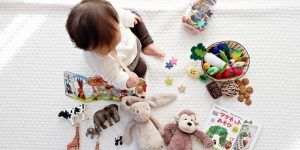
Button and jack-in-the-box toys show cause and effect, as do musical tools such as rattles and drums. Touch and feel books introduce and entertain with various textures. Kitchen and tool toys promote imaginative play.
Those are only a few examples; many items from around the house can also be used. For example, building blocks are great for creative play and stacking, but food-storage containers may work just as well and be even more interesting to the child.
There are a multitude of matching activities and games; for example, matching pot and pan lids may be an activity that benefits both a guardian and a child. Additionally, sorting household items or toys could also be another activity that is mutually beneficial.
While it’s fun to dump things out, sorting and returning objects to their original containers can also help learning and encourage participation; plus it saves from having to clean up.
Although there are countless household objects that can help to promote cognitive development, consider pre-made cognitive toy kits such as SparkleBox or KiwiCo , which are offered in a subscription-style delivery method.
Three books to enhance your understanding of cognitive development.
1. 50 Strategies to Boost Cognitive Engagement: Creating a Thinking Culture in the Classroom – Rebecca Stobaugh
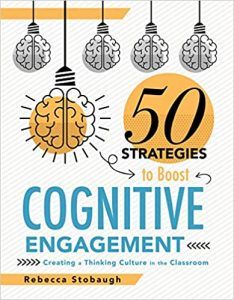
This book aims to help teachers transform their classroom into a climate that encourages active learning and student engagement.
This book also provides 50 strategies for promoting cognitive development and nurturing problem-solving and critical thinking skills.
Find the book on Amazon .
2. The Critical Mind: Enhancing Your Problem Solving, Questioning, Observing, and Evaluating Skills – Zoe McKey
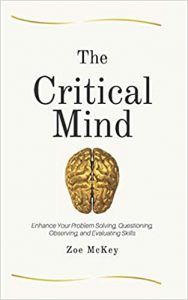
While this book may be personally beneficial to you, many of the concepts can be introduced to children and young adults.
If you yearn to be able to teach students to be self-directed, self-disciplined, self-monitored, and self-corrective thinkers, this book may be for you.
3. The Whole-Brain Child: 12 Revolutionary Strategies to Nurture Your Child’s Developing Brain – Daniel Siegel and Tina Payne Bryson
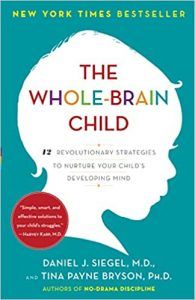
This book is advertised for parents to address behavioral concerns, but it is equally beneficial for teachers and caregivers who want to promote healthy emotional and intellectual development.
The authors provide strategies for dealing with everyday struggles and explain how adults can integrate the entire brain (left, right, upstairs, downstairs) to practice whole-brain growth.
We have a number of related articles for additional reading.
How to Improve Cognitive Function: 6 Mental Fitness Exercises presents vital information on improving cognitive function and maintaining cognitive fitness, as well as exercises and games that enhance cognitive functioning.
If you are still unconvinced of the significance of cognitive health, What Is Cognitive Health & Why Is It Important to Maintain It? brings a wealth of knowledge.
If you’re looking for more science-based ways to help others enhance their wellbeing, check out this signature collection of 17 validated positive psychology tools for practitioners. Use them to help others flourish and thrive.

17 Top-Rated Positive Psychology Exercises for Practitioners
Expand your arsenal and impact with these 17 Positive Psychology Exercises [PDF] , scientifically designed to promote human flourishing, meaning, and wellbeing.
Created by Experts. 100% Science-based.
It is crucial to understand that each child develops at their own pace and will meet milestones at different times.
Some children may require a more individualized approach and a plan to help support their cognitive development.
Further, try to provide various options. For example, children with several toys or activities to choose from can flex decision-making skills. Present choices with everyday items, such as wearing blue shoes or brown shoes. Giving children a say encourages them to feel confident in their decision-making skills and independence.
Make the student the leader of their own learning. Having well-developed cognitive skills will enable learners to become independent and self-reliant in terms of directing their learning.
As remarked by Plutarch,
“Education is not the filling of a pail, it is the lighting of a fire.”
By helping children develop their attention, perception, memory, logic, and reasoning, you are lighting the fire that will motivate them to become lifelong learners.
We hope you enjoyed reading this article. Don’t forget to download our three Positive Psychology Exercises for free .
- American Academy of Pediatrics. (2019). Adequate sleep, limited screen time can decrease impulsivity in children . Retrieved November 19, 2021, from https://www.aap.org/en/news-room/news-releases/pediatrics2/2019/adequate-sleep-limited-screen-time-can-decrease-impulsivity/
- Baek, Y., Kim, B., Yun, S., & Cheong, D. (2008). Effects of two types of sudoku puzzles on students’ logical thinking. In T. Conolly & M. Stansfield (Eds.), Proceedings of the Second European Conference on Games Based Learning (pp. 19–24). Academic Conferences.
- Balasundaram, P., & Avulakunta, I. D. (2021). Bayley Scales of Infant and Toddler Development. StatPearls . Retrieved November 12, 2021, from https://www.ncbi.nlm.nih.gov/books/NBK567715
- Blumberg, F. C., Deater-Deckard, K., Calvert, S. L., Flynn, R. M., Green, C. S., Arnold, D., & Brooks, P. J. (2019). Digital games as a context for children’s cognitive development: Research recommendations and policy considerations. Social Policy Report , 32 (1), 1–33.
- Bryan, J., Osendarp, S., Hughes, D., Calvaresi, E., Baghurst, K., & van Klinken, J. W. (2004). Nutrients for cognitive development in school-aged children. Nutrition Reviews , 62 (8), 295–306.
- Casanova, I. G., DiGirolamo, A., Kroker-Lobos, M. F., Ochaeta, L., Ramirez-Zea, M., Martorell, R., & Stein, A. D. (2021). Association between early child development trajectories and adult cognitive function in a 50-year longitudinal study in Guatemala. BMJ Open , 11 (6).
- Cowan, N. (2014). Working memory underpins cognitive development, learning, and education. Educational Psychology Review , 26 (2), 197–223.
- Doherty, M. J., Wimmer, M. C., Gollek, C., Stone, C., & Robinson, E. J. (2021). Piecing together the puzzle of pictorial representation: How jigsaw puzzles index metacognitive development. Child Development , 92 (1), 205–221.
- Donnelly, J. E., Hillman, C. H., Castelli, D., Etnier, J. L., Lee, S., Tomporowski, P., … Szabo-Reed, A. N. (2016). Physical activity, fitness, cognitive function, and academic achievement in children: A systematic review. Medicine & Science in Sports & Exercise Journal , 48 (6), 1197–222.
- Edmonds, C. J., & Burford, D. (2009). Should children drink more water? The effects of drinking water on cognition in children. Appetite , 52 (3), 776–779.
- Gertner, S., Greenbaum, C. W., Sadeh, A., Dolfin, Z., Sirota, L., & Ben-Nun, Y. (2002). Sleep–wake patterns in preterm infants and 6 month’s home environment: Implications for early cognitive development. Early Human Development , 68 (2), 93–102.
- Gluschankof, C. (2007). Research and practice in early childhood music education: Do they run parallel and have no chance to meet? The case of preschool singing repertoire. In Proceedings of European Network for Music Educators and Researchers of Young Children , 27–31.
- Hidayati, N. (2020). Designing the Arabic crossword puzzles for the first, second, and third grade of the “Mambaul Ulum” Islamic elementary school malang. Al-Arabi: Journal of Teaching Arabic as a Foreign Language , 4 (2), 245–258.
- Hooper, S. R., Conner, R. E., & Umansky, W. (1986). The Cattell Infant Intelligence Scale: A review of the literature. Developmental Review , 6 (2), 146–164.
- Kim, C. S., Chun, W. Y., & Shin, D. M. (2020). Dehydration impairs physical growth and cognitive development in young mice. Nutrient s, 12 (3), 670.
- Koshy, V., & Sharma, S. D. (1984). Standardisation of the Cattell’s Infant Intelligence Scale in India. Indian Journal of Psychiatry , 26 (4), 327–330.
- Lobo, M. A., & Galloway, J. C. (2013). Assessment and stability of early learning abilities in preterm and full-term infants across the first two years of life. Research in Developmental Disabilities , 34 (5), 1721–1730.
- Lu, Y., Yeung, W. J. J., & Treiman, D. J. (2020). Parental migration and children’s psychological and cognitive development in China: Differences and mediating mechanisms. Chinese Sociological Review , 52 (4), 337–363.
- Malik, F., & Marwaha, R. (2021). Cognitive development. StatPearls . Retrieved November 21, 2021, from https://www.ncbi.nlm.nih.gov/books/NBK537095/
- McKey, Z. (2019). The critical mind: Enhance your problem solving, questioning, observing, and evaluating skills. Author.
- Peskin, J., & Ardino, V. (2003). Representing the mental world in children’s social behavior: Playing hide-and-seek and keeping a secret. Social Development , 12 (4), 496–512.
- Piaget, J. (1964). Part I: Cognitive development in children: Piaget development and learning. Journal of Research in Science Teaching , 2 (3), 176–186.
- Samuel, R. D., Zavdy, O., Levav, M., Reuveny, R., Katz, U., & Dubnov-Raz, G. (2017). The effects of maximal intensity exercise on cognitive performance in children. Journal of Human Kinetics , 57 , 85–96.
- Siegel, D. J., & Bryson, T. P. (2011). The whole-brain child: 12 Revolutionary strategies to nurture your child’s developing mind. Delacorte Press.
- Smithson, L., Baird, T., Tamana, S. K., Lau, A., Mariasine, J., Chikuma, J., … Mandhane, P. (2018). Shorter sleep duration is associated with reduced cognitive development at two years of age. Sleep Medicine , 48 , 131–139.
- Stobaugh, R. (2019). 50 Strategies to boost cognitive development: Creating a thinking culture in the classroom. Solution Tree Press.
- Styles, E. (1997). The psychology of attention . Psychology Press.
- Sulaiman, T., Muniyan, V., Madhvan, D., Hasan, R., & Rahim, S. S. A. (2017). Implementation of higher order thinking skills in teaching of science: A case study in Malaysia. International Research Journal of Education and Sciences , 1 (1), 2550–2158.
- Sunderland, M. (n.d.). Games to improve working memory . Retrieved November 21, 2021, from https://homeschoolingwithdyslexia.com/wp-content/uploads/Working-Memory-Games.pdf
- Supartini, T., & Weismann, I. T. J. (2020). Development of learning methods through songs and movements to improve children’s cognitive and psychomotor aspects. European Journal of Educational Research , 9 (4), 1615–1633.
- Venkatesan, S., & Lokesh, L. (2020). Studying the effects of Porteus Maze Test in children with learning disabilities. International Journal of Asia Pacific School Psychology , 1(2), 117–125.
- Weisberg, D. S. (2015). Pretend play. Wiley Interdisciplinary Reviews: Cognitive Science , 6 (3), 249–261.
- Yilmaz, R. M. (2016). Educational magic toys developed with augmented reality technology for early childhood education. Computers in Human Behavior , 54 , 240–248.
Share this article:
Article feedback
What our readers think.
Are use this to refresh in my mind from my degree in secondary social science, education. I’m using the S the early parts for my new six month old granddaughter, and I had forgotten all of this stuff from 27 years ago in college. The next thing I will probably buy is the Piaget book of child development stages of child development, and several of the other sources that you cited. Thanks for the really great touchup on behavior therapy. It has totally changed my outlook on my granddaughter. I knew these things 25 years ago when I was raising a child, but not using them has made it slip from my memory. Now at least, I can give my daughter the short version. Thanks
Let us know your thoughts Cancel reply
Your email address will not be published.
Save my name, email, and website in this browser for the next time I comment.
Related articles
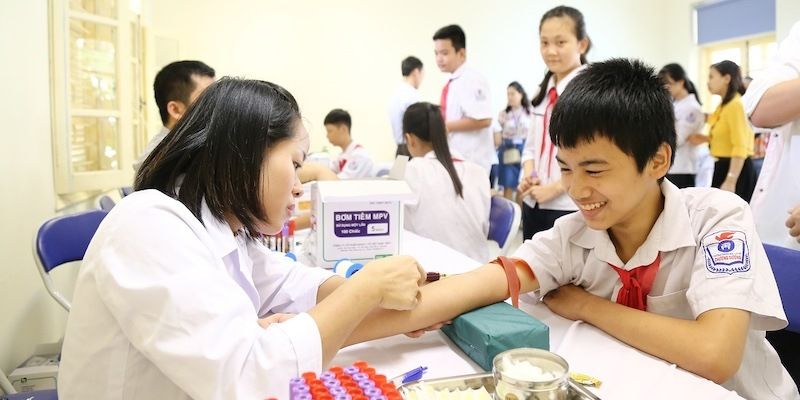
What Is the Health Belief Model? An Updated Look
Early detection through regular screening is key to preventing and treating many diseases. Despite this fact, participation in screening tends to be low. In Australia, [...]

Positive Pain Management: How to Better Manage Chronic Pain
Chronic pain is a condition that causes widespread, constant pain and distress and fills both sufferers and the healthcare professionals who treat them with dread. [...]

Mental Health in Teens: 10 Risk & Protective Factors
31.9% of adolescents have anxiety-related disorders (ADAA, n.d.). According to Solmi et al. (2022), the age at which mental health disorders most commonly begin to [...]
Read other articles by their category
- Body & Brain (49)
- Coaching & Application (57)
- Compassion (26)
- Counseling (51)
- Emotional Intelligence (24)
- Gratitude (18)
- Grief & Bereavement (21)
- Happiness & SWB (40)
- Meaning & Values (26)
- Meditation (20)
- Mindfulness (45)
- Motivation & Goals (45)
- Optimism & Mindset (34)
- Positive CBT (28)
- Positive Communication (20)
- Positive Education (47)
- Positive Emotions (32)
- Positive Leadership (18)
- Positive Parenting (4)
- Positive Psychology (33)
- Positive Workplace (37)
- Productivity (16)
- Relationships (46)
- Resilience & Coping (36)
- Self Awareness (21)
- Self Esteem (38)
- Strengths & Virtues (32)
- Stress & Burnout Prevention (34)
- Theory & Books (46)
- Therapy Exercises (37)
- Types of Therapy (64)
3 Positive Psychology Tools (PDF)
Internet Explorer is no longer supported
Please upgrade to Microsoft Edge , Google Chrome , or Firefox .
Lo sentimos, la página que usted busca no se ha podido encontrar. Puede intentar su búsqueda de nuevo o visitar la lista de temas populares.
Get this as a PDF
Enter email to download and get news and resources in your inbox.
Share this on social
Teaching kids how to deal with conflict.
Tips for building lifelong skills
Writer: Juliann Garey
Clinical Experts: Stephanie A. Lee, PsyD , Carey Werley, LCSW
What You'll Learn
- How can parents help kids deal with the big feelings that come from conflict?
- What does problem-solving look like with young kids?
- How can kids learn to communicate better?
It’s hard to solve a problem when you’re so angry you can’t think straight. That’s why helping kids learn to solve conflicts starts with helping them calm down.
First, they need to recognize their emotions. Young kids might have a hard time naming their feelings. It can help to have a feelings chart to look at. A stoplight can also work. A red light means emotions are big and they need time to cool off. A yellow light means they’re beginning to calm down. Green means they’re ready to solve the problem.
You can help your child come up with tools to calm down. They might splash some water on their face, take some deep breaths or play with a pet. When they’re ready to focus, you can help them find the source of the conflict. This can be hard for younger children. The fight may have started with a toy, but it might really be about something bigger.
Have your child pitch some solutions to their conflict. Then you can both pick out which are best. Remind them that the best option isn’t just the one that feels best. It’s also the one that gets them to their goal. It’s good to praise your child for their efforts to fix a problem, even when they don’t pan out.
Learning to say what you need in a way others understand is an important problem-solving tool. “I” statements, like “I felt sad when you didn’t sit with me,” are also a good tool. Kids can even role-play with a grownup who can give feedback. It’s good to teach these skills when your child’s not in the middle of a conflict. It’s important to model these skills for your child, too. You can walk them through how you’d solve your own problem step by step.
No one likes dealing with conflict. But no matter how hard we try to avoid them, arguments, fights and disagreements are a fact of life — for adults and for kids. And not dealing with conflicts when they arise can negatively impact relationships and lead to further interpersonal challenges down the road.
Conflict may not be pleasant, but it doesn’t have to feel catastrophic. Teaching kids practical skills to manage it in a healthy way will help them navigate everything from small squabbles (“ She took my doll!” ) to big issues ( “I don’t know if I want to be your friend anymore” ) both now and as they grow up.
Tackle feelings first
Part of what makes conflicts difficult to navigate is the way they bring out big, intense emotions that children may not have the tools to process. Before they can address the problem that caused the conflict — whether it was a fight over a toy or betrayal by friend — kids need to be able to get to a place emotionally where they can think before they act (or lash out and make things worse).
Parents can start by helping kids identify the emotions they’re having. Are they feeling anger? Frustration? Hurt? Embarrassment? Stephanie Lee , PsyD, a child psychologist, and Carey Werley , LCSW, a clinical social worker at the Child Mind Institute, recommend using visual tools to help little kids identify what they’re feeling.
- Visual feelings chart : Typically, this is a chart showing facial expressions that illustrate different emotions. “You can buy magnetized charts, which are a handy addition to the refrigerator and which help kids identify what they’re feeling,” says Werley.
- The stoplight: A visual red, yellow and green stoplight is especially helpful for little kids. “If a little kid looks at the stoplight and points to the red zone, then the feelings are so big that they’re probably not going to be able to act in a way that’s going to resolve the conflict yet,” says Werley. “Yellow means the intensity of the emotion is beginning to subside and by the time they get to green, they’re going to be able to engage in actual conflict resolution skills. It’s about helping kids to not act in a way that’s going to make the situation bigger or worse.”
- The emotion thermometer: Easily Googleable, the emotion thermometer is simply a picture of a thermometer with numbers. When conflicts come up, kids can look at the emotion thermometer to assess where they are on it. Based on the number, the child can decide whether they need to calm down before proceeding. Tweens and teens who’ve learned these techniques can simply visualize the stoplight or thermometer in their minds in order to assess their emotional state.
When emotions are still intense, it’s not the right time to problem-solve about the conflict itself. Help kids come up with a toolbox of coping skills to use if they need to calm down in the heat of the moment. This might mean splashing cold water on your face, taking some deep breaths or playing with a pet.
Pinpoint the source of the conflict
Once big emotions have cooled down, the next step is figuring out exactly what the problem is. Sometimes kids, especially younger ones, don’t have the emotional awareness to identify the original source of the conflict. They might need your help to understand why they’re fighting. For example, if your child and their friend are squabbling over a toy, the issue might be much deeper, explains Werley. “It could actually be that one of them made a new friend and the other feels left out,” she says.
Helping kids get to the root of the issue will make it easier for them to resolve what’s actually wrong. It will also give them tools to identify and talk about similar problems when they come up again. Older kids starting in grade school and middle school are more likely to have the language to identify the source of the conflict, so with a little guidance they can learn to use these skills independently going forward.
Brainstorm solutions
Once kids understand what the issue is, you can help them practice finding solutions. Little kids in particular will need a grown-up’s guidance here, but even older kids and teenagers can benefit from having someone to bounce ideas of off.
For any age, Dr. Lee suggests brainstorming several solutions then putting your heads together to pick the best one. For younger kids, she recommends a couple of ways to structure this conversation:
- Problem-solving baseball: This exercise takes kids through the processing of thinking up and evaluating possible action plans. “I have kids pitch me a problem and then we go through the bases,” Dr. Lee explains. “So, first base is what’s my problem? Second base is what are some potential options? Third base identifies the best options. And home plate is, am I safe or out? Did I pick the right one? The object is to help even very young kids start to understand what is going to get them closest to their goal.”
- The smiley face rating: Lee suggests asking your child to come up with possible conflict resolution options and then asking, “Is this behavior going to make you feel better or worse or pretty much the same?” Note the answer using a visual rating: smiley face, frowny face, neutral? “And then we look at all of our smiley ratings to help us decide which one is the best option. But also explain to them that it’s not just about how you feel, it’s about whether or not it’s going to help you to reach your goal.”
Of course, the tricky thing here is that it’s usually hard to know what the best option really is. And that’s okay! Let kids know that the goal is to make your best effort , not to solve everything perfectly right away. They might have to go back to the drawing board if their first plan doesn’t pan out — often, that’s just part of the process. “You also want to jump in and praise your child for trying those skills even if things didn’t work out as they had hoped,” says Dr. Lee. “Give them credit and then help them navigate from there. And when they do figure it out, make a big deal out of that.”
Get some perspective
Conflicts often feel enormous and immediate, which can make it hard to keep perspective on the situation. To find useful solutions, it’s important for kids to practice taking a mental step back. A few tips you can encourage kids to keep in mind include:
- Think beyond this one incident. If a close friend tells a secret you trusted them with, it’s natural to be upset. But does that really mean that the friendship is over? Encourage your child to consider the rest of their relationship with the person they’re in conflict with, and remind them that one behavior doesn’t define the entire person.
- Put yourself in the other person’s shoes. “You want to really work on acknowledging what the other person is saying,” says Werley. “even if you don’t totally understand why they’re feeling that way or don’t agree with the way that they’re describing the situation.” Imagining what the other person is feeling is a great way to help kids develop empathy. Depending on the situation, it might also make sense for your child to talk over the issue with the other person and make a point of listening actively — without interrupting. Practicing these skills can help kids resolve conflicts in the short term and become more empathetic in the long term.
- Consider the context. The time and place of the conflict will often dictate how kids respond to it, as will the nature of their relationship to the other person. In particular, Dr. Lee notes that it’s important for kids to know that conflicts with adults will often look different from conflicts with other kids. For example, a child who gets angry with a teacher during class might have to sit with those feelings until it’s possible to set up a private meeting with the teacher. Taking a step back to consider all the dynamics of a situation will set kids up to navigate the conflict more successfully.
Practice effective communication
In order to resolve a conflict, kids need to learn to communicate their feelings clearly, without lashing out or making accusations. It’s tough to practice communication skills when tensions are running high, so consider talking over these skills with kids when they’re not already in the midst of a conflict. Then, you can provide gentle reminders and guidance when things do get heated. Werley and Dr. Lee recommend the following strategies:
- Using “I” statements to name feelings. You’ve heard it before, but it’s still true: Saying something like, “I felt embarrassed when you posted that on Instagram” is usually more helpful than something like, “You posted that picture just to embarrass me!”
- Writing out talking points. “ Even if it’s just planning out a conversation in their journal, thinking through what to say ahead of time can help kids get their points across effectively,” says Werley.
- Role-playing with an adult. “Having a safe space to practice tricky conversations can be a huge help,” says Dr. Lee. You can also offer your child insight on nonverbal communication that they might not be aware of — e.g., “What you said was really kind, but I had a harder time appreciating it because you were looking at the ground.”
Model what you want to see
One of the most powerful things you can do to help your child learn conflict resolution is to show them how it’s done. When you experience a conflict of your own (especially one with your child!), put the techniques described here into practice. When appropriate, you can even talk your child through how you solved the conflict. Seeing you succeed — and make mistakes along the way! — shows kids that solving conflicts really is doable, even when it’s hard.
Frequently Asked Questions
Conflict resolution in young kids starts with helping them to calm down. First, they need to recognize their emotions. Then they might splash some water on their face, take some deep breaths or play with a pet. When they’re ready to focus, you can help them find the source of the conflict.
You can help your child with conflict resolution by pitching some solutions to their conflict. Then you can both pick out which are best. It’s also good to praise your child for their efforts to fix a problem, even when they don’t pan out.
A good conflict resolution technique for kids is learning to say what you need in a way others understand. “I” statements, like “I felt sad when you didn’t sit with me,” are also a good tool. Kids can even role-play with a grownup who can give feedback.
Was this article helpful?
Explore popular topics, subscribe to our newsletters.
" * " indicates required fields

Don’t Miss Out
Sign up for more articles and parenting tips direct to your inbox.

10 of the Best Children’s Books That Promote Critical Thinking
Mikkaka Overstreet
Mikkaka Overstreet is from Louisville, Kentucky by way of Saginaw “Sagnasty”, Michigan. She has been an educator since 2006 and earned her PhD in Curriculum and Instruction in 2015. By day she is a mild-mannered literacy specialist. By night she sleeps. In between, she daydreams, writes fiction, and reads books. She currently lives in North Carolina with her husband and cats.
View All posts by Mikkaka Overstreet
If you’re reading a post about children’s books that promote critical thinking, I assume you see the value in raising strong thinkers. Whether you’re a caregiver, educator, or potential employer, you want society’s children to develop complex reasoning and problem solving skills. These qualities benefit us all.
Unfortunately, there are people and groups more interested in an industrious than a thoughtful population. The general public doesn’t agree on the purpose of public education . Neither, it seems, do education stakeholders. During recent remarks, North Carolina state Superintendent of Public Instruction Catherine Truitt declared 2022 “the year of the workforce.”
Truitt explained, “We have got to redefine what the purpose of K–12 education is. Some would say it’s to produce critical thinkers, but my team and I believe that the purpose of a public K–12 education is to prepare students for the postsecondary plans of their choice so that they can be a functioning member of the workforce.”
While that statement makes my skin crawl, it’s more than unsettling: it’s contradictory. Employers regularly cite problem-solving and critical thinking skills as ideal qualities they seek in employees. According to a study from the Association of American Colleges and Universities , 95% of employers view critical thinking specifically as “very important” or “somewhat important.” Thus, preparing kids to think critically is preparing them for the workforce — and beyond.
Undoubtedly, our society needs more critical thinkers . We have lots of problems, both old and new, that will require innovative solutions. The following books will help encourage the next generation of big thinkers.
Thank you for signing up! Keep an eye on your inbox. By signing up you agree to our terms of use
10 Children’s Books That Promote Critical Thinking
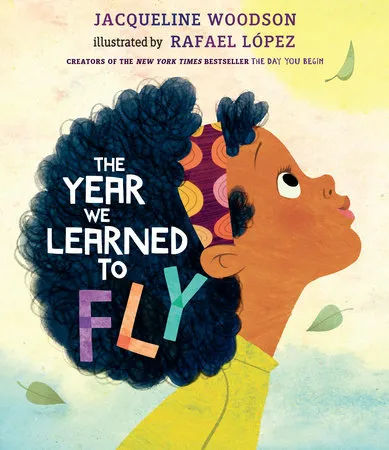
The Year We Learned to Fly by Jacqueline Woodson and Rafael López
The incomparable Jacqueline Woodson has done it again. In this newly released children’s book, readers journey into the vivid imaginations of the central characters. Woodson tells the story of children stuck inside because of bad weather. Rather than succumb to boredom, the children use their imaginations to escape the confines of their apartment. Surely, this will inspire children to dream big.
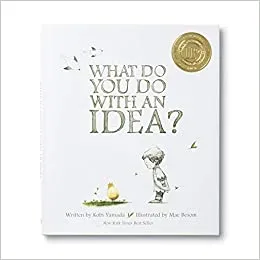
What Do You Do With An Idea? by Kobi Yamada and Mae Besom
This inspiring picture book centers on a child with an idea. We get to follow the child as they nurture the idea and watch it grow. Undoubtedly, this simple story will resonate with anyone who has ever been afraid to share their big dreams with the world.
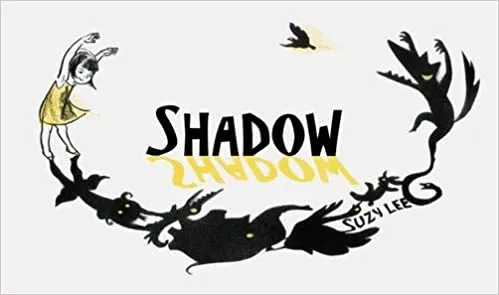
Shadow by Suzy Lee
This gorgeous wordless picture book is a guaranteed hit. The young protagonist uses her imagination and her shadow to create a fantasy world. Mirrored illustrations show both the true objects and the magical world the girl has built.
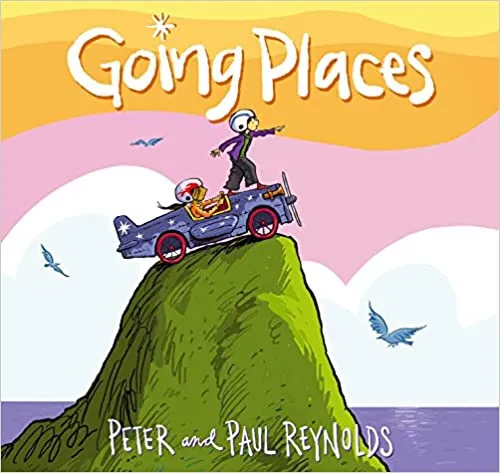
Going Places by Peter H. Reynolds and Paul A. Reynolds
I’m a big fan of Peter H. Reynolds’s work. He has a whimsical style and encourages creativity and self-love in his several excellent picture books. In this story, written with his twin brother, Reynolds introduces us to another uniquely wonderful protagonist. Maya enters a go-cart competition and must create a winning vehicle out of one of the identical kits given to all contestants. Of course, Maya doesn’t think inside the box she’s given. This is another fun story with a great lesson.
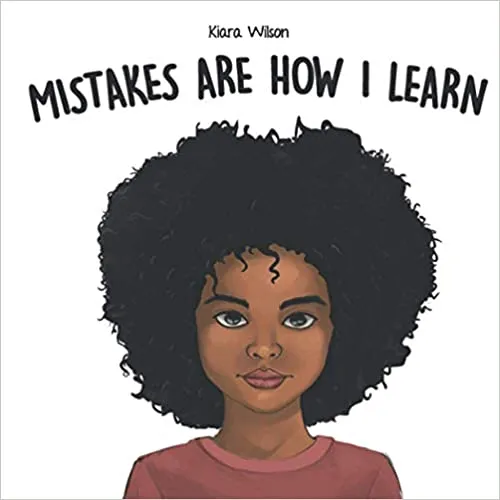
Mistakes Are How I Learn by Kiara Wilson
As we all know, mistakes are a part of the learning process. In this encouraging book, Wilson reminds kids to give themselves grace and space to make mistakes. Similar to The Girl Who Never Made Mistakes , this book is a good reminder for little perfectionists.
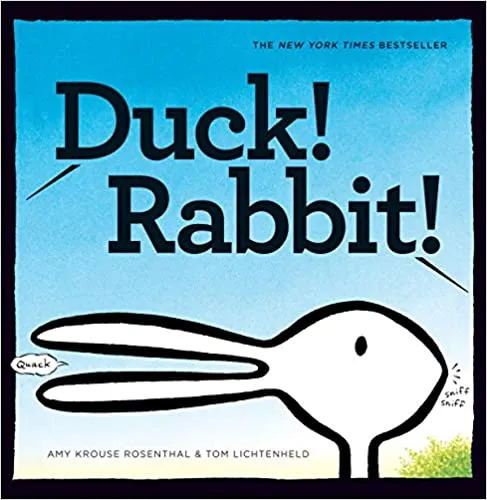
Duck! Rabbit! by Amy Krouse Rosenthal and Tom Lichtenheld
This picture book takes the well-known duck or rabbit puzzle and tells a story. Obviously, readers will feel compelled to see both sides of this argument. This is a humorous introduction to considering varying viewpoints.
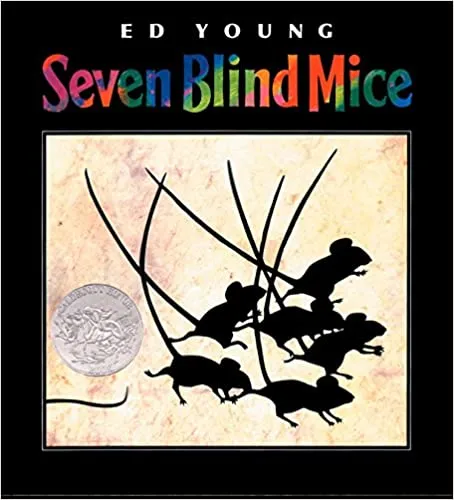
Seven Blind Mice by Ed Young
In this Caldecott Honor winner, seven blind mice try to determine the identity of an unfamiliar object. In Young’s take on the classic Indian tale, each mouse only gathers partial information. Of course, it takes the wisdom of the seventh mouse to put the pieces together and solve the puzzle.
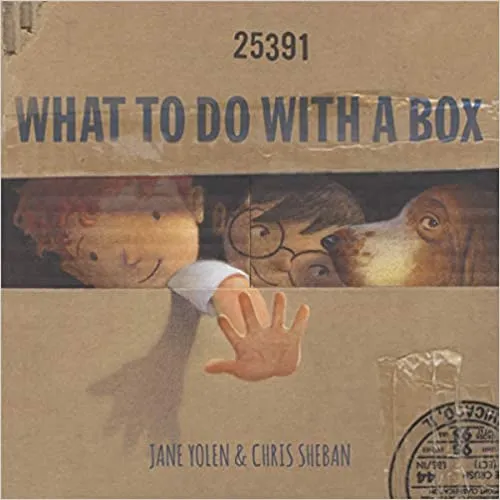
What To Do With A Box by Jane Yolen and Chris Sheban
You can probably guess what’s going to happen in this book, right? Clearly, there’s a metaphor here. Enjoy all the things a child can imagine with outside-of-the-box thinking in this rhythmic tale.
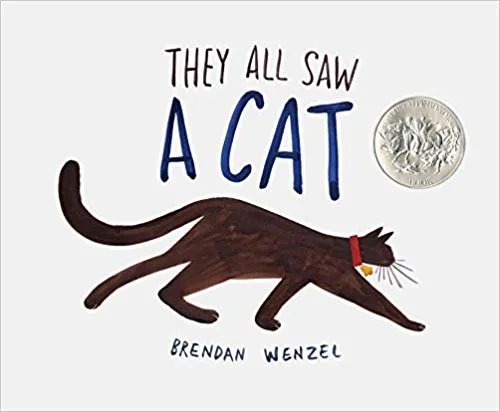
They All Saw A Cat by Brendan Wenzel
This book brilliantly executes a creative concept. Using strange and gorgeous illustrations, Wenzel depicts how differently individuals can perceive the same object. Consequently, readers are pushed to consider multiple viewpoints and how our perceptions color what we see.
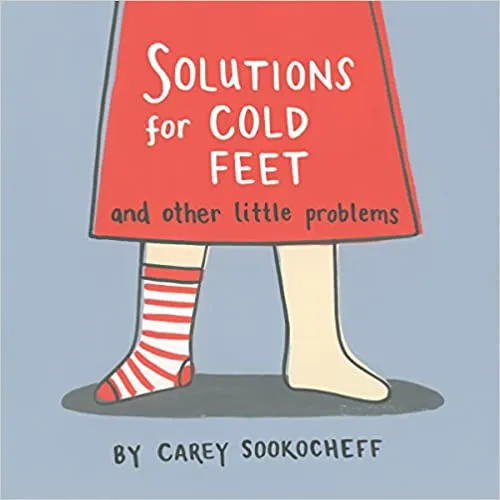
Solutions for Cold Feet and Other Little Problems by Carey Sookocheff
Follow one little girl and her dog through the challenges of a normal day in this fun story. The girl asks lots of questions and persists when she encounters problems. This tale will inspire kiddos to see problem-solving as a positive and necessary part of life.
Hopefully, you’ve found something on this list that inspires you to think and dream. If you’d like more content like this, check out 7 Board Books for Woke Babies and 10 Science Books for Curious Kiddos . Read, think, and dream BIG!

You Might Also Like

- Prodigy Math
- Prodigy English
- Is a Premium Membership Worth It?
- Promote a Growth Mindset
- Help Your Child Who's Struggling with Math
- Parent's Guide to Prodigy
- Assessments
- Math Curriculum Coverage
- English Curriculum Coverage
- Game Portal
45 Fun and Clever Brain Teasers for Kids with Answers!

Written by Laney Kennedy
Reviewed by Sarah Tino, M.Ed.
Engage and motivate your students with our adaptive, game-based learning platform!
- Game-Based Learning
- What brain teasers are
- The benefits of brain teasers for kids
Math brain teasers for kids
Sometimes keeping your students engaged during a (long) school day feels like a losing battle. How do you gain their full attention while teaching the skills they need to succeed? How do you turn tough and intimidating concepts into fun, entertaining lessons that actually spark life in the classroom?
Brain teasers for kids are a great form of game-based learning that not only entertain children but also inspire some creative thought in the classroom. People of all ages can indulge in these playful — yet challenging — activities.
And some examples of when teachers might want to use brain teasers are on a bulletin board in the classroom, as a partnered activity to start a new concept or lesson, or during a rainy day indoor recess box.
We’ve gathered 45 examples of brain teasers for kids with answers, organized by category:
Table of Contents
Language brain teasers for kids :
Riddles ; Language associations ; Lateral thinking problems.
Math brain teasers for kids :
Math riddles ; Pattern problems ; Prodigy.
Visual brain teasers for kids :
Spot the difference ; Rebus puzzles ; Optical illusions ; Stroop effect test.
Use the list below to find the perfect brain teaser for your class!
What are brain teasers?
Before you explore our examples, you might be wondering what brain teasers actually are.
Cambridge Dictionary defines a brain teaser as “a problem for which it is hard to find the answer, especially one which people enjoy trying to solve as a game.”
Brain teasers are a type of puzzle — and as the list below reveals, they come in many different forms. Often presented as a riddle, question or activity, brain teasers require a little extra brainpower to solve.
It's important to note that if you have any English language learners in your class, brain teasers for kids might pose a challenge for them. If that's the case, they might need you to walk them through the brain teaser more closely, or you can find ones that better suit their language level.
Brain teasers for kids differ from other complex or abstract problems because they’re usually done for fun. Although you can use them to analyze problem-solving and critical thinking skills, they’re often used as an amusing activity to encourage logical and lateral thinking , or thinking “outside the box.”
45 Brain teasers for kids
We’ve compiled a list of language, math and visual brain teasers to get your students thinking. Get inspired by the examples below — including answers!
Language brain teasers for kids
When you hear the term “brain teaser,” a riddle is likely the first thing that comes to mind. Riddles are perplexing — sometimes misleading — questions or statements that require creative thought to solve.
Riddles are usually fun, and plenty of them can add some humour to your classroom.
Enjoy our list of riddles for kids below!
a) Billy’s mother had five children. The first was named Lala, the second was named Lele, the third was named Lili, the fourth was named Lolo. What was the fifth child named?
b) Choose the correct sentence: “The yolk of the egg is white” or “the yolk of the egg is white.”
c) It’s as light as a feather, but the strongest person can’t hold it for more than five minutes. What is it?
d) The more there is, the less you see. What is it?
e) What gets more wet while it dries?
f) You can find it in Mercury, Earth, Mars, Jupiter and Saturn, but not in Venus or Neptune. What is it?
g) It likes food, but water kills it. What is it?
h) What’s full of holes but can still hold water?
i) Which is heavier, a pound of feathers or a pound of rocks?
j) How far can a dog run into the woods?
k) You’re driving a city bus. At the first stop, three women get on. At the second stop, one woman gets off and a man gets on. At the third stop, two children get on. The bus is blue and it’s raining outside in December. What colour is the bus driver’s hair?
l) There are three houses. One is red, one is blue and one is white. If the red house is to the left of the house in the middle, and the blue house is to the right of the house in the middle, where’s the white house?
m) It’s at the center of gravity and you can find it in Venus, but not Mars. What is it?
n) What goes on four feet in the morning, two in the afternoon and three in the evening? (This is from the classic myth, Oedipus and the Riddle of the Sphinx )
o) What travels faster: heat or cold?
p) A man was walking in the rain in the middle of nowhere without a coat or an umbrella. He got soaked, but not a single hair on his head was wet. How can this be?
q) A cowboy rode into town on Friday. He stayed in town for three days and rode back out on Friday. How is this possible?
b) Neither. Egg yolks are yellow, not white!
f) The letter “R”
h) A sponge
i) Neither. Both weigh a pound!
j) Halfway. Once it reaches halfway, it’s running out of the woods.
k) Whatever colour your hair is. Remember, you’re driving the bus!
l) In Washington, D.C.
m) The letter “V”
n) A human. The times of day represent stages of human life. At the beginning of life, a baby crawls on four “feet.” As a person gets older, they walk on two feet. Later in life, a person will walk on three “feet” (two feet, plus a cane to help them walk).
o) Heat travels faster because you can catch a cold!
p) He was bald.
q) The horse’s name was Friday.
As a bonus, use these riddles to challenge preconceived notions and get students thinking about natural bias .
a) Two boxers are in a match scheduled for 12 rounds. (Pure boxing only - no kicking, UFC takedowns, or anything else). One of the boxers gets knocked out after only six rounds, yet no man throws a punch. How is this possible?
b) A father and son have a car accident and both are very injured. They are taken to separate hospitals for treatment. When the boy is taken in for an operation, the surgeon says, “I can’t do this surgery…. this boy is my son!” How is this possible?
a) The two boxers are women.
b) The surgeon is the boy’s mother.
2. Language associations
These brain teasers for kids explore the complexities of the English language. Use them to boost student knowledge of sounds, words, spelling, categorization and more.a) Word association : find a word that associates with the following sets of words.
- Cake, swiss, cottage
- Glasses, screen, day
- Cream, cube, cap
- Knife, fly, cup
b) Find the mystery word . Replace the third letter of each word with a new letter to create a different word. When read vertically, the new letters will reveal the mystery word.
For example, the word MA K E could become MA R E, MA L E, MA T E and so on. It’s your job to figure out which one works to create the mystery word.
Hint: It’s something you’ll find outside.
c) Find rhyming pairs . Unscramble the words below so that each pair of words rhymes.
- RBAE & HREAS
- WNROED & UTRHNDE
- TUGHAT & HBTUGO
- ODULC & ODOG
Mystery word: FLOWER
- BEAR (or BARE) & SHARE
- WONDER & THUNDER
- TAUGHT & BOUGHT
- COULD & GOOD
You can also use printable brain teasers for kids like this one:
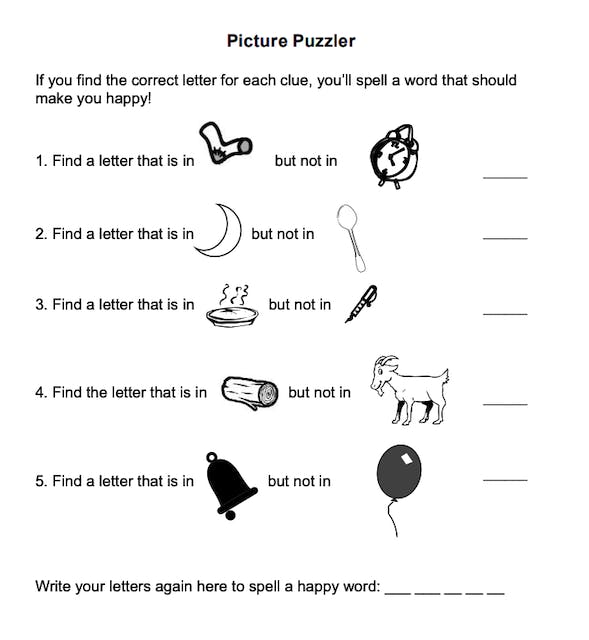
Image source: Spelling Words Well
Answer: The “happy word” is SMILE.
3. Lateral thinking problems
Lateral thinking problems require creative thinking with an indirect approach.
These questions require logic and careful thought to solve. The most notable example of a lateral thinking problem is the classic Monty Hall problem .
Here are two examples of lateral thinking problems kids can try to solve.
a) The river crossing problem
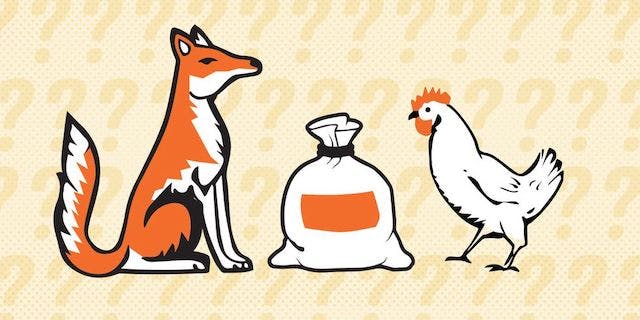
Image source: Popular Mechanics
A farmer is travelling with a fox, a goose, and a bag of beans. During his journey, he comes across a river with a boat to cross it.
The farmer can only fit one thing in the boat with him at a time. If left alone together, the fox will eat the goose or the goose will eat the beans. How does the farmer get everything across the river safely?
b) The light bulb problem

There are three light switches outside of a room-- labeled number one, number two, and number three. The door to the room is closed and you can’t see in. All three switches are off.
You need to figure out which switch belongs to which bulb. You can use the switches however you want to, but can only enter the room once. How do you do it?
a) Here’s the step-by-step solution:
- The farmer brings the goose across the river first (if he leaves the goose alone, it will either eat the beans or be eaten by the fox).
- The farmer brings either the fox or the beans across and leaves the other one alone.
- Now the farmer has two items on the other side of the river, including the goose. If he leaves the goose again, the same problem will occur. So, the farmer must bring the goose back to the other side.
- The farmer brings the other item back (either the fox or the beans) and leaves the goose alone again. The fox and the beans are now on the other side of the river.
- The farmer returns and brings the goose across the river again.
b) Turn on the first switch and leave it on. Turn on the second switch for a few minutes, and then turn it off again. When you enter the room, one light bulb will be on. You’ll know it goes with switch one because you turned it on. Another bulb will be hot. You’ll know that goes with switch two because it was on for a little while. The bulb that’s off and cold goes with switch three because you didn’t touch it.
Like math puzzles , these brain teasers for kids can increase engagement with math content and inspire your students to work on math concepts and problems outside of regular lessons.
1. Math riddles
These riddles are just as amusing as the ones above, but they’re math-focused . Use them to give students some extra math practice and encourage resourceful thinking.
Math riddles
a) Divide 30 by ½ and add 10. What’s the answer?
b) A clerk at the butcher shop is six feet tall and wears size 10 shoes. What does he weigh?
c) A farmer has 19 sheep on his land. One day, a big storm hits and all but seven run away. How many sheep does the farmer have left?
d) Your sock drawer only contains 18 white socks and 18 blue socks. How many times do you need to reach inside the drawer and take out a sock to guarantee a matching pair?
e) You planted sunflower seeds in your back garden. Every day, the number of flowers doubles. If it takes 52 days for the flowers to fill the garden, how many days would it take for them to fill half the garden?
f) Using only addition, how can you use eight eights to get the number 1,000?
g) When Ashley was 15, her mother was 37. Now, her mother is twice her age. How old is Ashley?
a) It's 70. You’re dividing 30 by ½, not by two. Thirty divided by ½ is the same thing as multiplying it by two, which is 60. Plus 10 makes 70!
b) Meat. He works at the butcher shop, so he weighs meat for a living.
c) Seven. The riddle says all but seven run away, meaning there are seven left who didn’t.
d) Three times. On the third time, you’ll get either a white or a blue sock to match with one of the other two you’ve already grabbed.
e) It would take 51 days. If the number of flowers doubles every day, half the garden would be full the day before, on the 51st day.
f) 888 +88 +8 +8 +8
g) Ashley is 22. Her mother is 22 years older, so when Ashley is 22, she’s now half her mother’s age.
2. Pattern problems
These questions require students to identify a pattern before they can answer a particular question. Kids must use creative and logical thinking to find the answers.
4 + 4 = 168
5 + 5 = 2510.
b) What makes this number unique: 8,549,176,320?
c) Solve the pattern puzzle below. Find the missing number to replace the question mark.
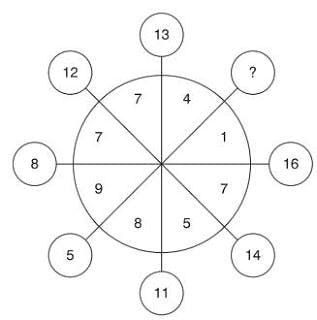
Image source: Genius Puzzles
d) Solve the following:
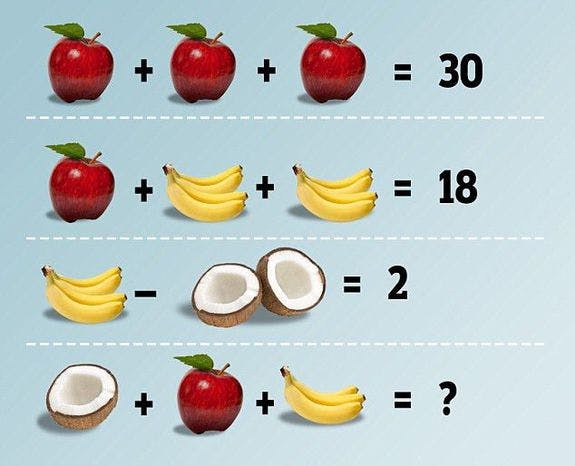
Image source: AOL
a) The missing number is 3612. The answer is the number multiplied by itself and then the number added to itself. Six multiplied by six is 36, and six plus six is 12.
b) It contains each one-digit number, zero through nine, listed in alphabetical order.
c) The missing number is 17. Each number in the circle is the sum of the numbers in the opposite quadrant. In this case, the numbers are eight and nine — added together makes 17.
d) The answer is 14 (or 16), if you’re on the other side of the debate .
3. Prodigy Math Game
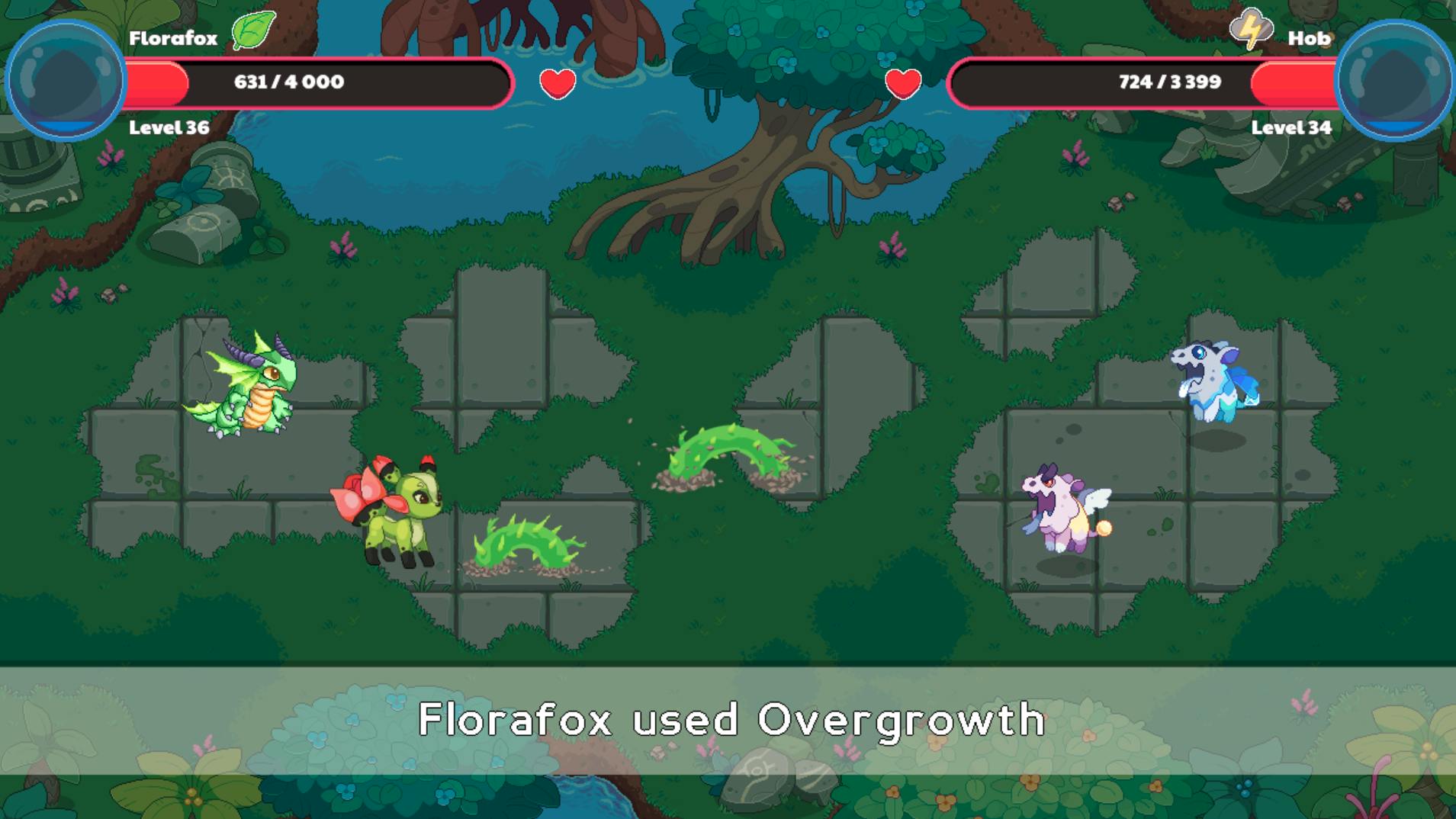
This math activity is a bit different from others on the list. It’s not a traditional brain teaser, but it can also be used as a fun, skill-building alternative to traditional math class.
Prodigy is a game-based learning platform that takes your students on an online fantasy adventure while they answer standards-aligned math questions. It’s engaging and effective at teaching necessary skills.
Prodigy's free teacher tools help you differentiate learning, send assessments in-game and even collect student insights!
Visual brain teasers for kids
1. spot the difference.
This ever-popular activity might remind you of your own childhood — and kids still love it! Spot the difference puzzles require lots of deduction and attention to detail.
Here’s an example of a printable spot the difference activity.
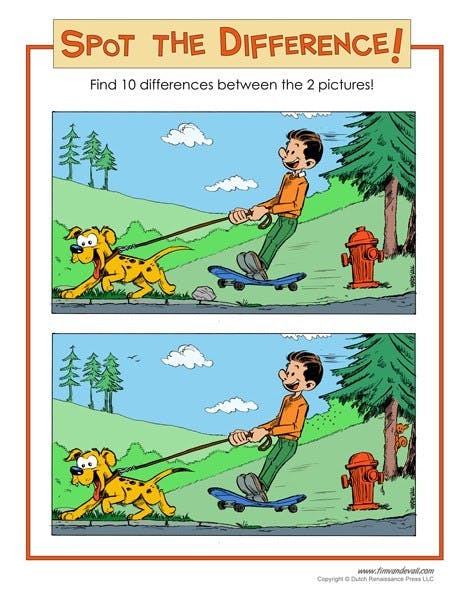
Image source: Tim’s Printables
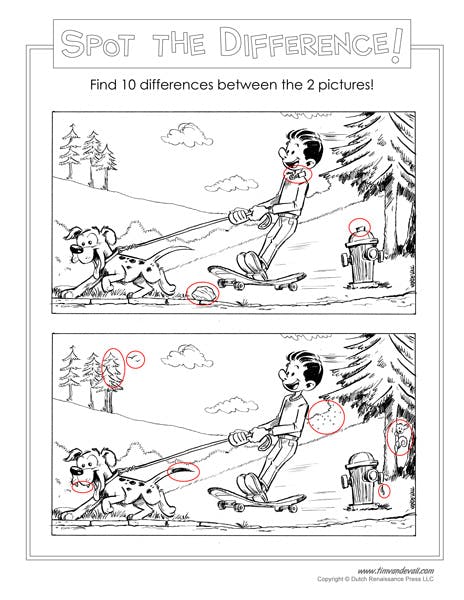
2. Rebus puzzles
A rebus is a visual word puzzle that uses lateral thinking to find its intended meaning. The word or phrase is depicted with a visual illustration, including letters and words. Students must think creatively to figure out the meaning from the clues they’re given.

Image source: Wikipedia

Image source: Stack Exchange
a) Top secret
b) Think outside the box
Visit the link below if you want more fun rebus puzzles for your students:
3. Optical illusions
Get tricky with your students! Optical illusions use visual tricks that alter the perception of what you’re really seeing. Students will love trying to figure out what’s really going on in these examples.
a) How many legs does the elephant have?

Image source: Optics For Kids
b) Are the two squares different colours?
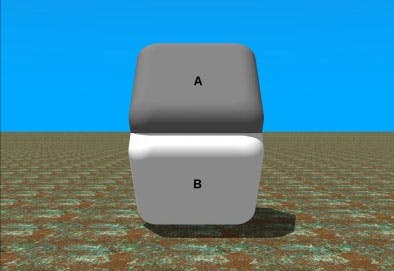
Image source: Brain Den
b) They’re exactly the same colour. If you place your finger over the spot where the squares meet, you can see they’re the same. Try this impossible paper puzzle if you want a more hands-on optical illusion. You can make one to show your class, then have students make their own as a fun brain teaser to show friends and family.
4. Stroop effect test
The Stroop effect was discovered in the 1930s by John Ridley Stroop. During the test, you’re given a list of colour names, with each word being a different colour than what they describe.
The test involves saying the colour of a word, rather than reading the word itself. Your mind must process the two conflicting pieces of information, which slows down reaction speed and requires careful thought to get through.
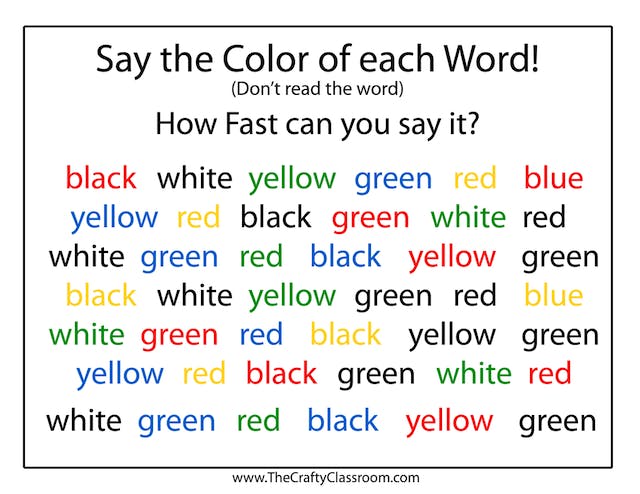
Image source: The Crafty Classroom
Benefits of brain teasers for kids
You know your students enjoy them, but did you know there are plenty of additional reasons to make brain teasers a regular activity in the classroom?
A study on the attention spans of six-year-olds found children who were given brain teasers were more attentive than those who were not — showing brain teasers were effective at boosting children’s attention spans.
Brain teasers for kids can also:
- Strengthen problem solving and critical thinking skills
- Encourage lateral thinking and build new perspectives
- Improve cognitive abilities like memory and processing speed
- Inspire teamwork and communication
- Engage students and motivate them to learn
- Provide necessary breaks from traditional class work
How to use brain teasers in the classroom
In addition to their many learning advantages, brain teasers are a great way to break up the day and engage your students. Here are just a few ways you can use brain teasers for kids as a teaching strategy and maximize the benefits in your classroom:
- Engagement-boosting activity before or after lessons
- Bonus questions in assignments and tests
- Optional “free time” activity
- Encourage team building — split students into groups to solve them together
- Supplement lessons — choose brain teasers about the subject you’re teaching
Final thoughts on brain teasers for kids
No matter what subject or skill you want to focus on, a brain teaser is a great addition to traditional teaching methods. Plus, it’s something students will actually be excited to do.
Remember that brain teaser are designed to be fun for kids. it’s not about finding the right answer, but the mental exercise they get from trying to find the solution.
Use any of the brain teasers in this list whenever you need a boost of energy in your classroom. Bonus points if you can stump any adults!
Create or log in to your free teacher account on Prodigy – a game-based learning platform for math that’s easy to use for educators and students alike. Aligned with standards across the English-speaking world, it’s used by more than a million teachers and 90 million students.
Fun and Engaging Coding for 6-Year-Olds - Discover the Joy!

Learning to code at a young age like 6-year-olds can help children develop important problem-solving, critical thinking, and creativity skills that can help them succeed in school and beyond.
However, teaching coding to young children can be challenging, especially for parents who have no experience in programming.
This blog aims to provide parents with useful tips, resources, and tools for teaching coding to 6-year-olds in a fun, engaging, and age-appropriate way.
From coding apps and websites to coding classes and books, this blog will explore the different ways in which young children can learn to code and the benefits that coding can provide for their future.
Table of Content
- What coding is for 6-year-olds?
Understanding Coding for 6-Year-Olds
Coding for 6-year-olds: resources for teaching.
- How to approach coding projects with 6-year-olds
What coding is for 6-year-olds?
Coding for 6-year-olds is an introduction to the concepts and language of programming.
It involves using visual blocks and simple commands to create animations, stories, and games.
At this age, coding is a fun and creative way for kids to learn problem-solving skills and computational thinking, setting them up for future success in a technology-driven world .
i) Coding concepts and tools
When it comes to coding for 6-year-olds, it's important to use age-appropriate concepts and tools that will engage and challenge them without overwhelming them.
By using age-appropriate concepts and tools, coding for 6-year-olds can be made fun and engaging, setting them up for success as they continue to learn and grow.
Here are some examples:
1. Visual blocks: Programs like ScratchJr and Kodable use colourful, drag-and-drop blocks to introduce coding concepts like sequencing, loops, and events in a fun and easy-to-understand way.
2. Games and stories: Many coding tools designed for young children use games and storytelling to introduce coding concepts.
For example, in ScratchJr, kids can create interactive stories and games using their own characters and backgrounds.
3. Unplugged activities: Not all coding activities need to be on a computer or tablet.
Unplugged coding activities, such as coding with blocks or creating algorithms with physical objects, can help kids develop computational thinking skills without relying on technology.
4. Simple coding languages: As kids get older, they can start learning coding languages like Python or JavaScript.
But coding for 6-year-olds, it's best to stick with simple coding languages like Scratch or ScratchJr, which use block-based coding instead of text-based coding.
ii) How to make coding for 6-year-olds fun and engaging ?
Making coding for 6-year-olds fun and engaging is key to keeping them interested and motivated. Here are some tips:
1. Start with familiar concepts: Introduce coding concepts that are familiar to kids, like storytelling or drawing, to help them understand how coding can be used to create things they enjoy.
2. Make it hands-on: Use tangible objects or toys to teach coding concepts. For example, use blocks or Legos to teach sequencing and loops.
3. Let them be creative: Encourage kids to be creative with their coding projects, allowing them to come up with their ideas and designs.
4. Use games and challenges: Incorporate games and challenges into coding activities to make them more interactive and engaging.
5. Make it social: Coding can be a group activity, so encourage kids to work together and share their projects with each other.
6. Celebrate successes: Celebrate kids' successes and progress to build their confidence and motivate them to keep learning.
iii) Benefits of teaching coding for 6-year-olds
By teaching coding for 6-year-olds, parents and educators can help prepare children for a bright future by developing essential skills that will serve them well throughout their lives.
1. Developing problem-solving skills: Coding involves breaking down problems into smaller parts and finding solutions.
This helps children develop their problem-solving and critical thinking skills.
2. Enhancing creativity: Coding encourages children to use their imaginations and creativity to create something unique.
3. Building computational thinking skills: Learning coding helps children develop computational thinking skills, which involves breaking down large problems into smaller, more manageable parts.
4. Preparing for the future: In today's technology-driven world, coding skills are becoming increasingly important.
Teaching coding to children at a young age can help prepare them for the future job market.
5. Improving maths skills: Coding involves using maths concepts such as sequencing, patterns, and logic.
This helps children develop their maths skills in a fun and engaging way.
6. Boosting confidence: Learning to code and creating their own projects can help children feel a sense of accomplishment and boost their confidence.
7. Developing persistence and resilience: Coding for 6-year-olds can be challenging at times, but learning to persist and try again when things don't work out teaches children valuable life skills that can be applied to other areas of their lives.
i) Best coding apps and websites to teach coding for 6-year-olds
1. jetlearn .
Ages: 6-16 years
Platform: iPad & Android tablet
JetLearn offers a range of coding courses for kids aged 5-16, with a visual block-based interface such as Scratch as well as coding languages like Python and JavaScript.
JetLearn's courses are designed to be fun and engaging, with interactive games and puzzles to help kids learn programming concepts.
2. ScratchJr
A free app designed for kids aged 5-7, ScratchJr allows children to create their own interactive stories and games using colorful, drag-and-drop blocks.
3. Kodable
Platform: iOS
This app uses fun characters and games to teach kids aged 4-10 the basics of coding.
The app features a visual block-based coding interface and introduces concepts like loops and conditionals.
4. CodeSpark Academy
Ages: 5-10 years
Designed for kids aged 5-10, CodeSpark Academy offers a range of activities and games to teach coding concepts like sequencing, loops, and conditionals.
The app uses a visual block-based coding interface.
5. Lightbot
Ages: 4-13 years
Platform: iOS and Android Platforms
This app features a cute robot character that kids can program to solve puzzles and complete challenges.
The app teaches concepts like sequencing, loops, and procedures.
6. Scratch
Ages: 8-16 years
Platform: Android Platforms, most laptops and desktop computers
While not specifically designed for young children, Scratch is a popular visual block-based programming language used by many kids aged 8 and up.
The Scratch app allows children to create their own interactive stories, games, and animations.
7. Code.org
Platform: Desktop computers, laptops, and tablets with internet access
Code.org offers free coding courses for kids aged 4-18. The courses use visual block coding and real coding languages like Python and JavaScript to teach programming. Code.org also offers free Hour of Code activities for kids.
8. NASA STEM Club Class
Platform: A mix of in-person and online formats
The NASA STEM Club Class is a program designed to inspire and engage young students in STEM subjects.
The program offers a range of activities and resources to help students learn about space exploration, robotics, and other STEM topics.
The NASA STEM Club Class provides a series of monthly challenges for students to complete, with each challenge focusing on a different aspect of STEM education.
9. CodeSpark Academy
Ages : 5-10 years
Platform : iOS
An app that combines storytelling with puzzles to teach logical thinking and the basics of coding through the adventures of the Foos.
Ages: 6-10 years
Platform : iPad & Android tablet
A comprehensive app that allows kids to create apps and animations, and teaches Javascript, Swift, and Python.
11. Nancy Drew: Codes & Clues
Platform : iOS & Android
A narrative-based game that teaches coding by dragging visual blocks to solve mysteries and is designed to be engaging for girls.
A physical-digital learning platform where kids use actual blocks to code on a tablet, offering a hands-on approach to learning.
13. Dash and Dot
Platform: iOS and Android
Features coding robots that can be commanded with sounds and timers, offering a hands-on experience with technology and programming.
14. CodyRoby
Ages : 5-8 years old
Platform : Web-based
CodyRoby is a visual coding platform designed for young children. It uses a game-based approach to teach programming concepts in a playful and interactive way.
15. Daisy the Dinosaur
Ages : 4-7 years old
Platform : Available as an app for iOS devices.
Daisy the Dinosaur is an introductory coding app that features a friendly dinosaur named Daisy. It teaches basic programming concepts through simple challenges.
16. Hopscotch
Ages : 7+ years old
Hopscotch is a creative coding app that lets kids create their own games, animations, and stories using a visual programming language.
It encourages artistic expression alongside coding.
17. Bitsbox
Ages: 6-12 years old
Platform: Web-based, accessible on any device with a web browser.
Bitsbox provides monthly coding projects that teach kids how to build real apps. It offers a step-by-step approach to coding in JavaScript.
18. RoboZZle
Platform: Web-based and available as a mobile app for iOS and Android.
RoboZZle is a fun and challenging puzzle game that introduces programming concepts like functions and recursion. Players solve puzzles by writing code for robots.
19. CodaKid
Platform: Web-based, accessible on any device with a web browser
CodaKid offers coding courses and projects for kids, including game design and modding. It provides a more structured approach to learning coding.
20. PBS Kids ScratchJr
Ages : 4-8 years
Platform : Available as an app for iOS and Android devices.
PBS Kids ScratchJr is a child-friendly version of ScratchJr with characters from popular PBS Kids shows. It offers a fun way to learn coding basics while engaging with familiar characters.
How to approach projects with coding for 6-year-olds?
Working on projects with coding for 6-year-olds can be a fun experience for both the child and the adult involved.
Here are a few tips on how to approach coding projects with 6-year-olds:
1. Keep it simple: Start with simple coding concepts that the child can understand and work their way up from there.
Use visual block coding tools that allow the child to drag and drop code blocks to create programs.
2. Let the child take the lead: Encourage the child to come up with their own ideas and projects.
Let them explore and experiment with coding concepts in a way that interests them.
3. Be patient and supportive: Remember that coding can be frustrating, especially for young children.
Be patient and supportive, and encourage the child to persevere through any challenges they encounter.
4. Make it fun and engaging: Use games and puzzles to make coding fun and engaging for the child.
Incorporate the child's interests and hobbies into coding projects to make them relevant and interesting.
5. Work together: Collaborate with the child on coding projects, and involve them in every step of the process.
Celebrate their wins and learn from their mistakes together.
6. Celebrate progress: Coding can be a challenging subject, but it's important to celebrate the child's progress and accomplishments along the way.
Encourage the child to be proud of their work and to keep learning and exploring new coding concepts.
In conclusion, coding for 6-year-olds can be a fun and rewarding activity for young children, and can help them develop crucial skills like problem-solving, critical thinking, and creativity.
By starting with age-appropriate coding concepts and tools, and making coding projects engaging and fun, parents and educators can help children develop a love of programming and technology that can benefit them for years to come.
From coding apps and websites to coding classes, there are many resources available to help young children learn to code in a way that is accessible, engaging, and fun.
With patience, support, and encouragement, children can learn to code and develop valuable skills that can help them succeed in school and beyond.
- How can parents who have no coding experience themselves support their 6-year-old child in learning to code?
Parents can still support their child in learning to code even if they have no coding experience themselves.
They can start by exploring coding resources designed for young children, such as coding apps, books, and websites.
Additionally, parents can encourage their child's curiosity and creativity by asking them questions about their coding projects, providing them with materials to experiment with, and celebrating their accomplishments along the way.
- What coding languages are suitable for 6-year-olds to learn?
At the age of 6, children can start learning coding concepts using visual block-based programming languages such as Scratch, Blockly, and Kodable.
These languages allow children to drag and drop blocks of code, making it easy for them to create basic programs without typing any code.
- Can 6-year-olds take coding classes online?
Yes, there are online coding classes available that are designed specifically for young children.
These classes are often interactive and engaging, and provide students with a range of resources and support to help them learn coding concepts.
However, it's important for parents to ensure that the online coding classes they choose are age-appropriate and safe for their child to participate in.

Sign up for a trial class and let your child explore the world of coding!
Want a trial coding class for your child?
Parents' Guide to Coding for Kids: The Success Mantra 2024
.png)
STEM Education: Inspire Innovation through Key Trends in 2024
.png)
Exploring the World of Scratch Sprites: Tips and Tricks 2024
Start learning with us, teach your child coding, ai and robotics.
Give your child the gift of a bright future by providing them with in-demand tech skills. Take a trial class today.
Sign up for a free trial class

Introduce your child to the exciting world of Coding, Artificial Intelligence and Robotics with our interactive free trial class. Unlock their potential and ignite their curiosity.
My 8 year old son is coding independently! With JetLearn, he has developed increased concentration, computer & english language skills, and logical reasoning abilities.

Helping Your Baby Reach Greater Wonders
25 Cognitive Activities for Toddlers to Boost Development

- Your child’s brain grows the most during toddlerhood than during any other time of their lives.
- There are many factors that affect cognitive development—genes, relationships with caregivers, screen time, nutrition, sleep, learning disabilities, physical activity and environment.
- There are certain cognitive milestones your toddler should reach by the time they are three years old.
- There are many fun cognitive activities to help your child reach their milestones.
Do you feel like crying when your toddler asks you to sing the same song you’ve been singing for the past hour? Do you want to hide the book you’ve read three times a day for the past month?
I have good news for you! Every time you sing or read to your child, you’re boosting their cognitive development! This may be of little comfort to you when you’re on your tenth rendition of “Itsy Bitsy Spider,” but once you learn how important toddler cognitive skills are, you’ll muster up the strength to sing until your voice is hoarse.
If you need a break from singing, there are tons of cognitive activities for toddlers that you can do to boost their development!
All About Your Toddler’s Cognitive Development
Cognitive development refers to how children think, develop fluid reasoning , explore, gain knowledge and problem solving skills, and learn more about the world around them.
As toddlers develop cognitive skills, their memory, attention, adaptability, understanding of cause and effect, language skills, intelligence, and critical thinking improve.
Toddler cognitive development is hugely important in laying the groundwork for these skills. It was highlighted in a 2021 article published by the University of Minnesota that by three years of age, a child’s brain is already 80% developed!
While your child is still in their toddler years, you have the perfect window to develop their cognitive skills. Since most brain growth and connections happen in the first three years of a child’s life, it is more difficult for children to develop their cognitive skills later in life. Even early literacy skills can be gained through cognitive activities for toddlers.
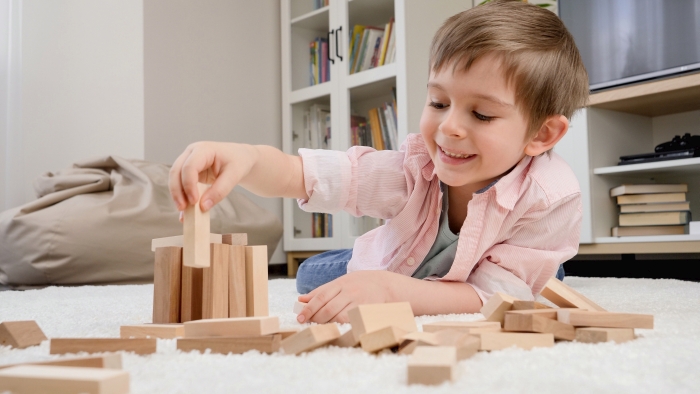
Factors That Can Affect Cognitive Development During Toddlerhood
You’ve probably heard the term “nature vs. nurture.” Nature refers to the genes our children inherit from us, and nurture refers to our children’s experiences, interactions with others, and general upbringing.
When it comes to cognitive development in toddlers, both nature and nurture affect their cognitive abilities.
Our genes are out of our control, but they are only one piece of the puzzle. There are many other factors within our control that promote cognitive development during toddlerhood, including:
- Warm, affectionate, positive interactions with dependable caregivers
- Limited screen time with exposure to cognitive toys
- Early intervention for children with learning disabilities
- Good nutrition with balanced meals and vitamin supplements if necessary to aid in brain development
- Quality sleep to help the brain remember information
- Physical activity, especially outdoors, improves cognitive skills
- Limited exposure to chronic, toxic stress (neglect, abuse, certain types of punishment and unreliable caregivers)
- A physically safe environment with head protection to prevent brain injuries during falls
- Limited or no exposure to toxins such as lead
- Vaccinations to protect against infections, including those that prevent brain swelling
What Are the Cognitive Developmental Milestones for Toddlers?
Every child develops at their own rate, but these are some of the cognitive developmental milestones you can expect in early childhood:
From 1 to 2 Years
- Tries to imitate adults
- Points out familiar objects in picture books
- Understands the difference between “me” and “you”
- Knows what everyday items are used for
- Points to items to get attention
- Pretend plays with dolls or stuffed animals (i.e. pretending to feed them)
- Points to one body part
- Scribbles independently
- Follows 1-step directions
- Puts things in containers and takes them out
- Has memories of past events
- Recognizes familiar people by name
- Finds easily hidden objects
From 2 to 3 Years
- Imitates more advanced adult actions like washing dishes or doing laundry
- Names objects, colors, animals, and letters in picture books and everyday life
- Sorts objects by category
- Stacks rings on a peg in size order
- Understands their own reflection in a mirror
- Finds things even when hidden under two or three covers
- Completes sentences or rhymes in familiar stories
- Plays make-believe games (pretend play)
- Builds towers of at least four blocks
- Follows two-step directions (e.g. “Pick up your toy and put it in the bin.”)
- Finishes puzzles with 3-4 pieces
- Draws a circle after watching an adult draw it
3 Years Old
- Helps get themselves dressed
- Knows their name, age, and gender
- Follows step-by-step directions
- Uses buttons, levers and moving parts on toys
- Does imaginative play (e.g. pretends they are a dog or makes up stories for their dolls)
- Builds towers of more than six blocks
- Screws and unscrews lids or turns door handles
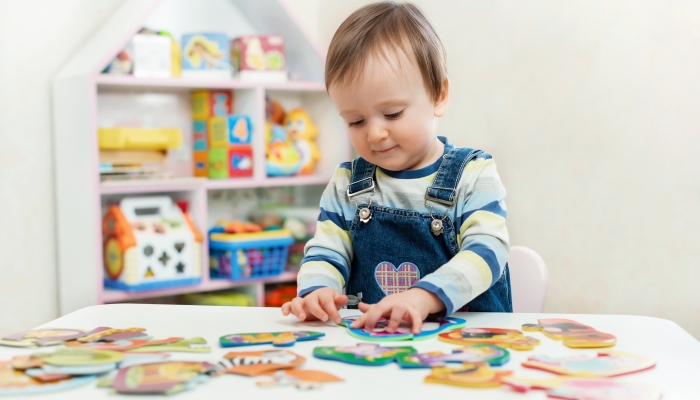
What Can You Do to Boost Your Toddler’s Cognitive Development?
Play is key! Toddlers learn the most from playing, and your job is to support that play. This means exploring with your child, playing with them when appropriate and giving them space for independent play when needed.
As your child is playing, describe new objects they encounter and ask questions about what they’re doing. When it comes to play, your toddler is the leader, and you’re there to make sure they’re getting the most out of it.
During play, refrain yourself from helping your toddler too much. Instead, give them tips for what they might try when they get frustrated.
There are many different types of play you can organize for your toddler—free play, pretend play, outdoor play, play with cognitive activities and toys (cause-and-effect toys, matching games , sorting games, categorizing games, puzzles), and social play with other children. Each type of play is beneficial to toddler cognitive development and should be encouraged.
Also, spend some time focusing on vocabulary and language skills. Use a variety of words when interacting with your toddler. Sing songs and nursery rhymes together and read to them often. Most importantly, show patience and warmth when responding to your toddler.
If you’re concerned with your toddler’s cognitive development, talk to a doctor or therapist to see if early intervention is needed.
25 Fun Cognitive Activities for Toddlers
Providing quality cognitive activities for toddlers may have you feeling overwhelmed. We’ve got you covered with fun cognitive development activities that will boost your toddler’s development and keep you both smiling along the way!
- Provide wooden blocks for stacking and building.
- Go on a scavenger hunt looking for specific things (things that start with a certain letter or are a certain color).
- Provide a bucket of soapy water and sponges outside to wash toys with.
- Go on a treasure hunt outside (collect acorns, rocks, leaves, etc.) and have them make art with their treasures.
- Play games to practice following directions like “Follow the Leader” or “Simon Says.”
- Throw rocks into a body of water and predict how big the splashes will be.
- Let them pretend play with kitchen utensils.
- Write letters on post-its and have your toddler stick them to objects whose names begin with each letter.
- Make animals out of playdough with your child.
- Let them match their socks or sort their toys by color.
- Go outside and try to figure out which direction the wind is coming from.
- Gather items and have your toddler sort them based on color, category, shape, etc.
- Provide matching games and puzzles .
- Draw a simple picture and then cut it into a few pieces. Have your toddler put the pieces back together.
- Practice counting throughout the day—how many stairs they go up or down, how many times they go down the slide at the park, how many cheerios they eat, etc.
- Cook with your child to teach them how to follow directions, measure, and learn numbers.
- Cut post-its into shapes and have your child stick them to objects they find that match each shape.
- Go outside during each season and make notes of what you hear, see, feel, and smell.
- Create an art box with scrap paper, crayons, markers, and other materials and let them have free time to create.
- Sing songs and come up with actions to do during each song that your toddler can imitate.
- Take your toddler to a local children’s museum, a local farm, library, or even the grocery store to provide for exploration. Ask questions while you both explore.
- Have other children come over for playdates to help with social skills.
- Look in the mirror with your child and have them make faces to show different emotions. Playing with mirrors helps children develop their self-image and learn nonverbal cues.
- Bury treasures (small toys, rocks, acorns, etc.) in sand or wood chips outside and have your child find them.
- Add fun containers to the bath for pouring, measuring, and experimenting with which items float and which items sink .
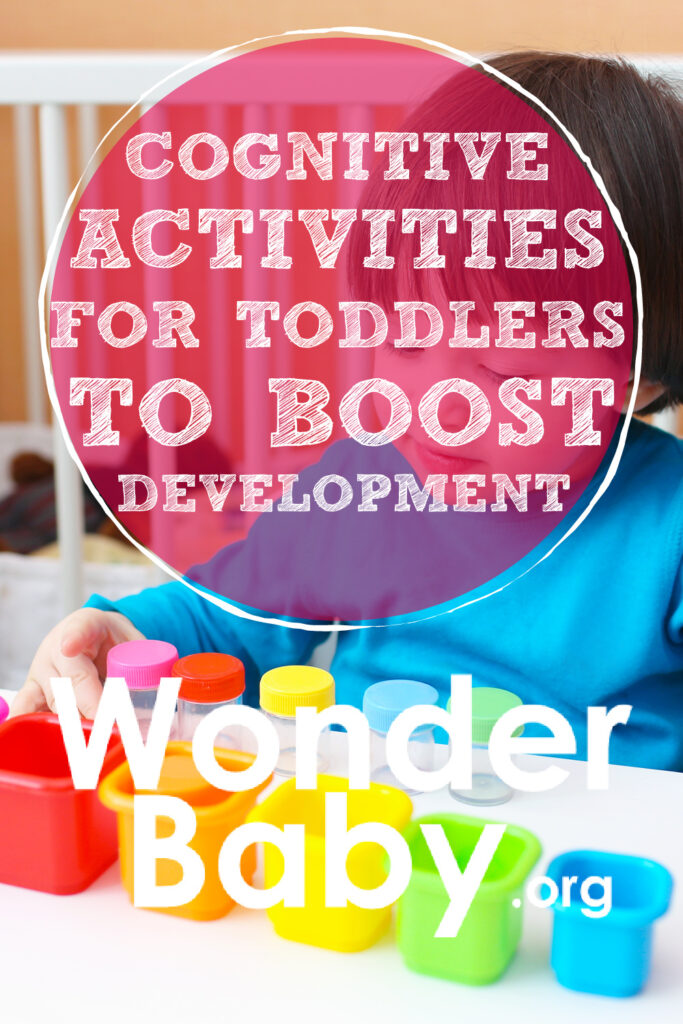
Related Posts
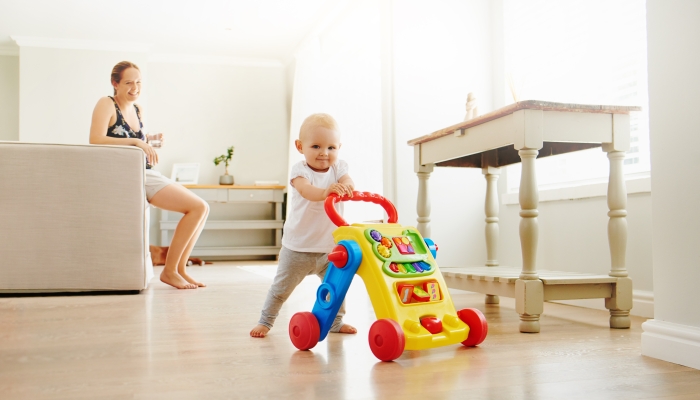
Fine and Gross Motor
Are Push Walkers Bad for Babies?
Push walkers were created to help babies learn to walk. However, research shows that walkers may actually slow your baby’s progress.
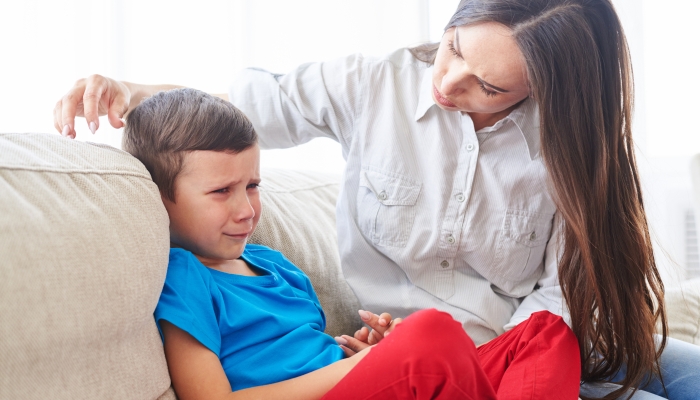
Development
How Fearful Avoidant Attachment Develops in Childhood
Is your child struggling with emotional regulation, incongruent behaviors, and boundaries with strangers? Fearful avoidant attachment may be to blame.

Development, Parenting
Distal and Proximal Parenting: Understanding the Difference
Understanding the history, differences, and strengths of proximal and distal parenting will help you decide what parenting approaches work best for your family.

- May 19, 2010
Supporting Thinking Skills From 0-12 Months

It’s through interactions and experiences with loved and trusted adults that babies begin to make sense of the world. Learn how you can support your baby’s thinking skills from 0-12 months.
Babies learn by using their senses. They explore and discover by touching and mouthing objects, hearing voices and music, and seeing the colorful, fascinating wonder all around them. But the most important part of your child’s early learning experiences is you. It is through interactions and experiences with loved and trusted adults that babies begin to make sense of the world.
In this first year, babies are learning very important concepts. They learn about cause and effect when they shake a rattle and hear a sound, or when they pull on their mother’s glasses and hear her voice (much sterner than usual) tell them not to pull! They learn about size and shape by stacking blocks, mouthing them, and trying to fit them into the correctly-shaped holes. They learn to solve problems when they discover how to turn the crank to get the jack-in-the-box to pop up. They learn about gravity when they drop a spoon from the high chair and look down to the floor to see where it lands. They learn object permanence—that things they can’t see still exist—when they play peek-a-boo or crawl into the next room to find you.
Encourage your baby to explore.
You will see your baby act on her natural curiosity about the people and objects around her as she:
- Looks carefully at your face
- Inspects her hands, fingers, feet and toes
- Rolls to get closer to a person she wants to connect with or to an interesting object
- Babbles and then waits for your response
- Looks at and reaches for objects that interest her.
- Responds to familiar words like baba, mama, dada, night-night, teddy bear, etc.
Your baby’s curiosity reflects a desire to figure out how the people and objects in his world work. You will see your child’s curiosity in action as he:
- Touches his fingers and toes
- Bangs and shakes objects to see what they can do
- Pulls on long hair or earrings
- Uses sounds, facial expressions and gestures to get your attention
- Puts things in his mouth
- Watches things move
- Follows interesting sounds with his eyes
These actions help babies learn and build their confidence that they can “make things happen.” When children know they can have an impact on the people and objects around them, they feel confident and competent, which is a key part of developing positive self-esteem. In this way, thinking skills and social-emotional skills are tied together.
What you can do:
- Offer interesting objects to explore—fabrics of various textures, a ball of sticky masking tape, a wooden spoon and a metal one to touch and compare.
- Respond to her efforts to communicate. Use words to describe what she is experiencing: I see you looking at that ball on the shelf. Let me get that for you.
- Delight in their discoveries. You found your hands! Look what they can do. You can use them to reach that red ball.
- Provide the help your child needs to solve problems, such as showing your baby how to get the lid off the container so she can reach the blocks inside. But before you jump in, give her a chance to do it herself first.
Support your baby’s growing memory and ability to understand new ideas. You will see your baby’s memory develop as she:
- Recognizes familiar people
- Anticipates routines, for example, grabbing her “blanky” for naptime or crawling to the high chair when she sees you preparing food
- Responds (turning/smiling) when she hears her name spoken
- Shows pleasure when given a familiar object like a favorite book of her “lovey”
Your baby’s growing memory also helps her learn that objects and people still exist even when he can’t see them. This concept is called object permanence. You will see this new skill developing when your baby starts to look for hidden objects. This is because he remembers the object and knows it is still around…somewhere. He may also begin to protest when you leave him with a caregiver, even one he knows and loves. This is because he knows you are out there somewhere and naturally, he wants to make you come back!
During this first year your baby is also learning about the concept of cause and effect—that he can make things happen. When he shakes the rattle it makes a sound. When he bats at the mobile it moves. When he cries out for you, you come. Learning to make things happen is the foundation for solving problems. I want dad’s attention. What can I do? I will crawl to him and pull on his leg to let him know I want him to play. Young babies show you how they are now able to make things happen when they:
- Cry when they need something
- Drop food off a high chair tray, look down to the floor to see where it goes, and look for you to come pick it up
- Enjoy repeating a new activity (like pressing a button to see a toy pop up)
- Reach for a rattle to shake it and make a sound
- Play disappearing and reappearing games. Play peek-a-boo. Make a simple game of hiding objects to find. This helps develop your child’s memory and teaches him about object permanence.
- Encourage your child to explore objects and toys in different ways. Touching, banging, shaking, and rolling help children learn about how things work. Talk with your child about what he is doing. “You got the truck to move by pulling the string!”
Help your baby become a good problem-solver.
Babies learn to solve problems by examining and learning about new objects and people they encounter. Then they apply what they have learned to new situations. For example:
- A 7-month-old has figured out who she knows and who she doesn’t. So she holds her arms out so you will pick her up, but buries her head in your chest when a new person tries to talk to her.
- An 11-month-old waves bye-bye when her dad puts her in the crib for the night. This is after seeing her parents wave bye-bye to her many times when they leave for work.
Problem-solving is a critical thinking skill that helps babies be successful now, later in school, and the rest of their lives. In the beginning, the problems babies solve seem simple: How do I make the tambourine rattle? How do I make the jack pop up out of the box? But figuring out the answer to these dilemmas requires a lot of thought and trial-and-error. When they are successful, children feel confident and proud, which motivates them to explore and learn more from the people and world around them.
- Provide support for reaching goals. Watch your baby carefully. See what she is trying to make happen and help her solve the problem. If she is trying to roll over to reach an interesting object, encourage her to go as far as she can and then bring it close enough that she can get it and explore it.
- Model problem-solving. Take the top off the container and take the blocks out. Then put them back in and let her have a try. Young children learn a lot through imitation.
Explore differences in objects
One of the strategies babies use to figure out how the world works is by putting objects into categories. They notice similar features even among very different objects. A flower, a rattle, and grandpa’s nose are all very different, but they all can be grasped. Babies also notice differences among similar objects. If they are given a piece of furry fabric and a piece of rubber that are the same size, shape and color, babies will pat the fur and squeeze the rubber. This shows they have some idea about how these textures will feel and “should” be touched. (Berger, 166)
- Take “touching” walks. On your walks together, hold your baby’s hands up to a bumpy tree trunk. Crinkle a leaf and let her listen. Give her a flower petal to touch, or run her hand over tickly grass. Stop and listen together to the cars going by. Talk about what you are seeing and doing.
- Look at books that put objects into categories. While your baby won’t be able to understand how to sort objects yet, activities like these will help her build this skill over time.
Make everyday activities “teachable moments.”
Children learn so much during daily routines likes feeding, diapering and bath time. For example, during bath time, babies get to explore math and science concepts like empty/full, in/out, wet/dry. Filling and dumping cups help children learn about empty and full, and in and out. When your child makes the rubber duck splash in the tub, she learns about cause and effect. When the duck stays on top of the water but the washcloth sinks, she is learning about floating and sinking.
What You Can Do:
- Make the most of daily routines. Let your baby help drop clothing into the washing machine. Hand her groceries she can put on the conveyer belt. Sing a song about body parts as you change her diaper. These routine activities are not-so-routine for your growing baby. They teach her how things work.
- Give your child some everyday “toys”. See how a wooden spoon and a whisk make very different sounds when tapped on a pot lid. Pull a scarf through a cardboard paper towel tube to make the scarf appear and disappear. Let your child feel the difference between the brush used on her hair, and the spiny teeth of the comb. Activities like this give your child the chance to discover the properties and functions of objects, an important part of problem-solving.
What You Can Do
Offer interesting objects to explore.
Such as fabrics of various textures, a ball of sticky masking tape, a wooden spoon and a metal one, smooth balls and bumpy balls.
Respond to her efforts to communicate.
Use words to describe what she is experiencing: I see you looking at that ball on the shelf. Let me get that for you.
Delight in your child’s discoveries.
You found your hands! Look what they can do. You can use them to reach that red ball.
Provide the help your child needs to solve problems
Such as showing your baby how to get the lid off the container so she can reach the blocks inside. Give her a chance, though, to see if she can do it by herself first.
Play disappearing and reappearing games.
Play peek-a-boo. Make a simple game of hiding objects to find. This helps develop your child’s memory and teaches him about object permanence.
Encourage your child to explore objects and toys in different ways.
Touching, banging, shaking, and rolling help children learn about how things work. Talk with your child about what he is doing. You got the truck to move by pulling the string!
Provide support for reaching goals.
Watch your baby carefully. See what she is trying to make happen and help her solve the problem. If she is trying to roll over to reach an interesting object, encourage her to go as far as she can and then bring it close enough that she can get it and explore it.
Model problem-solving.
Take the top off the container and take the blocks out. Then put them back in and let her have a try. Young children learn a lot through imitation.
Take “touching” walks.
On your walks together, hold your baby’s hands up to a bumpy tree trunk. Crinkle a leaf and let her listen. Give her a flower petal to touch, or run her hand over tickly grass. Stop and listen together to the cars going by. Talk about what you are seeing and doing.
Make the most of daily routines.
Let your baby help drop clothing into the washing machine. Hand her groceries she can put on the conveyer belt. Sing a song about body parts as you change her diaper. These routine activities are not-so-routine for your growing baby, as she learns how things work and begins to imitate the activities of the people she loves.
Give your child some everyday “toys”.
See how a wooden spoon and a whisk make very different sounds when tapped on a pot lid. Pull a scarf through a cardboard paper towel tube to make the scarf appear and disappear. Let your child feel the difference between the brush used on her hair, and the spiny teeth of the comb. Activities like this give your child the chance to discover the properties and functions of objects, an important part of problem-solving
Parent-Child Activities that Promote Thinking Skills
Create an obstacle course..
Lay out boxes to crawl through, stools to step over, pillows to jump on top of, low tables to slither under. Describe what your child is doing as he goes through the course. This helps him understand these concepts.
Play red light/green light.
Cut two large circles, one from green paper and one from red. Write “stop” on the red and “go” on the green, and glue them (back to back) over a popsicle stick holder. This is your traffic light. Stand where your child has some room to move toward you, such as at the end of a hallway. When the red sign is showing, your child must stop but when she sees green, she can GO. Alternate between red and green. See if your child wants to take a turn being the traffic light.
Build big minds with “big blocks”.
Gather together empty boxes of all sorts—very big (like a packing box), medium-sized (shirt or empty cereal boxes), and very small (like a cardboard jewelry box). Let your child stack, fill, dump and explore these different boxes. Which can he fit inside? Which are the best for stacking? Can he put the big boxes in one pile and the small boxes in another?
Make a puzzle.
Make two copies of a photo of your child. Glue one of the photos to sturdy cardboard and cut it into three simple pieces. Put the puzzle together in front of your child. Show her the uncut photo. Put them side by side. Wait and watch to see what she will do. Eventually, she will touch or move the puzzle. With your guidance and help, is she able to put it back together?
Frequently Asked Questions
My 18-month-old is obsessed with our remote control. why does she always go back to it, even when i try to distract her with other toys.
Such is the way with toddlers: Their most frustrating behaviors are often both normal and developmentally appropriate. At this age, your child is working very hard to make sense of her world. One of the most important ways she does that is by watching and then imitating what you do. You are her first and most important teacher. She sees you say “thank you” to the grocery clerk so she learns to say “thank you” too. She watches you sweep the floors and she picks up a broom to help. Unfortunately, you can’t turn this desire to imitate on and off. So when your child sees you touching the remote control, she wants to touch it, too. After all, it must be a good thing if you’re doing it!
Why do children love electronics so much?
You’ll notice that many toys designed for children this age have features they can explore through touch, such as buttons and raised textures—just like most electronics. However, toddlers almost always prefer to play with the real life objects they see you using which is why they go for remotes, cell phones, etc. Toddlers are learning that to be successful, they need to find out how things work. And electronics make for very interesting props. After all, playing with buttons on the remote offers the exciting possibility that–poof!–the magical machine will come alive. Think of how empowering and exciting this is for your child. But it can also drive you crazy! So now is the time to make sure that all “off-limits” electronics are child-proofed or kept out of the way of little hands. However, be sure to offer your child other objects or toys with buttons and other gadgets that he can make work.
How can I get my toddler to stop going for off-limits objects?
Unfortunately, toddlers simply lack the self-control necessary to resist the wonderful temptation of electronic gadgets and other off-limits items (like shiny picture frames or pointy plugs that fit so nicely into those holes in the wall). While toddlers can understand and respond to words such as “no”, they don’t yet have the self-control to stop their behavior, or to understand the consequences if they don’t. Patience is important, since after telling your toddler 20 times not to play with the remote, chances are she’ll still go for it again. Most children don’t even begin to master controlling their impulses until about age 2 ½.
If the object your child is after isn’t likely to pose a danger to him (such as a remote control–although the batteries are a danger if she puts them into her mouth), the decision of how to set limits is yours. Some parents choose to keep all of these gadgets out of reach and don’t allow their children to touch them until they are older. Or, you could allow your child to use them under your close supervision, such as having your child turn the TV on when you’re planning to watch a show and turning it off when you’re through. This models for your child that there are times when using this equipment is okay and times when it’s not.
What’s most important is that you recognize your child’s needs (learning cause and effect, imitating you) and help her meet them in ways that are acceptable to you.
My father recently died, and I’ve been dealing with it okay, but I’m not sure what to do concerning my 20-month-old. When we go to my parents’ house, she asks for Pop-Pop and we tell her he’s not home. However, I can’t keep doing this. I don’t want her to forget her grand-dad, but how can you explain to a baby that someone has died?
This must be a difficult time as you cope with your own feelings and try to make sense of it all for your young child. Helping her understand what has happened to Pop-Pop is indeed a challenge, as 20-month-olds can’t comprehend the idea of death, or even that they will never see someone again. At the same time, children are very tuned in to the feelings of the important adults in their lives, so it is likely that your child, no matter how well you’re handling your Dad’s death, understands that something sad has happened. It is important that what she is sensing is acknowledged.
Since a 20-month-old can’t understand death, trying to explain it to her would probably cause her more confusion and anxiety. Instead focus on addressing her feelings. What’s most important for your daughter at this time is for you to say something like, “Pop-pop isn’t here. I miss him too.” At this time she won’t be able to understand more.
As your child gets closer to 3, she will likely start to ask questions about what happened to her grandfather. You can then explain that Pop-pop is not coming back; that he died, which means that his body stopped working. Tell her this happens when people are very old or sick and doctors and nurses can’t make their bodies work anymore. You can explain that Pop-pop couldn’t do things like eat or play outside anymore. This gives her a context she can relate to. If she asks whether Pop-pop will ever come back, you should tell her the truth–that he won’t. If your child asks whether you or she or others that she loves will die, you can explain that your bodies are healthy and strong so you are not going to die now.
How should I answer my child’s questions about where her Pop-pop is?
Answer your daughter’s questions based on what you think she can understand. Start with something along the lines of: “Pop-pop isn’t here. I miss him too.” As your child gets older and her questions get more mature, your responses will change accordingly until you feel you are ready to tell her: “Pop-pop died. That means that his body stopped working and the doctors and nurses couldn’t make him better.”
Keep your responses brief. A mistake many parents make is giving more information than their child can process. On the other hand, some parents are tempted not to talk about a deceased person for fear that it will upset the child or themselves. But, of course, avoiding the topic doesn’t make the memories or feelings go away. It just deprives your child of the opportunity to make sense of the experience.
How can I help her keep the memory of her grandfather alive?
When your daughter is old enough, share photos, tell stories, and draw pictures of Pop-Pop. You can also have her do something in your father’s memory. Send off a balloon that says, “I love you”. Or have her help you plant a rose bush, for instance, if her grandfather loved flowers. Reading books about loss can also be very helpful. Some good books include When a Pet Dies by Fred Rogers (Puffin, 1998), When Dinosaurs Die by Laurie Krasny and Marc Brown (Little Brown & Co., 1998), and About Dying by Sara Bonnett Stein (Walker & Co., 1985).
Does my toddler have a “short attention span” because she won’t sit for a story for more than a minute?
It is perfectly normal for toddlers to not sit still very long–period. Most don’t like to stay in one place for long now that they can explore in so many new ways– by running, jumping and climbing. So, an adult’s idea of snuggling on the couch to hear a story may not be the same idea a toddler has for story-time. You may only be able to read or talk about a few pages in a book at a time.
Here are some ways to engage active children in reading:
- Read a book at snack times when your child may be more likely to sit for longer.
- Offer your child a small toy to hold in her hand—such as a squishy ball—to keep her body moving while you read.
- Read in a dramatic fashion, exaggerating your voice and actions. This often keeps toddlers interested.
- Get your child active and moving by encouraging her to join in on familiar phrases or words, act out an action in the story, or find objects on the page. These “activities” can help their attention stay focused.
- Choose stories that have the same word or phrase repeated. The repetition helps toddlers look forward to hearing the familiar phrase again and also develops their memory and language skills. Encourage her to “help” you read when you get to this refrain.
- Try books that invite action on the part of the child, such as pop-up books, touch-and-feel books, and books with flaps and hidden openings for them to explore.
Browse our full suite of resources on early childhood development.

IMAGES
VIDEO
COMMENTS
Ages 5-6: By 5-6 years old, most kids can apply problem-solving skills in their everyday lives. They're also able to understand complex emotions and empathize with others. Ages 6-7: Around 6-7 years old, kids are usually able to understand even more complex emotions.
Children. Become able to understand the viewpoint of others: are aware that others can have different thoughts. Can focus on several aspects of a problem at a time. Can concentrate on what they do for longer periods of time. Increased problem-solving ability, but not yet like an adult. Can think of simple plans before acting.
15 Best Problem Solving Activities for Kids. 1. Rolling Dice. Things you'll need: A die or dice, some flashcards and a pen. How to do: You can play tons of different games with dice. Playing with two dice encourages kids to quickly add up numbers and learn math in a fun way.
Educators have designed these challenging and amazing brain games for clever kids to have fun while improving their problem-solving skills at the same time! Online Brain Games for Kids ... too. We put together some of the best examples learning games for 6 year olds, apps for 6 year olds, learning games for 4 year olds, and Educational Toys for ...
How to develop critical thinking. To develop critical thinking, here are 10 ways to practice. Ask probing questions: Ask "why", "how", "what if" to deeply understand issues and reveal assumptions. Examine evidence objectively: Analyze information's relevance, credibility, and adequacy. Consider different viewpoints: Think through ...
To teach your child how to solve a problem, you first need to delve into their hearts and minds before you address the problem itself. Here is a step-wise approach you need to follow to teach your kids the art of problem solving. 1. Identify the Emotion. Before you teach your child to problem solve critically, you must address the emotions that ...
4. Model problem-solving skills. Children learn by watching and imitating the behavior of adults around them. Therefore, modeling problem-solving skills is essential for promoting these skills in young children. Let your child see you working through problems, and encourage them to ask questions and offer suggestions.
2. Pretend play. Roleplaying is a fun way to expose your child to new experiences or situations in a safe, low-pressure setting. Join your child in creative play and gently guide them towards scenarios that require problem solving. For instance, if you're playing school, take on the role of a student who doesn't want to do the assigned ...
Once they are calm, help them brainstorm solutions by asking leading questions. Once they learn this process, you'll find that they tend to practice problem solving skills rather than throwing a tantrum. Problem Solving For Kids of 6 - 9 years. By the time they are six years old, kids learn to control their emotions better.
6-7. Children enter this period of development eager, creative, and curious. They are becoming more adept and creative in using their expanding knowledge of the world to engage in everyday problem solving. In this domain they continue to show relatively high levels of confidence and belief in their own abilities and skill level.
For example, impulsive 5-year-olds may hit or have tantrums when they don't get their way, while impulsive 14-year-olds may share inappropriate content on social media or engage in risky behaviors like drinking alcohol without thinking about the potential ramifications. ... Teach Problem-Solving Skills . Although brainstorming solutions sounds ...
Puzzles. Puzzles are fun and a great way to encourage cognitive development in children. They are great for spacial reasoning and strengthening problem-solving skills. They also develop memory skills, critical thinking, and the ability to plan and execute the plan. Toddlers will enjoy the simple puzzles, and preschoolers will do great with ...
Ages. 6-7. The time between 6 and 8 is one of tremendous cognitive change for children. They move from being preschoolers into middle childhood, from a life dominated by fantasy to one that is beginning to be governed by logic and reason. They start to see themselves as more autonomous individuals, capable of basic independent problem solving.
According to the Programme for International Student Assessment (PISA), which evaluated 15-year-old children in 44 different countries, more than one in six students in the United States are unable to solve critical thinking problems. ... How to Teach Kids Problem-Solving Skills. 2 Sources. Verywell Family uses only high-quality sources ...
Problem Solving Activities For Children Age 2-3. Sort objects by color, size, and shape. Help your child "write" his own book by writing his words while he or she draws the pictures. Teach the words; on, under, behind, around by playing games like Simon Says. Provide a "dress-up" box for your child for imaginative play.
Memory, Concentration, and Matching games are fun and easy activities for kids to play to encourage cognitive development. 11. Stroop effect games. Stroop effect activities involve reading a word written in a different color or saying the color of the ink and not the actual word. It requires focus and attention.
A yellow light means they're beginning to calm down. Green means they're ready to solve the problem. You can help your child come up with tools to calm down. They might splash some water on their face, take some deep breaths or play with a pet. When they're ready to focus, you can help them find the source of the conflict.
If you're reading a post about children's books that promote critical thinking, I assume you see the value in raising strong thinkers. Whether you're a caregiver, educator, or potential employer, you want society's children to develop complex reasoning and problem solving skills. These qualities benefit us all.
A study on the attention spans of six-year-olds found children who were given brain teasers were more attentive than those who were not — showing brain teasers were ... Brain teasers for kids can also: Strengthen problem solving and critical thinking skills; Encourage lateral thinking and build new perspectives; Improve cognitive abilities ...
The games and activities on this list are designed to help 6-year-olds learn new things, develop concentration and focus, improve problem-solving and logic skills, and boost memory and recall.
In conclusion, coding for 6-year-olds can be a fun and rewarding activity for young children, and can help them develop crucial skills like problem-solving, critical thinking, and creativity. . By starting with age-appropriate coding concepts and tools, and making coding projects engaging and fun, parents and educators can help children ...
Cognitive development refers to how children think, develop fluid reasoning, explore, gain knowledge and problem solving skills, and learn more about the world around them. As toddlers develop cognitive skills, their memory, attention, adaptability, understanding of cause and effect, language skills, intelligence, and critical thinking improve.
An 11-month-old waves bye-bye when her dad puts her in the crib for the night. This is after seeing her parents wave bye-bye to her many times when they leave for work. Problem-solving is a critical thinking skill that helps babies be successful now, later in school, and the rest of their lives.